Westell ULS3-C Dual Moca 4-Port Ethernet Wi-Fi Gateway User Manual UltraLine Series 3 User Guide Draft 1
Westell Inc Dual Moca 4-Port Ethernet Wi-Fi Gateway UltraLine Series 3 User Guide Draft 1
Westell >
Contents
- 1. Users Manual Part One
- 2. Users Manual Part Two
- 3. Users Manual Part Three
Users Manual Part Three
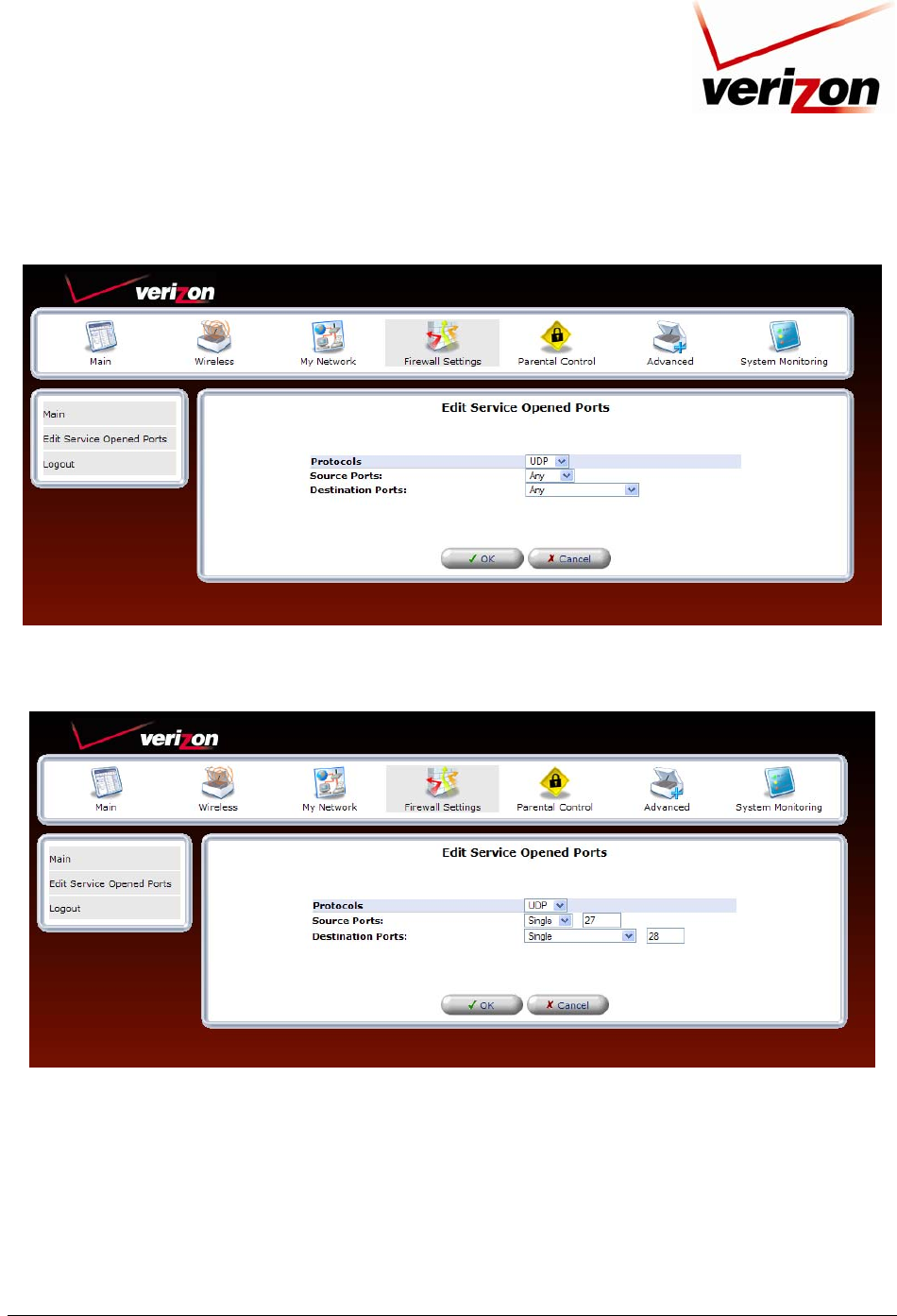
03/24/09 - DRAFT
030-300554 Rev. C 126 March 2009
Verizon FiOS Router
(
Model 9100EM
)
User Guide
For example, if you select UDP, the following screen appears. Select the desired source port and destination port
settings from the drop-down lists.
Next, enter the desired source and destination port values in the fields provided, and click OK to continue.
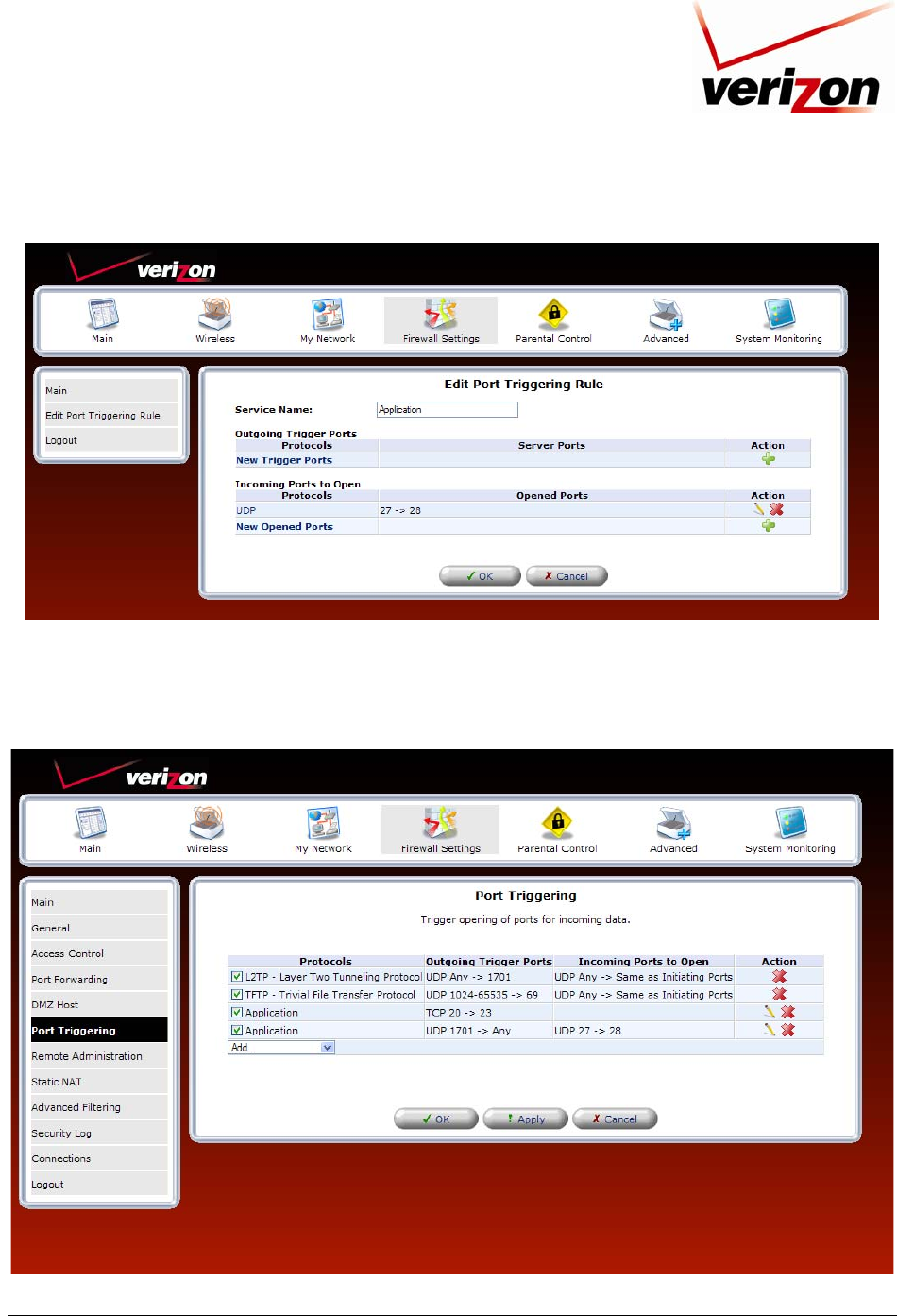
03/24/09 - DRAFT
030-300554 Rev. C 127 March 2009
Verizon FiOS Router
(
Model 9100EM
)
User Guide
If you clicked OK, the following screen appears. Click OK to continue.
If you clicked OK, the following screen appears. This screen shows that the triggering rule has been added to the list
of triggering services. Click Apply to save the settings. If you want to edit a rule, click the pencil icon next to the
rule that you want to edit. To delete a rule, click the “X” icon next to the rule that you want to delete.
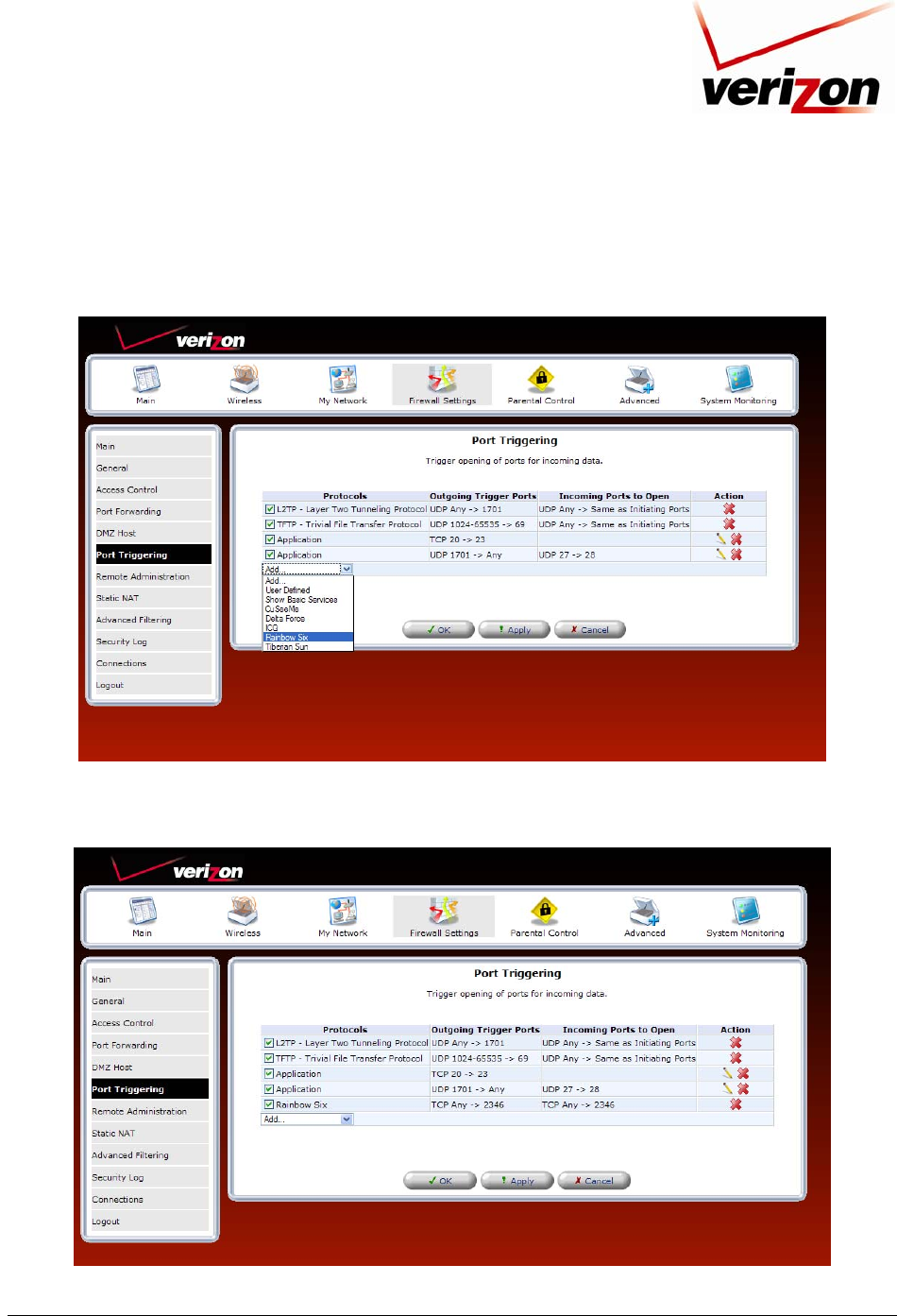
03/24/09 - DRAFT
030-300554 Rev. C 128 March 2009
Verizon FiOS Router
(
Model 9100EM
)
User Guide
13.5.2 Setting Up a Predefined Port Triggering Rule
To set up a predefined port triggering rule, in the Add drop-down list, select a predefined service.
After you have selected a service, the following screen appears. The service that you selected will be displayed.
Click Apply to save the settings.
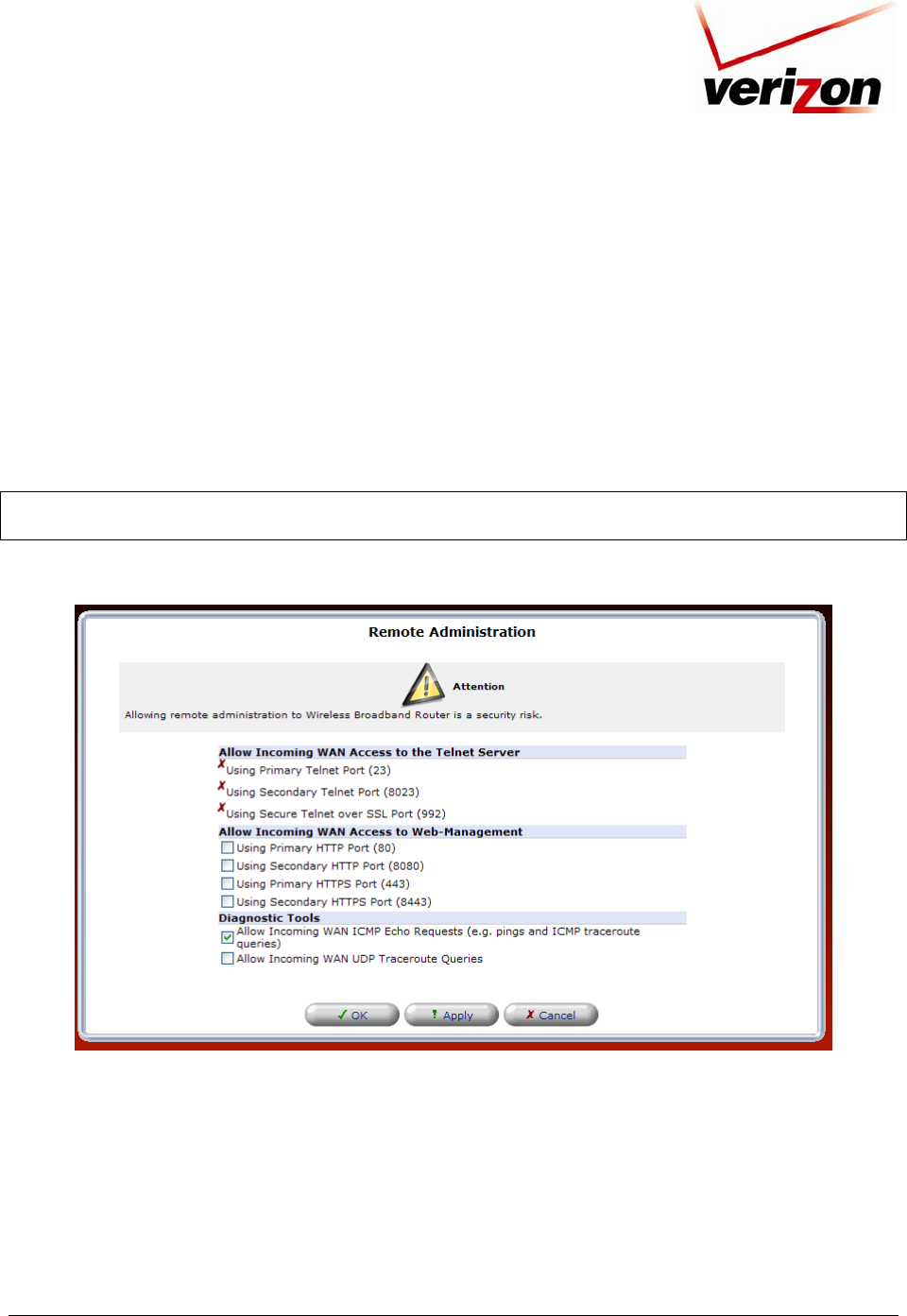
03/24/09 - DRAFT
030-300554 Rev. C 129 March 2009
Verizon FiOS Router
(
Model 9100EM
)
User Guide
13.6 Remote Admin
If you select Firewall Settings in the top navigation menu, and then select Remote Administration in the left
submenu, the following screen appears.
It is possible to access and control your Router not only from within the home network, but also from the Internet.
This allows you to view or change settings while traveling. It also enables you to allow your service provider to
change settings or help you troubleshoot functionality or communication issues from a remote location. Remote
access to your Router is blocked by default to ensure the security of your network. However, your Router supports
the following services, and you can use the Remote Administration screen to selectively enable these services if they
are needed.
WARNING: With Remote Administration enabled, your network will be at risk from outside attacks. Note that
remote command line access (Telnet) is not enabled on this Router.
To configure Remote Administration, enter the appropriate settings, and then click Apply to save the settings.
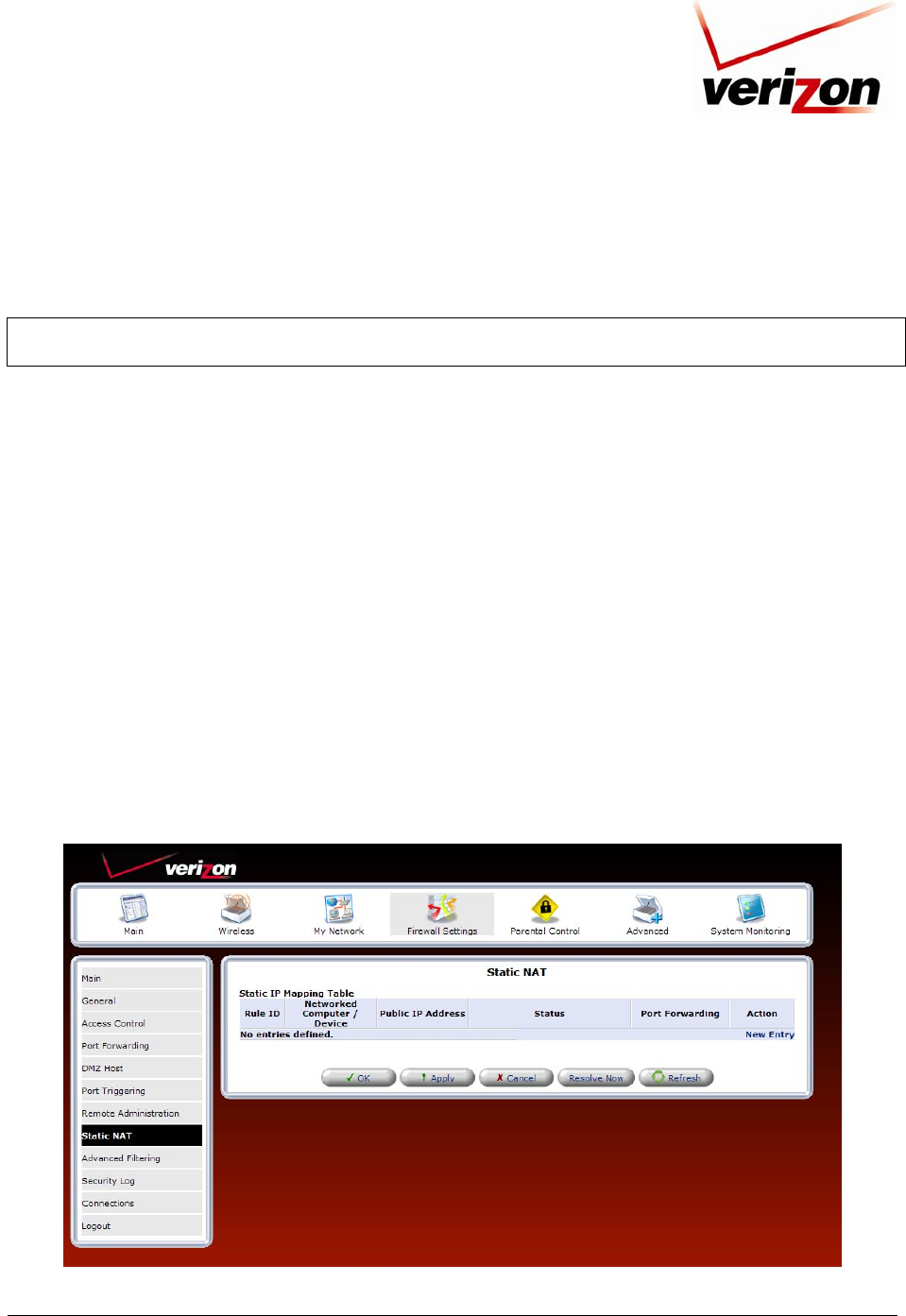
03/24/09 - DRAFT
030-300554 Rev. C 130 March 2009
Verizon FiOS Router
(
Model 9100EM
)
User Guide
13.7 Static NAT
If you select Firewall Settings in the top navigation menu and then select Static NAT in the left submenu, the
following screen appears.
NOTE: A block of static IP addresses must be purchased from Verizon to configure this feature. This Router
supports 253 static IP addresses.
Static NAT allows LAN devices to use public IP addresses (different from the Router’s public IP address). The LAN
devices are still configured with private IP addresses (either statically or dynamically through DHCP). Traffic
between the LAN devices and the Internet is still “NAT’ed,” but the Static NAT mappings allow packets from
specific devices to use a distinct public IP address; and packets sent to different public IP addresses to be forwarded
to specific devices.
With Static NAT, devices that are behind the firewall and that are configured with private IP addresses appear to
have public IP addresses on the Internet. This allows an internal host, such as a Web server, to have an unregistered
(private) IP address and still be reachable over the Internet. This section also allows you to perform port translations
(NAPT).
There are three steps to setting up a Static NAT entry:
1. Create an address pool – These are addresses on your WAN network side.
2. Create a NAT rule – This defines the local computer to be NAT’d, the external IP address from the pool
and the services that are allowed.
3. Create a Port Forwarding Rule – This matches the NAT rule you created above and forwards the packets
received on the WAN side to reach your internal computer.
To configure Static NAT, click the New Entry link.
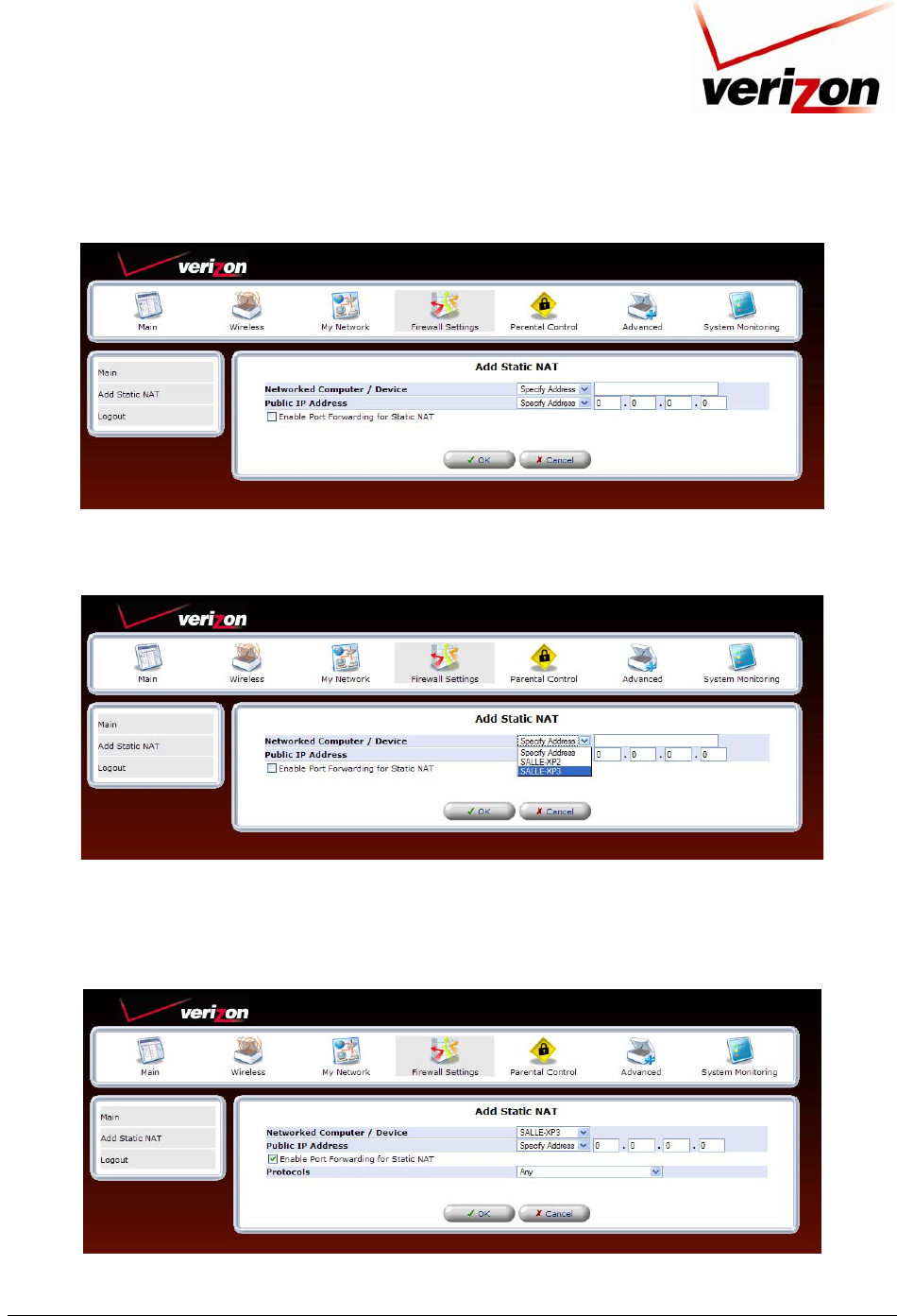
03/24/09 - DRAFT
030-300554 Rev. C 131 March 2009
Verizon FiOS Router
(
Model 9100EM
)
User Guide
The following screen appears.
From the Networked Computer/Device drop-down list, select the device to which you will apply Static NAT. Or
you can enter the device name in the field provided.
Next, you must first define what external (public) address will be assigned to this device. To use public IP addresses,
you must first obtain them from Verizon. Enter your IP address in the Public IP Address fields. If you want to
Enable Port Forwarding service, click the box next to Enable Port Forwarding for Static NAT. The Protocol drop-
down list appears.
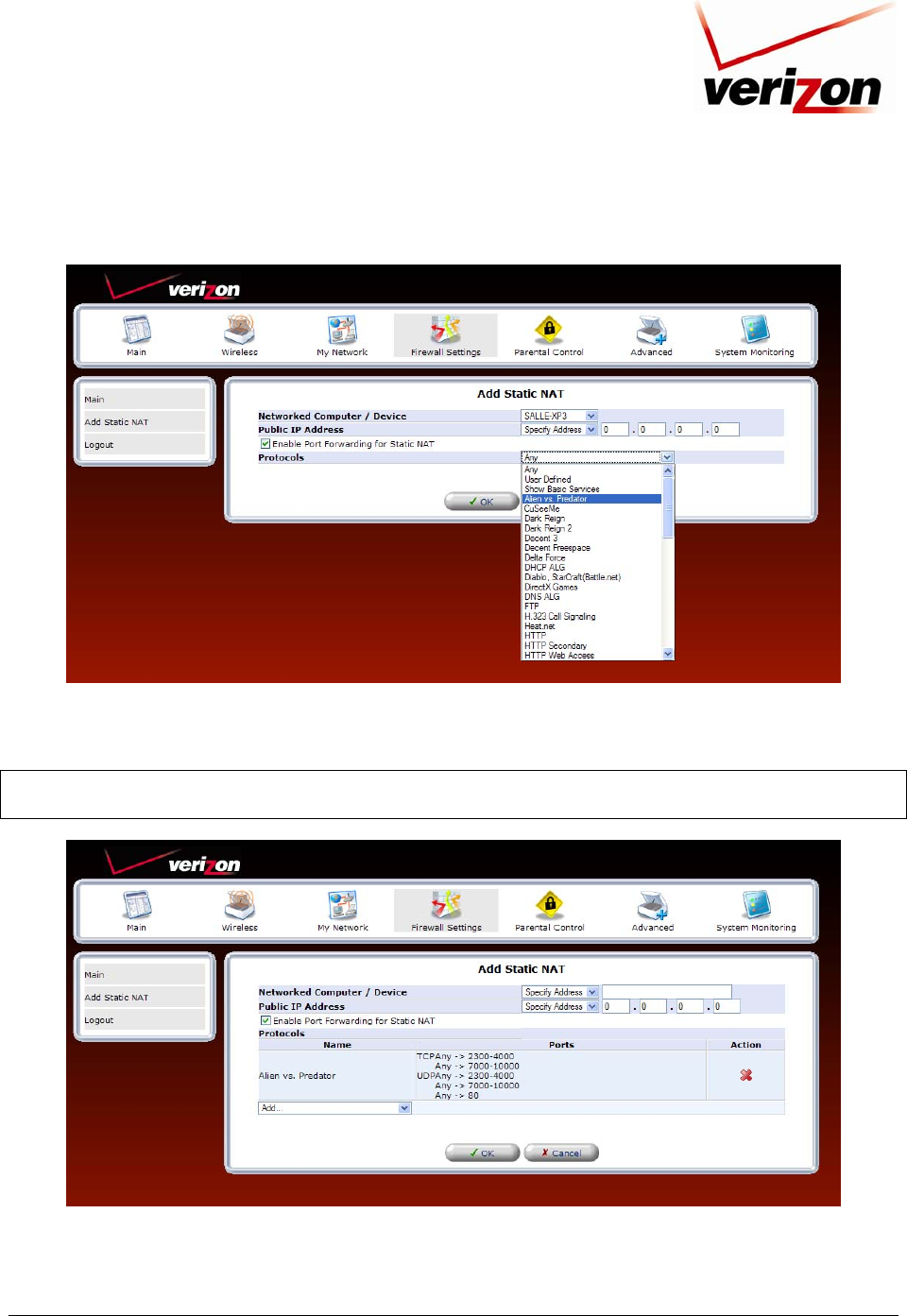
03/24/09 - DRAFT
030-300554 Rev. C 132 March 2009
Verizon FiOS Router
(
Model 9100EM
)
User Guide
Select the desired protocol from the Protocol drop-down list.
For example, if you select IP Address as the network object type, you must specify a single WAN IP address to add
to the pool. Enter a valid WAN IP address then click OK to continue.
Note: NAT/NAPT configuration—User defined work object must be contained in the device’s IP address pool.
Refer to section 15.11, “Network Objects,” for details.
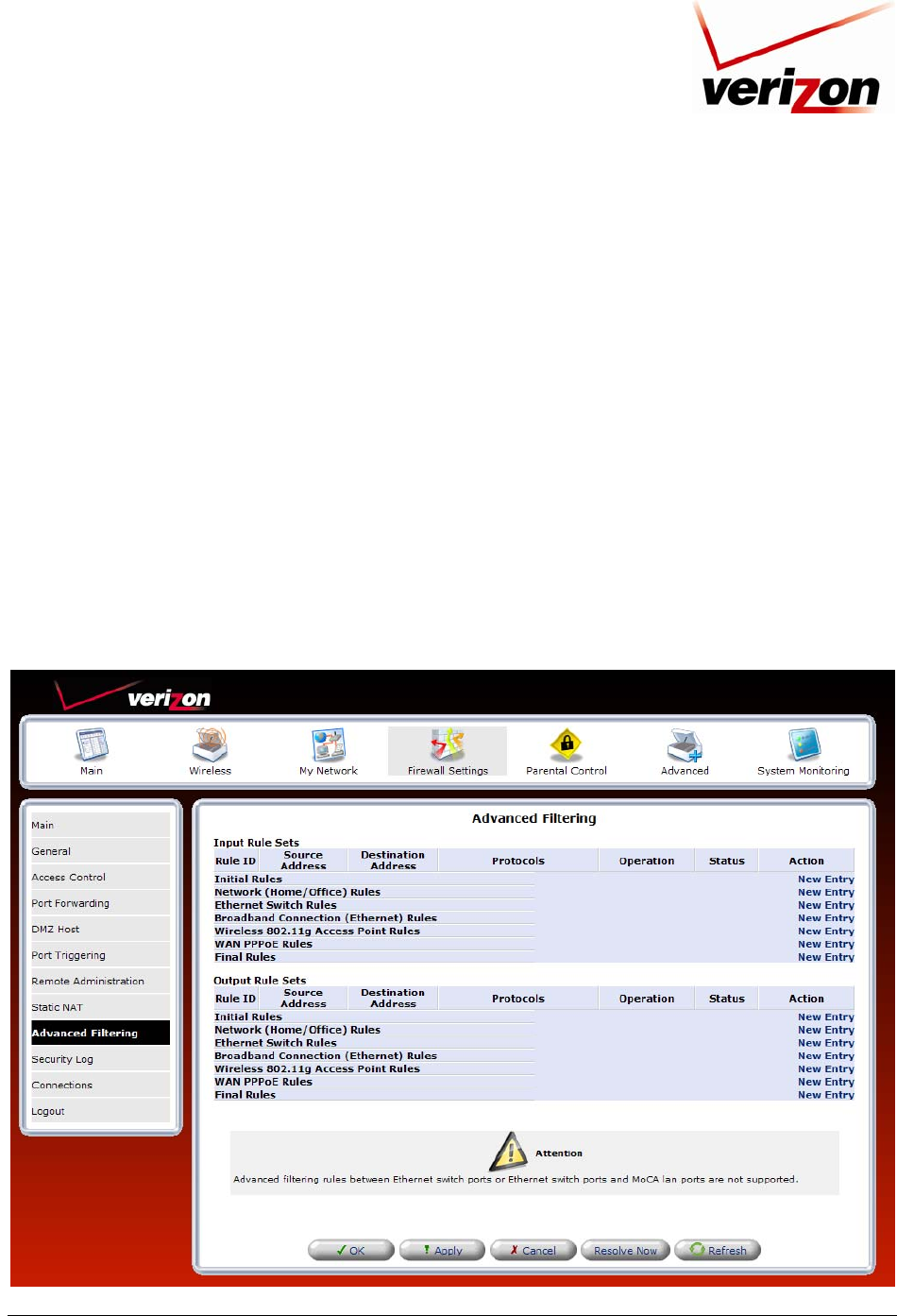
03/24/09 - DRAFT
030-300554 Rev. C 133 March 2009
Verizon FiOS Router
(
Model 9100EM
)
User Guide
13.8 Advanced Filtering
If you select Firewall Settings in the top navigation menu and then select Advanced Filtering in the left submenu,
the following screen appears.
Advanced filtering is designed to allow comprehensive control over the firewall's behavior. You can define specific
input and output rules, control the order of logically similar sets of rules and make a distinction between rules that
apply to WAN and LAN devices.
This screen is divided into two sections: one for Input Rule Sets and the other for Output Rule Sets, which are for
configuring inbound and outbound traffic, respectively. Each section comprises subsets, which can be grouped into
three main subjects:
• Initial rules—rules defined here will be applied first, on all gateway devices.
• Network device rules—rules can be defined per each gateway device.
• Final rules—rules defined here will be applied last, on all gateway devices.
To add rules to Input or Output rules sets, click the adjacent New Entry link.
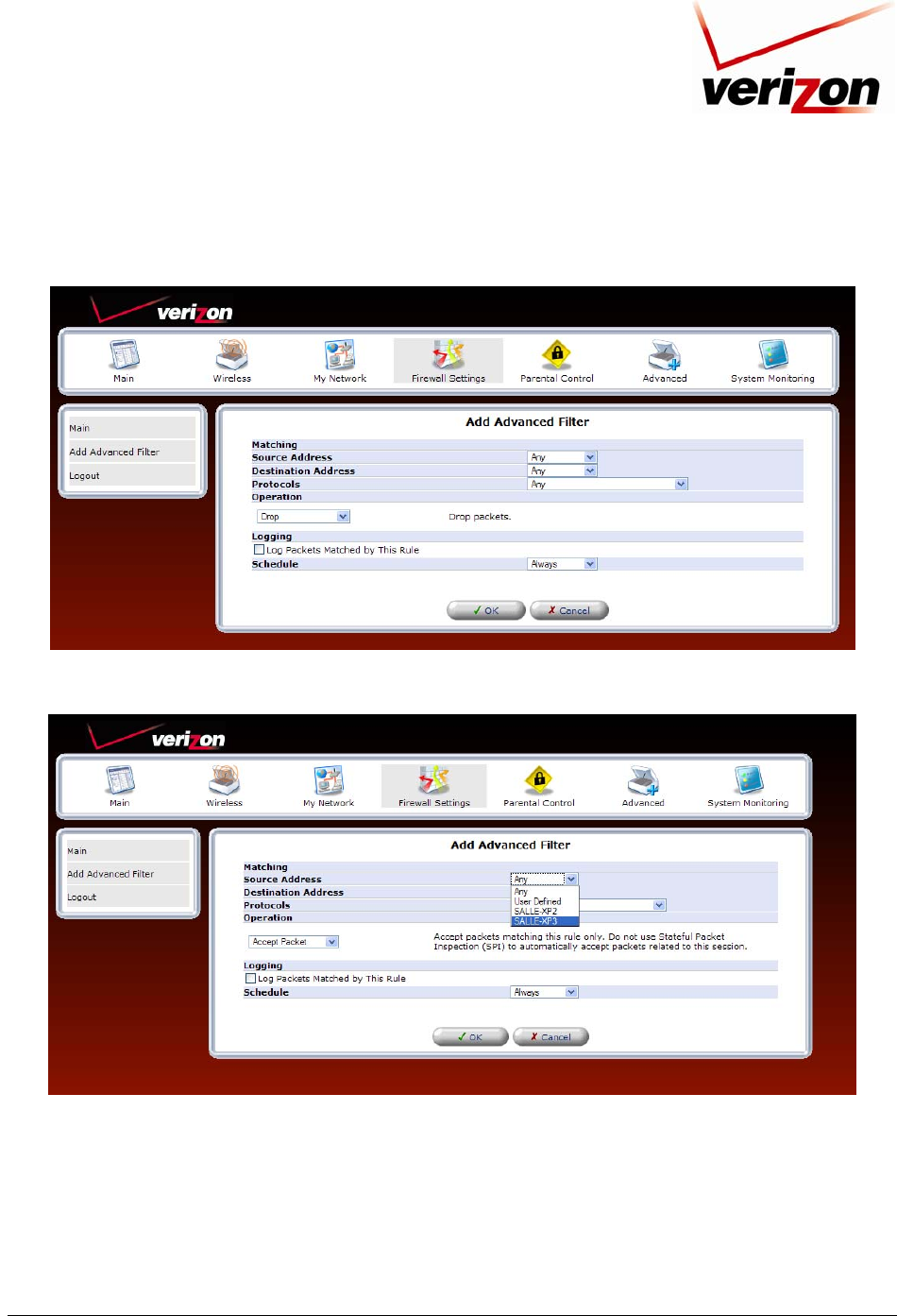
03/24/09 - DRAFT
030-300554 Rev. C 134 March 2009
Verizon FiOS Router
(
Model 9100EM
)
User Guide
For example, in the preceding screen, under Input Rule Sets, if you click the New Entry link next to Network
(Home/Office) Rules, the following screen appears.
Select the desired address from the Source Address/Destination Address drop-down list.
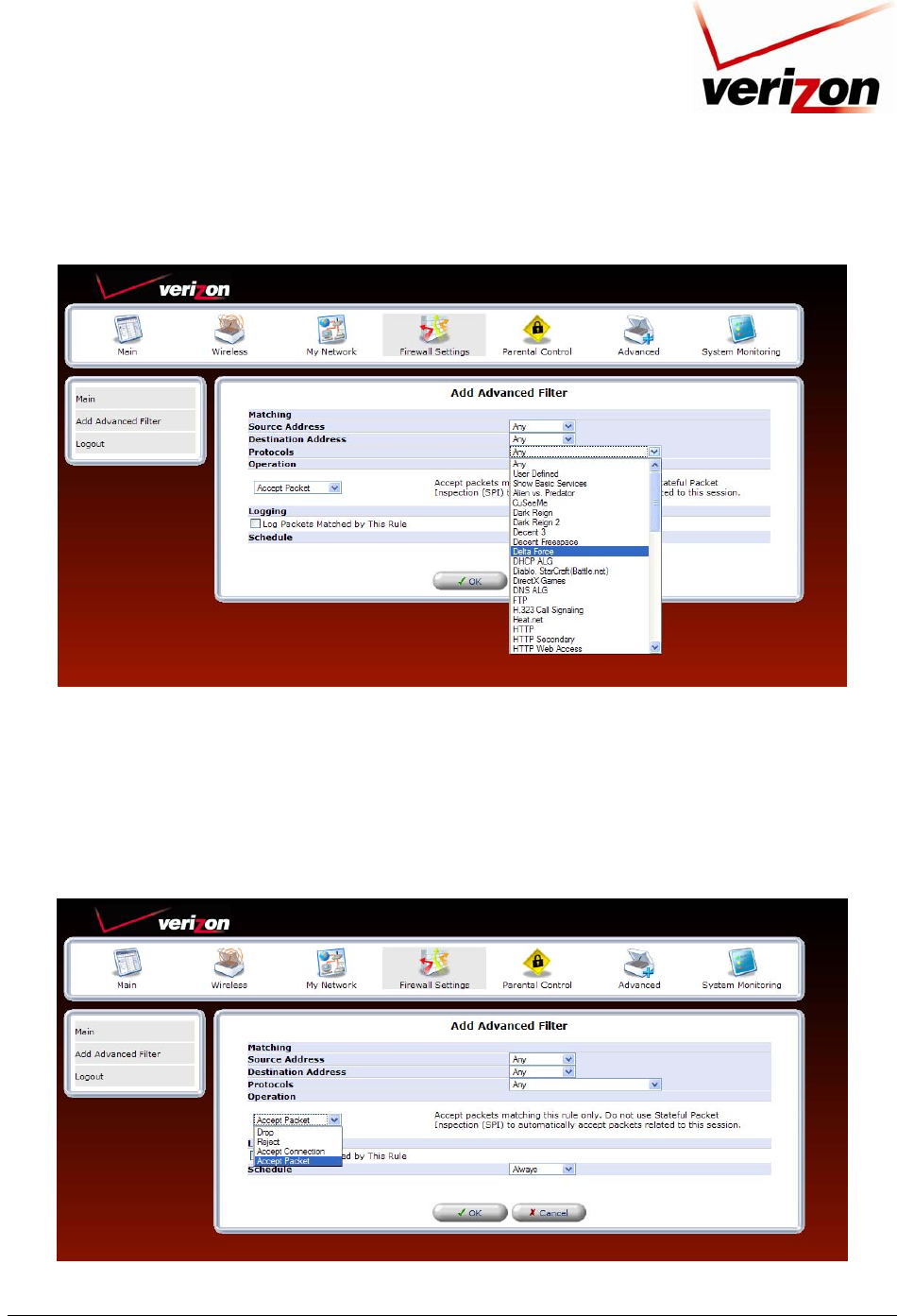
03/24/09 - DRAFT
030-300554 Rev. C 135 March 2009
Verizon FiOS Router
(
Model 9100EM
)
User Guide
Next, select the desired protocol from the Protocols drop-down list.
Select one of the following settings from the Operation drop-down list:
• Select Drop to drop packets.
• Select Reject to drop packets, and to send TCP Reset or ICMP Host Unreachable packets to the sender.
• Select Accept Connection to accept all packets related to this session.
• Select Accept Packet to accept packets matching this rule only. Do not use Stateful Packet Inspection
(SPI) to automatically accept packets related to this session.
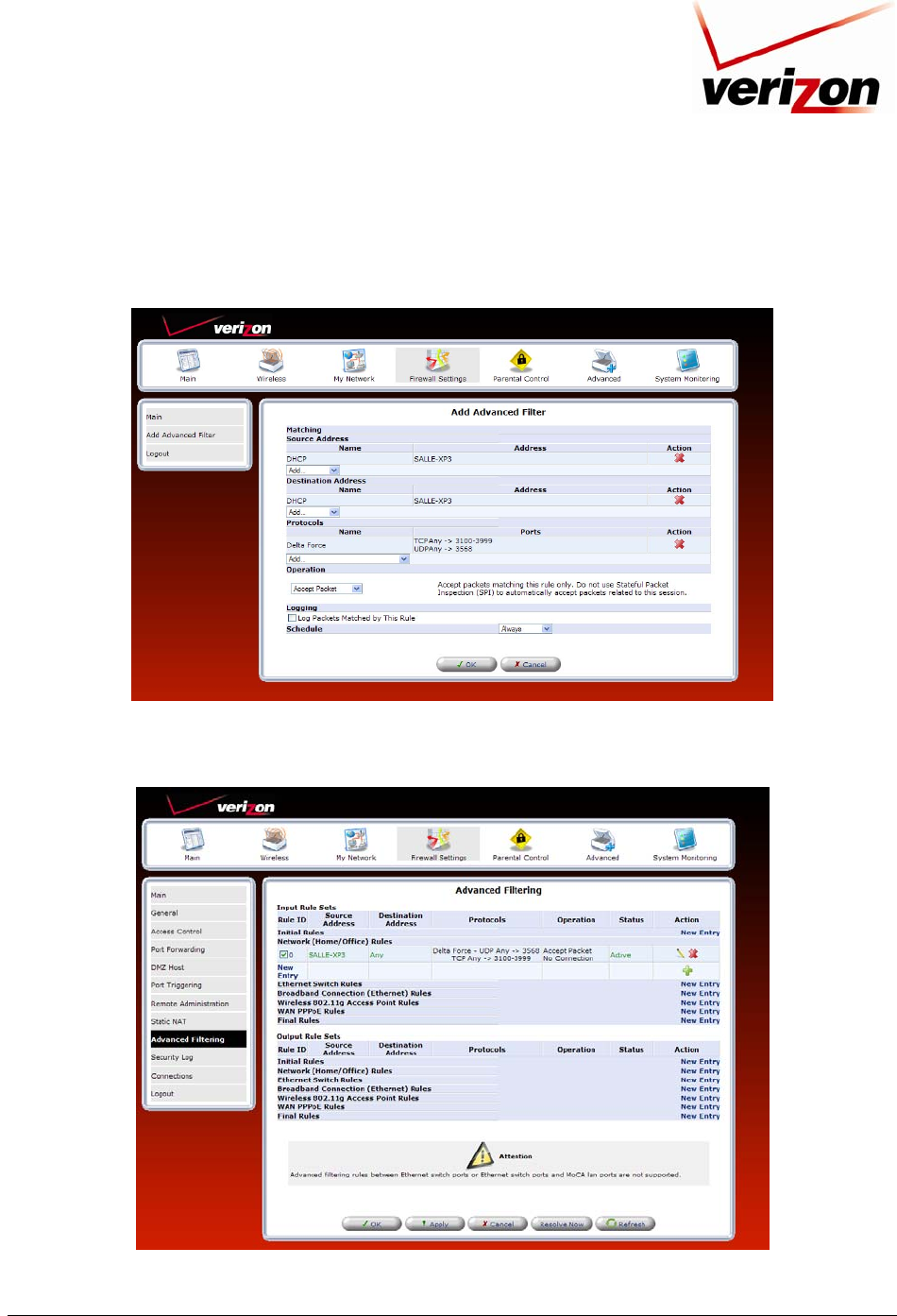
03/24/09 - DRAFT
030-300554 Rev. C 136 March 2009
Verizon FiOS Router
(
Model 9100EM
)
User Guide
After you have selected the desired values, the following screen appears. If you want to log packets matched by this
rule, click the check box located under Logging. If you want to set up a schedule for this rule, refer to section 15.21
for instructions on creating a schedule rule. After you have finished entering the desired settings in this screen, click
OK to continue.
If you clicked OK, the following screen appears. The rule is now active. To add additional rules, click the New
Entry link next to the rule that you want to set up.
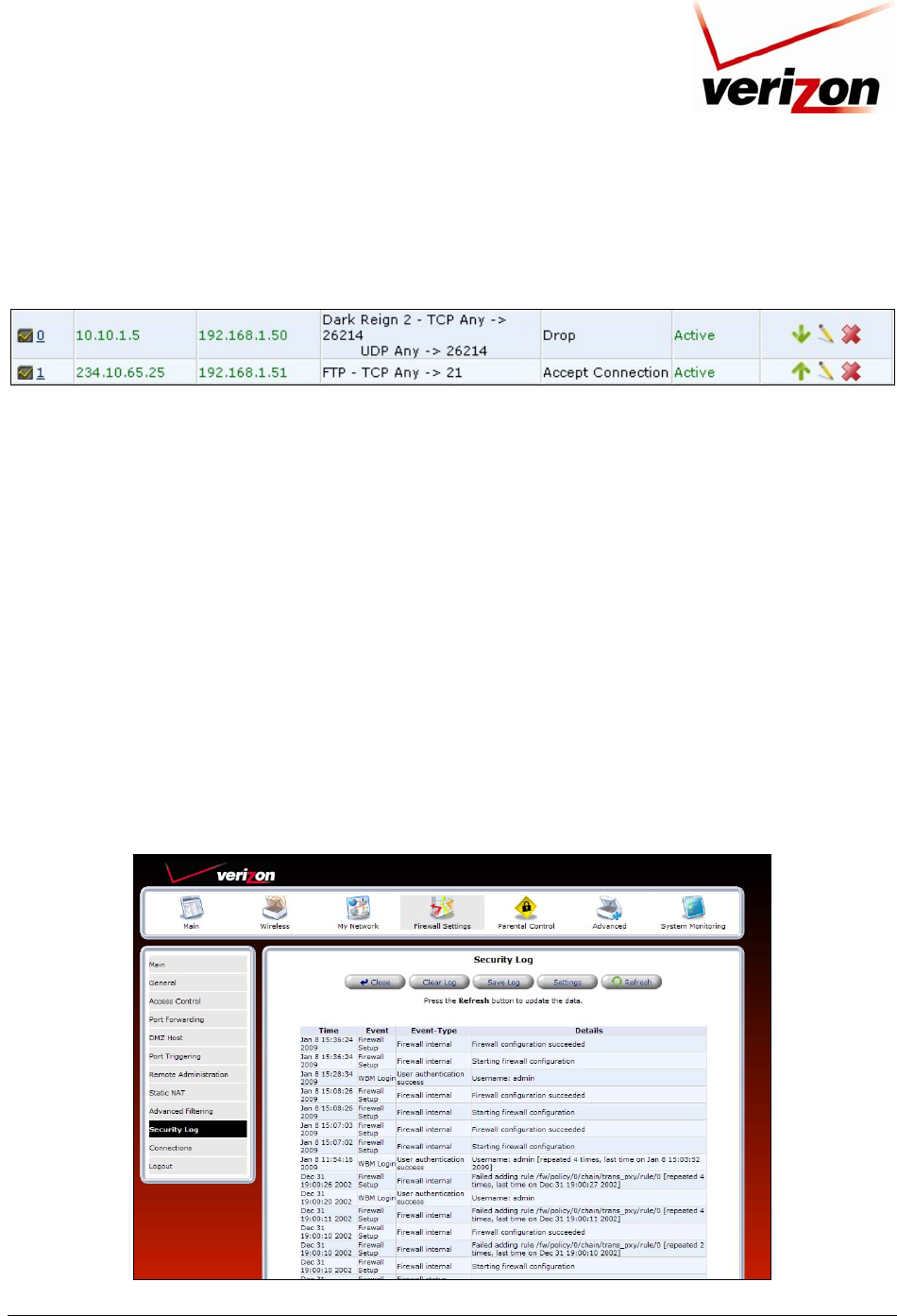
03/24/09 - DRAFT
030-300554 Rev. C 137 March 2009
Verizon FiOS Router
(
Model 9100EM
)
User Guide
The order of the rules appearance represents both the order in which they were defined and the sequence
by which they will be applied. By clicking the Move Up and Move Down action icons, you can change this order
after your rules are already defined (without having to delete and then re-add them). After you click the desired icon,
the screen will refresh and display the change.
13.9 Security Log
If you select Firewall Settings in the top navigation menu and then select Security Log in the left submenu, the
following screen appears.
This screen alerts you of noteworthy information sent to the Router from the Internet. The screen can contain 1000
entries, but a maximum of 50 entries are displayed at a time. Once 1000 entries have been logged, the oldest entry is
removed to make space for the new entries as they occur. In this screen, do any of the following:
• Click Close to close the security log screen.
• Click Clear Log to remove all entries from the log.
• Click Save to save the settings to a syslog server.
• Click Settings to configure the security settings. Clicking this button opens a new window that contains
configuration options for selecting the information that you want logged.
• Click Refresh to refresh the security log screen.
To configure the security log settings, click the Settings button.
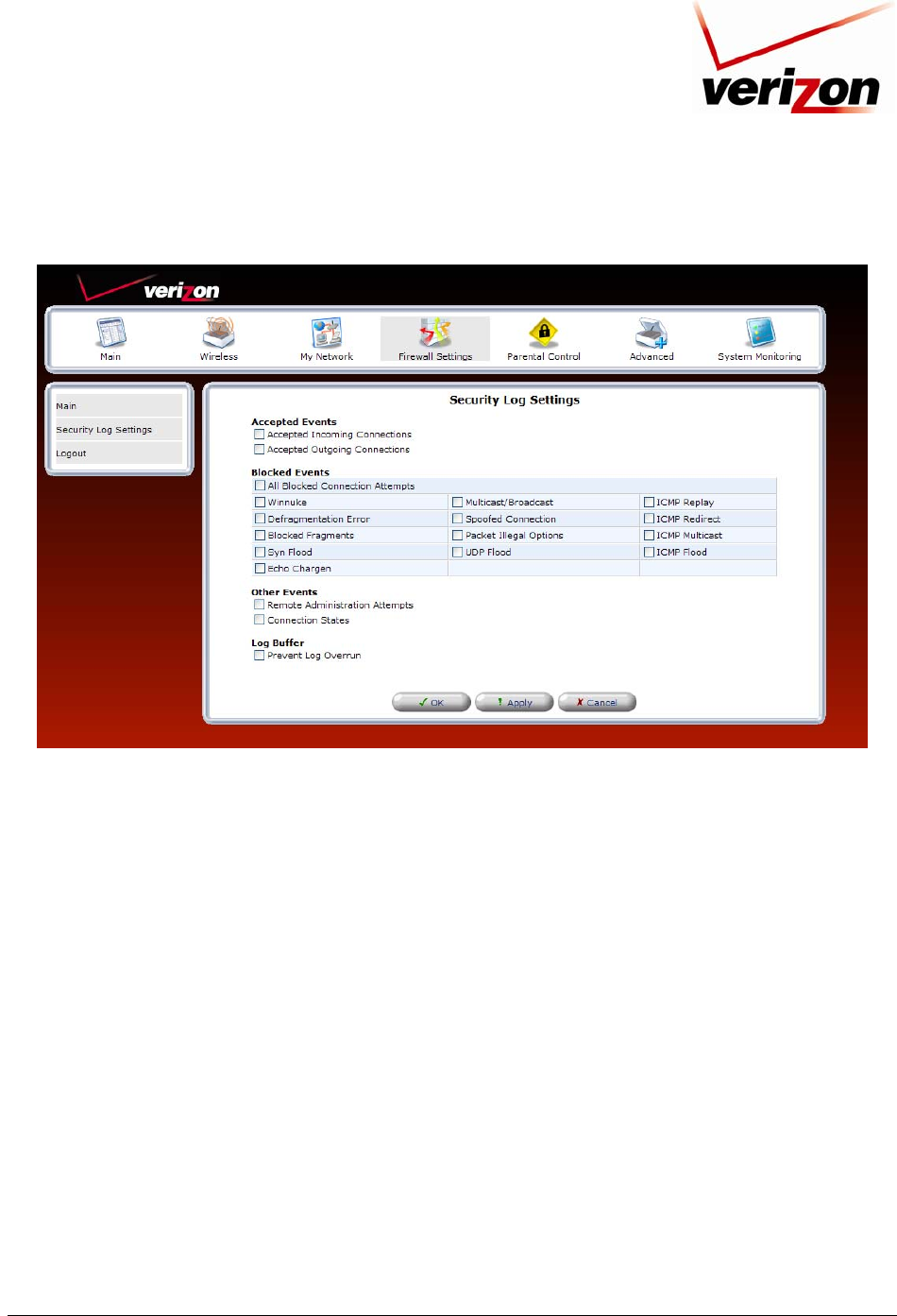
03/24/09 - DRAFT
030-300554 Rev. C 138 March 2009
Verizon FiOS Router
(
Model 9100EM
)
User Guide
If you clicked Settings, the following screen appears. Select the desired settings by clicking the check boxes (a
checkmark will appear in the box when a setting is enabled). Then, click Apply to save the settings.
Select the types of activities for which you would like to have a log message generated:
• Accepted Events
Accepted Incoming Connections: Write a log message for each successful attempt to establish an inbound
connection to the home network.
Accepted Outgoing Connections: Write a log message for each successful attempt to establish an
outgoing connection to the public network.
• Blocked Events
All Blocked Connection Attempts: Write a log message for each blocked attempt to establish an inbound
connection to the home network or vice versa. You can enable logging of blocked packets of specific types
by disabling this option, and enabling some of the more specific options below it.
Specific Events: Specify the blocked events that should be monitored. Use this to monitor specific event
such as SynFlood. A log message will be generated if either the corresponding check-box is checked, or the
“All Blocked Connection Attempts” check-box is checked.
• Other Events
Remote Administration Attempts: Write a log message for each remote-administration connection
attempt, whether successful or not.
Connection States: Provide extra information about every change in a connection opened by the firewall.
Use this option to track connection handling by the firewall and the Application Level Gateways (ALGs).
• Log Buffer
Prevent Log Overrun: Select this check box in order to stop logging firewall activities when the memory
allocated for the log fills up.
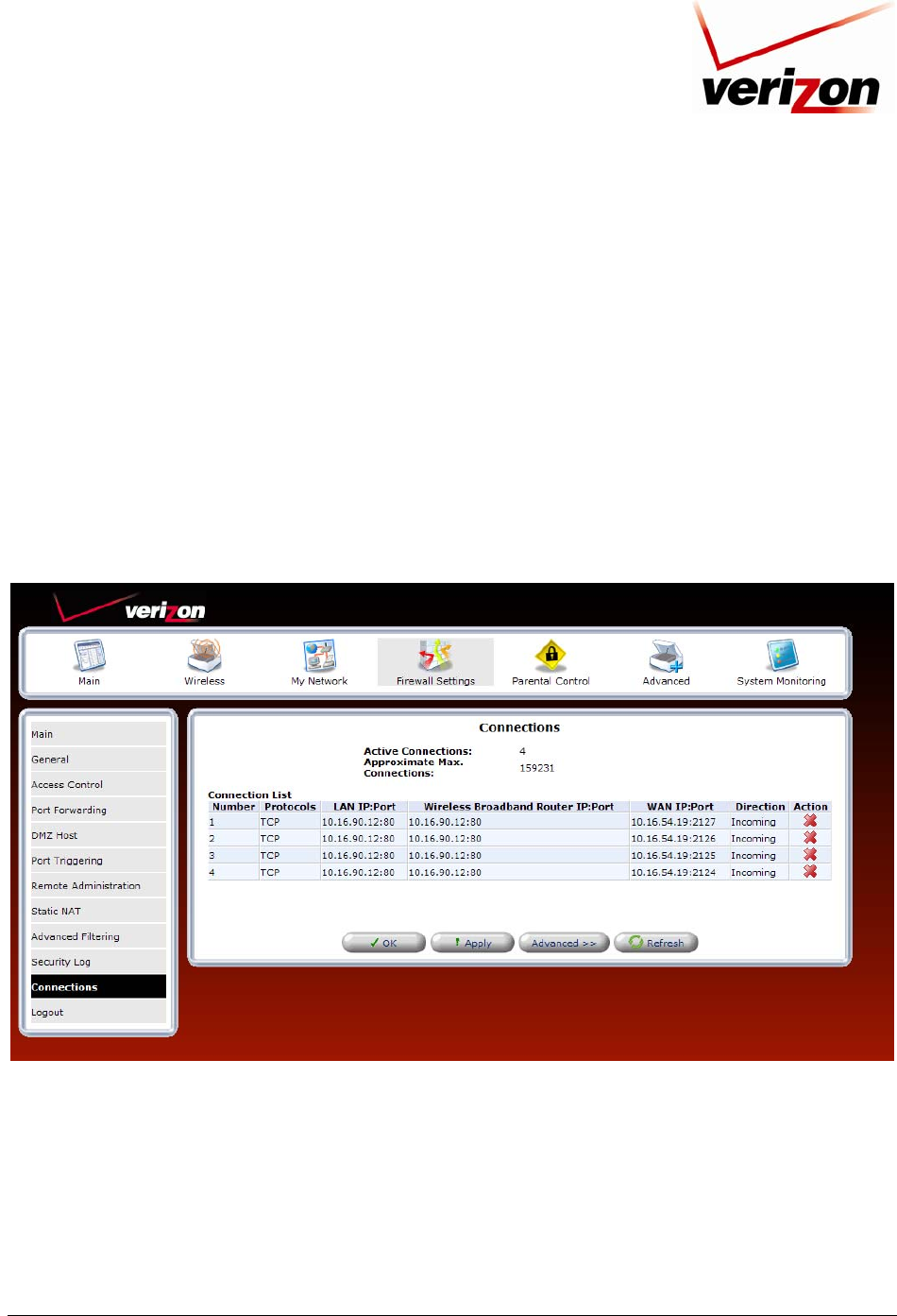
03/24/09 - DRAFT
030-300554 Rev. C 139 March 2009
Verizon FiOS Router
(
Model 9100EM
)
User Guide
13.10 Connections
If you select Firewall Settings in the top navigation menu and then select Connections in the left submenu, the
following screen appears.
The connections list displays all the connections that are currently open on the firewall, as well as various details
and statistics. You can use this list to close undesired connections by clicking the “X” icons. The basic display
includes the protocol type, the different ports it uses, and the direction of the secured traffic.
• Active Connections—this value represents the number of active concurrent connections.
• Approximate Max. Connections—this value represents the amount of additional concurrent connections
possible.
• Connections Per Page—use this drop-down list to select the number of connections to display at once.
Click the Advanced button to display a more detailed connection list.
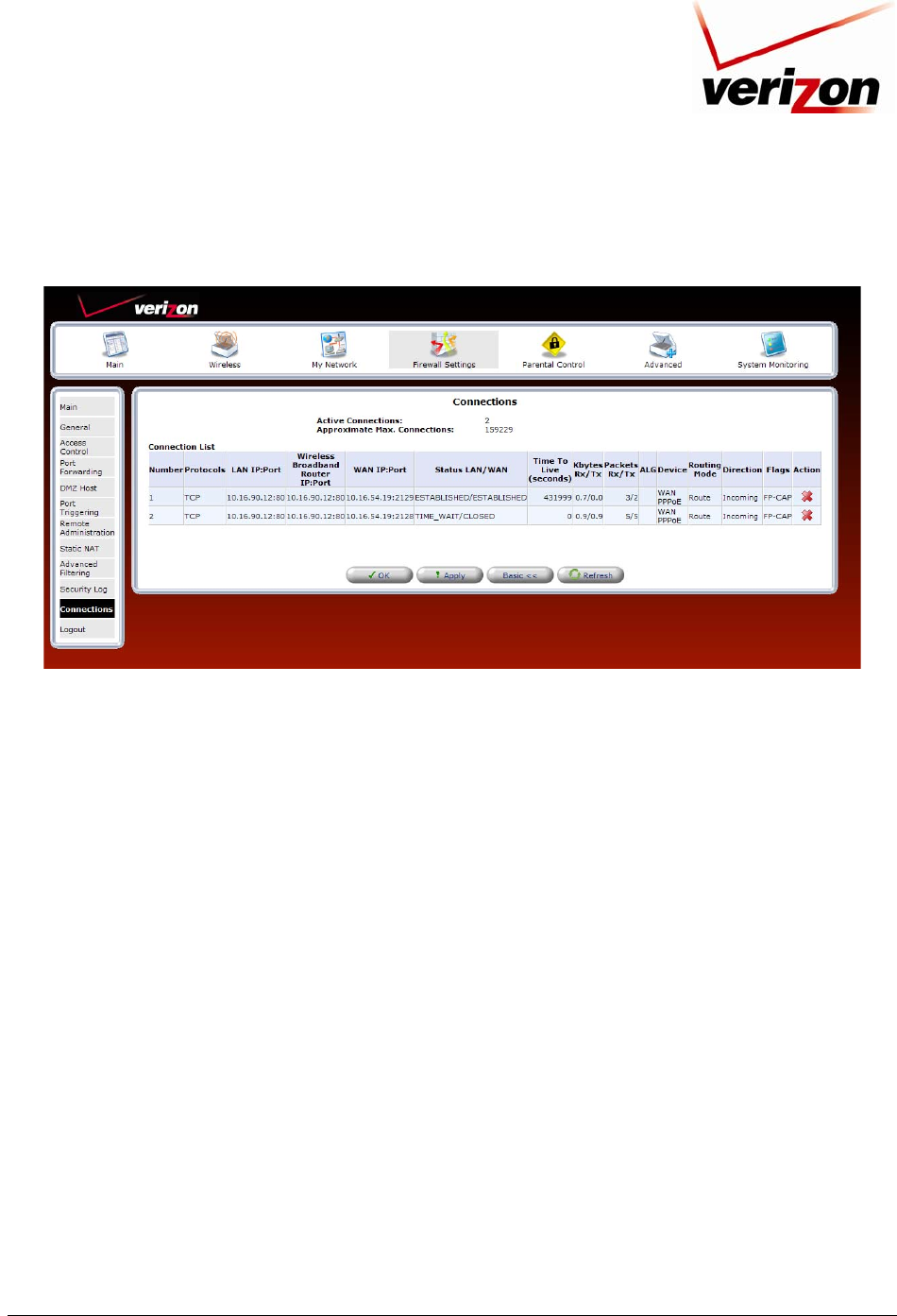
03/24/09 - DRAFT
030-300554 Rev. C 140 March 2009
Verizon FiOS Router
(
Model 9100EM
)
User Guide
If you clicked Advanced, the following screen appears. Additional details in this page include connection status
(LAN/WAN), time-to-live, number of kilo-bytes and packets received and transmitted, ALG device, routing mode,
and flags. To close a undesired connection, click the adjacent “X” icon.
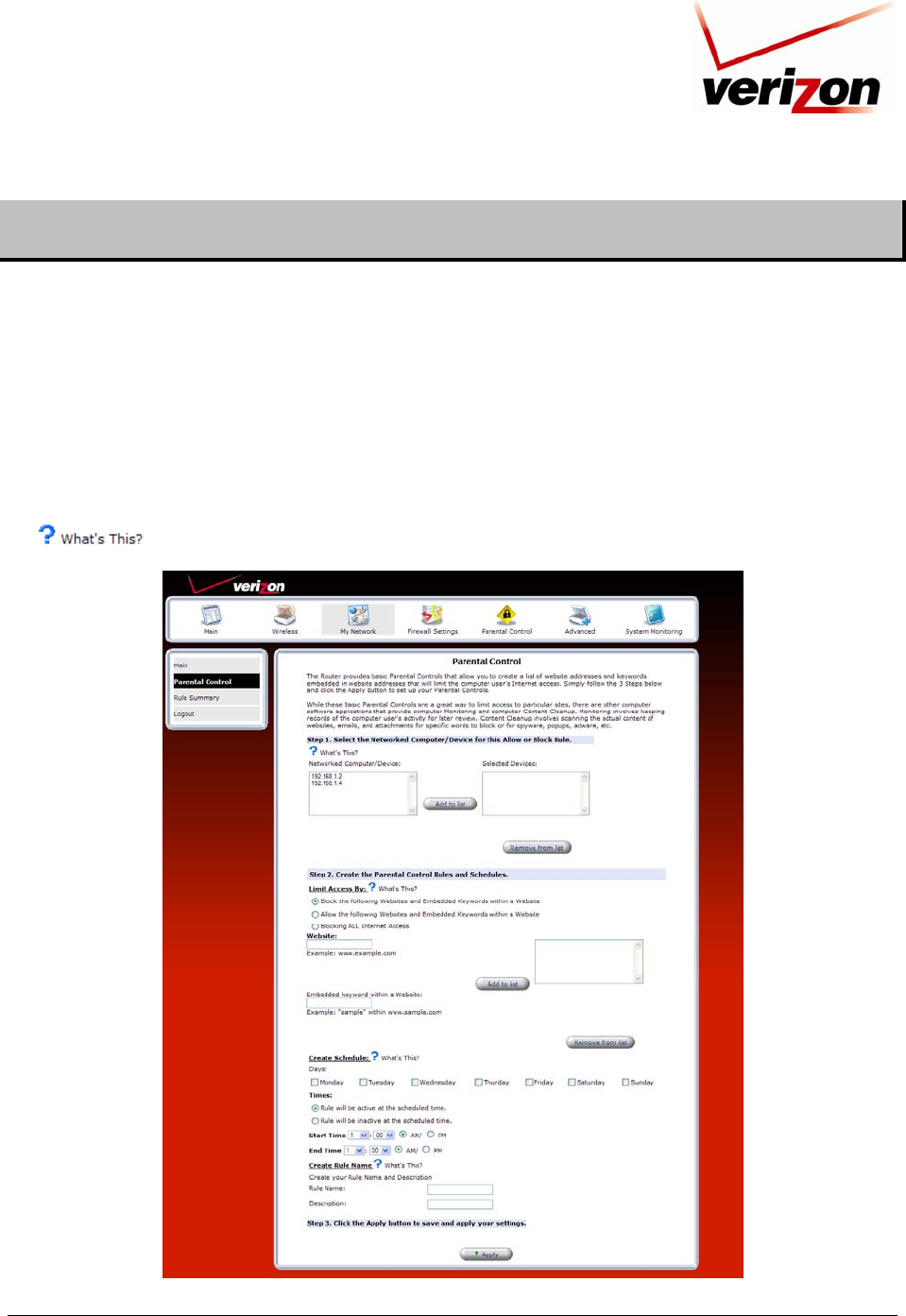
03/24/09 - DRAFT
030-300554 Rev. C 141 March 2009
Verizon FiOS Router
(
Model 9100EM
)
User Guide
14. PARENTAL CONTROLS
If you select Parental Controls in the top navigation menu, the following screen appears. The Router provides basic
Parental Controls that allow you to create a list of Web site addresses and keywords embedded in website addresses
that will limit the computer user’s Internet access. Simply follow the 3 steps below, and click the Apply button to
set up your Parental Controls.
While these basic Parental Controls are a great way to limit access to particular sites, there are other computer
software applications that provide computer Monitoring and computer Content Cleanup. Monitoring involves
keeping records of the computer user’s activity for later review. Content Cleanup involves scanning the actual
content of websites, emails, and attachments for specific words to block or for spyware, popups, adware, etc.
The following steps guide you through configuring Parental Controls. If you have questions about a feature, click
the icon to learn more about that feature.
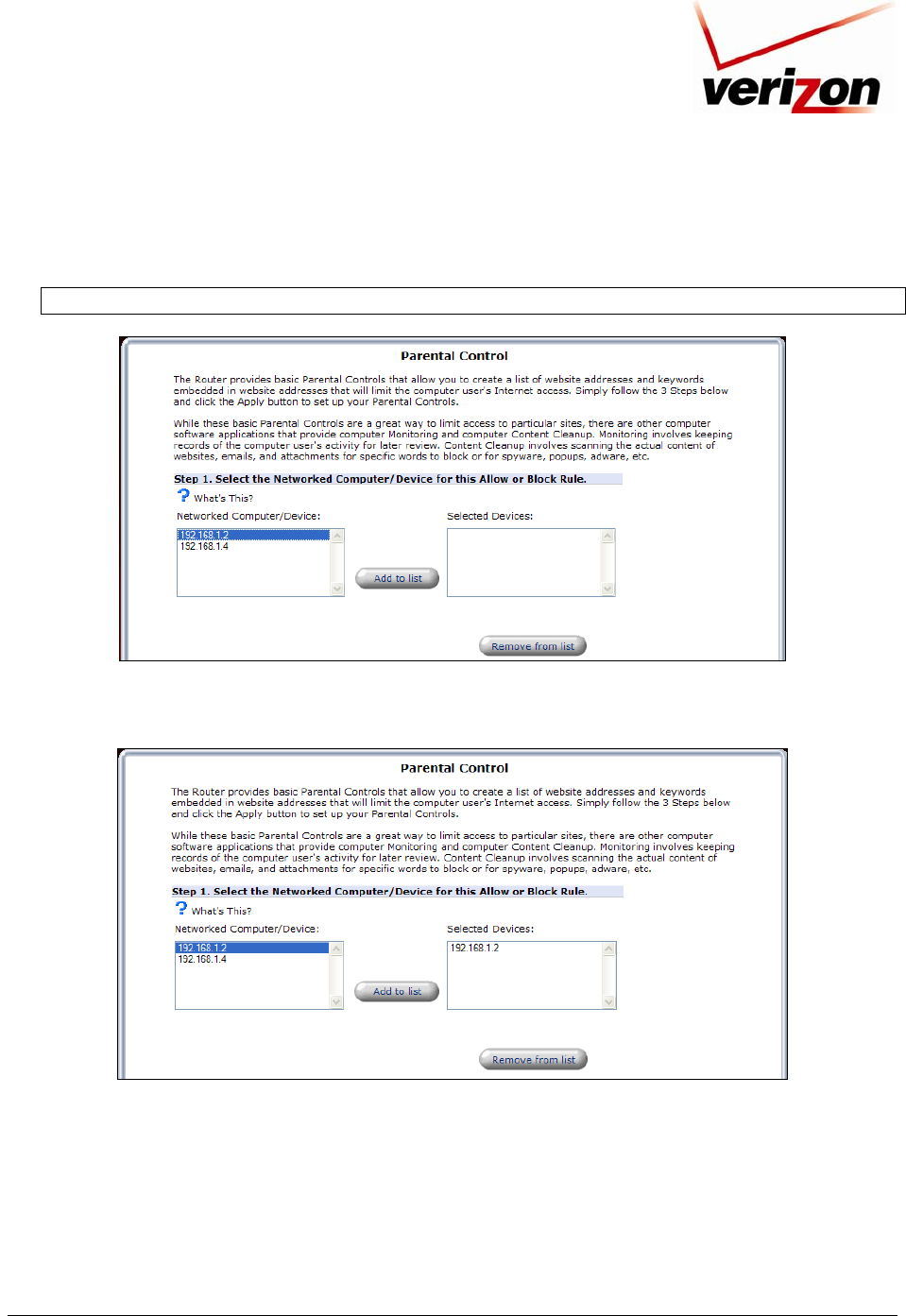
03/24/09 - DRAFT
030-300554 Rev. C 142 March 2009
Verizon FiOS Router
(
Model 9100EM
)
User Guide
1. In the Networked Computer/Device box, select the device that will receive this rule. Then click the Add to list
button.
Note: You can select only specified devices, not specific accounts on these devices.
The selected device will appear in the Selected Devices box. If you want to remove a device from the Selected
Devices panel, click the Remove from list button.
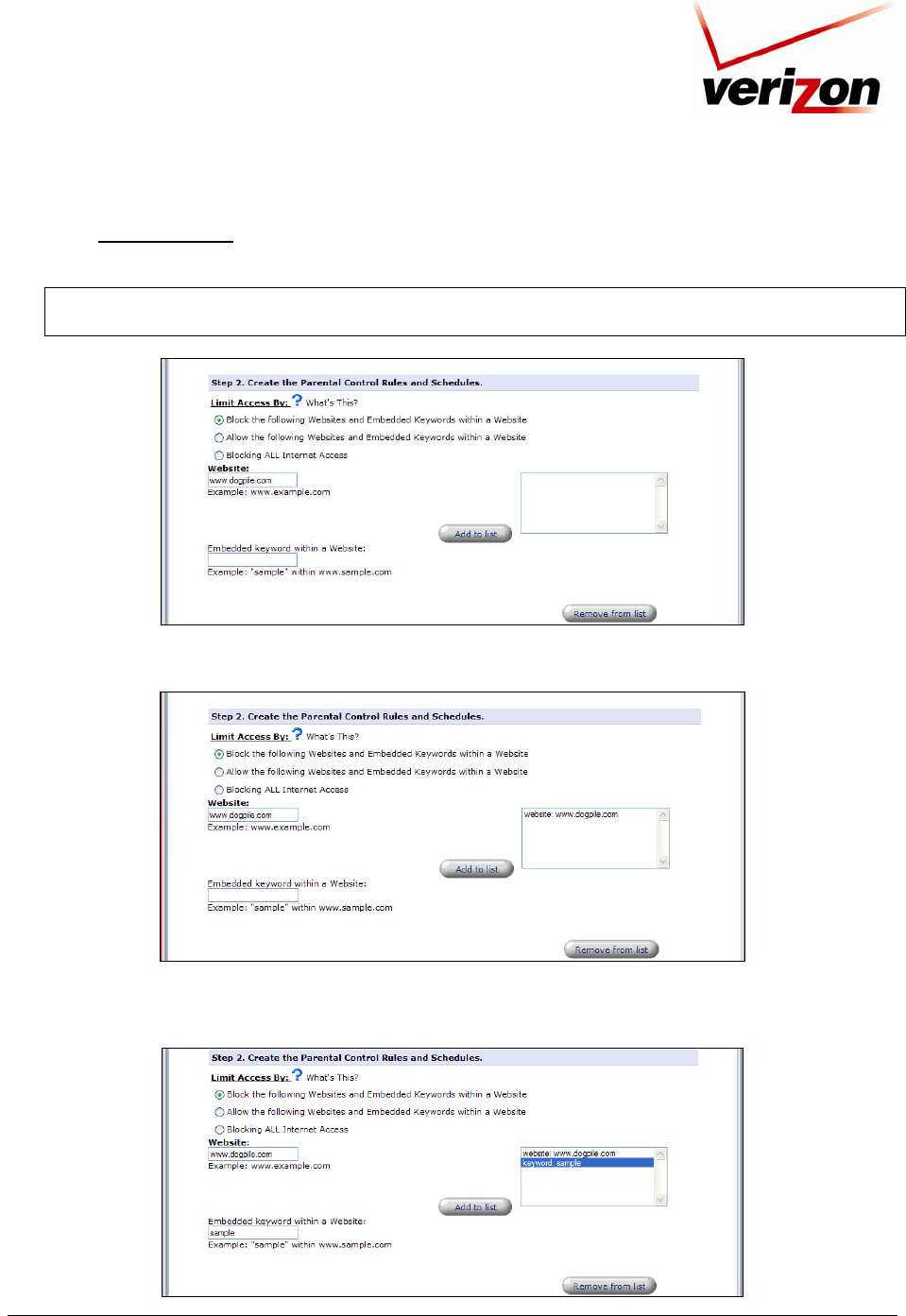
03/24/09 - DRAFT
030-300554 Rev. C 143 March 2009
Verizon FiOS Router
(
Model 9100EM
)
User Guide
2. Below Limit Access By, click the option button next to the rule that you want to apply. Then in the box labeled
Website, enter a website domain name (for example, www.example.com) and click the Add to list button.
IMPORTANT: The Router does not block or allow based on content of websites, emails, or attachments, only
based on website addresses or keywords embedded in those website addresses.
The domain name will appear in the Add to list box.
If you want to embed a keyword, type the word in the box provided, and then click the Add to list button. If
you want to remove a website domain name from the box, click the Remove from list button.
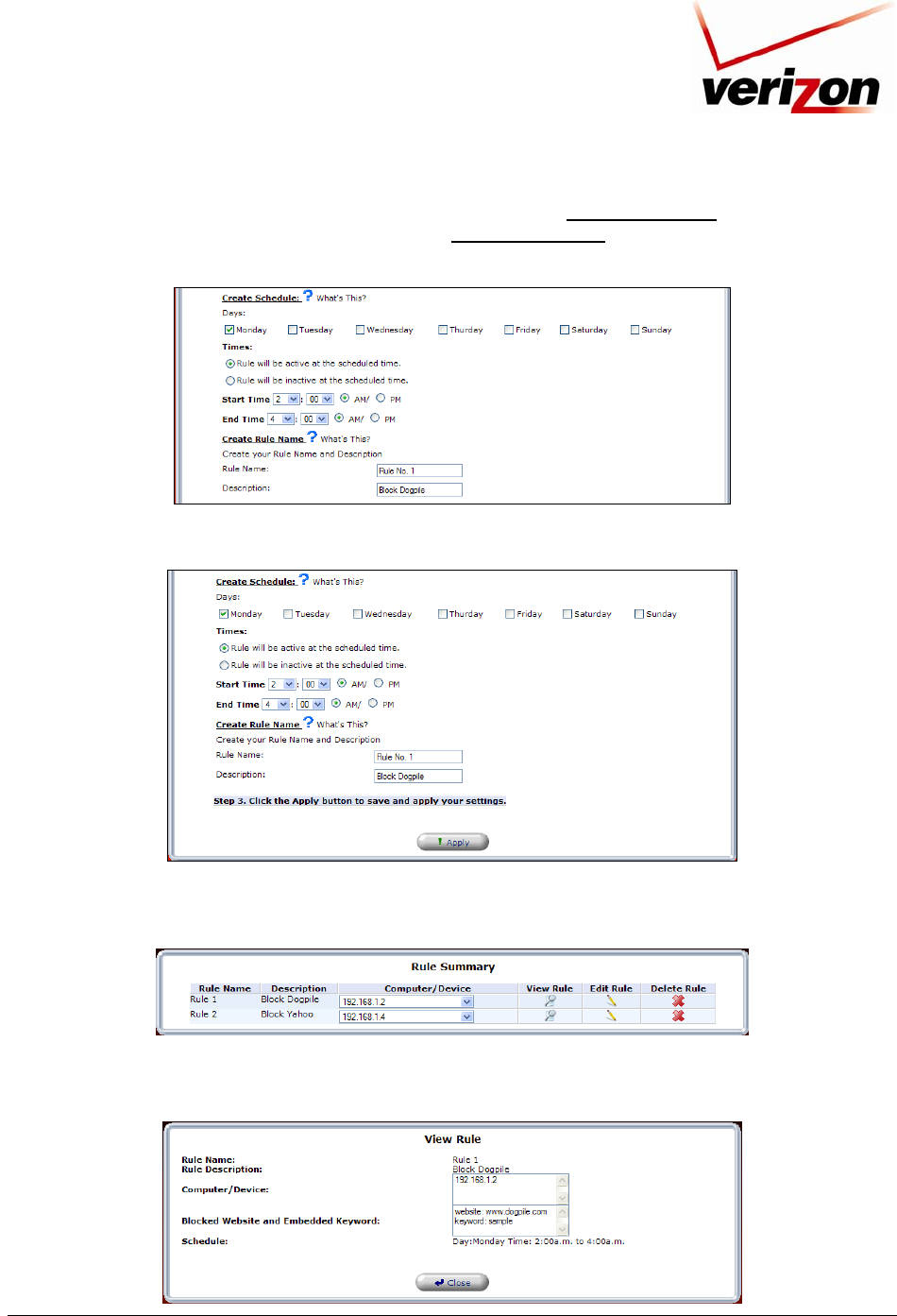
03/24/09 - DRAFT
030-300554 Rev. C 144 March 2009
Verizon FiOS Router
(
Model 9100EM
)
User Guide
To set up a schedule rule for the website restriction in the section labeled Create a Schedule, enter the desire
settings in the fields provided. Then in the section labeled Create Rule Name, enter the desired rule name and
description.
3. After you have entered the desired settings, click the Apply button to save the settings to the Router.
After you click Apply, the following screen appears. Click any of the icons (view, edit, or delete) next to the
website rule that you want to view or modify.
If you click the View Rule icon, the following screen appears. After viewing this screen, click Close to return to
the Rule Summary page.
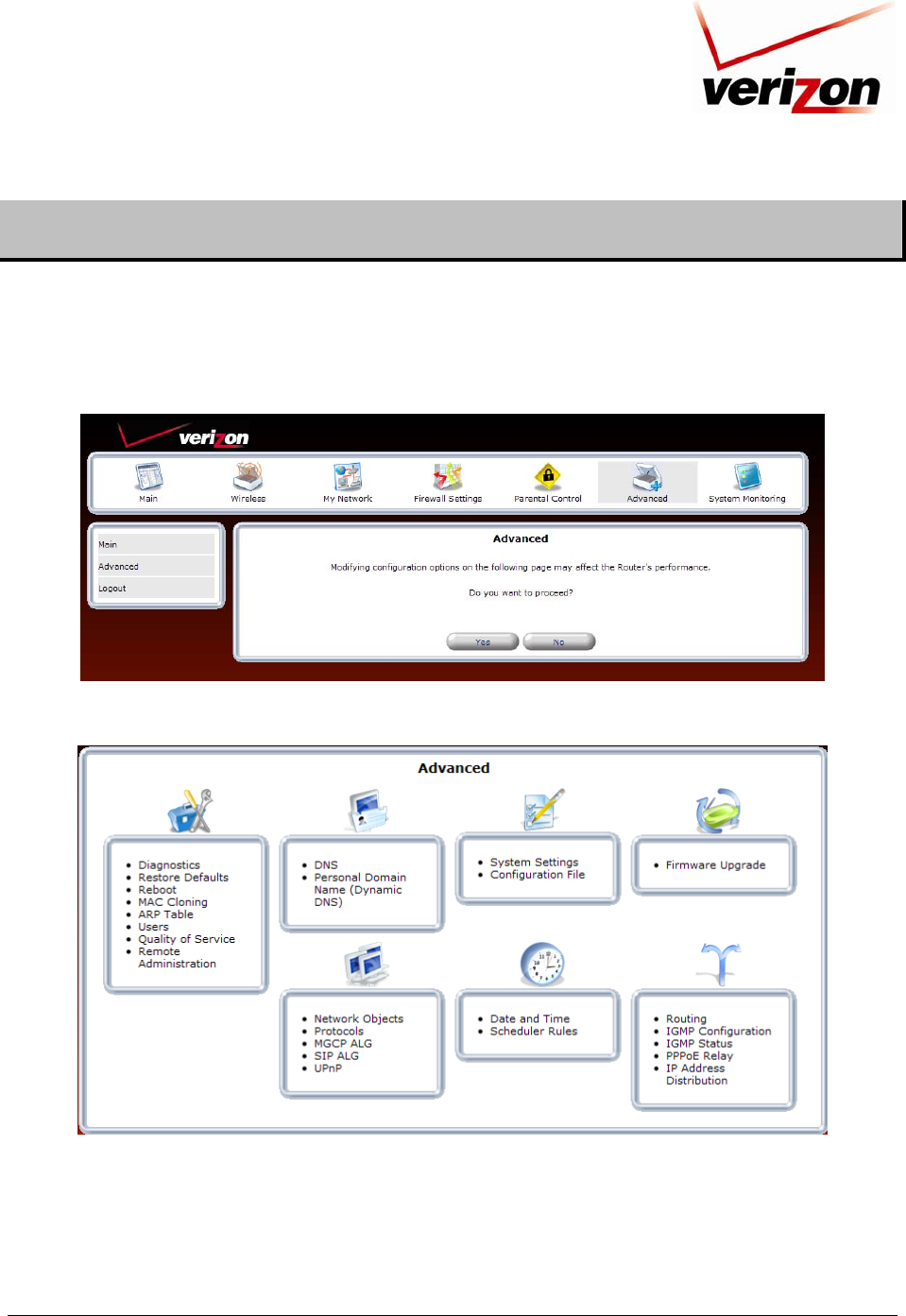
03/24/09 - DRAFT
030-300554 Rev. C 145 March 2009
Verizon FiOS Router
(
Model 9100EM
)
User Guide
15. ADVANCED
If you select Advanced in the top navigation menu, the following screen appears. The Advanced section of this User
Guide is intended to provide assistance with configuring the Advanced features of your Verizon FiOS Router and
assumes that the user has an in-depth understanding of computers, routing, and Internet networking.
Click Yes to proceed to the Router’s Advanced screen.
Clicking the links in the Advanced screen allows you to access various configurable settings in your Router.
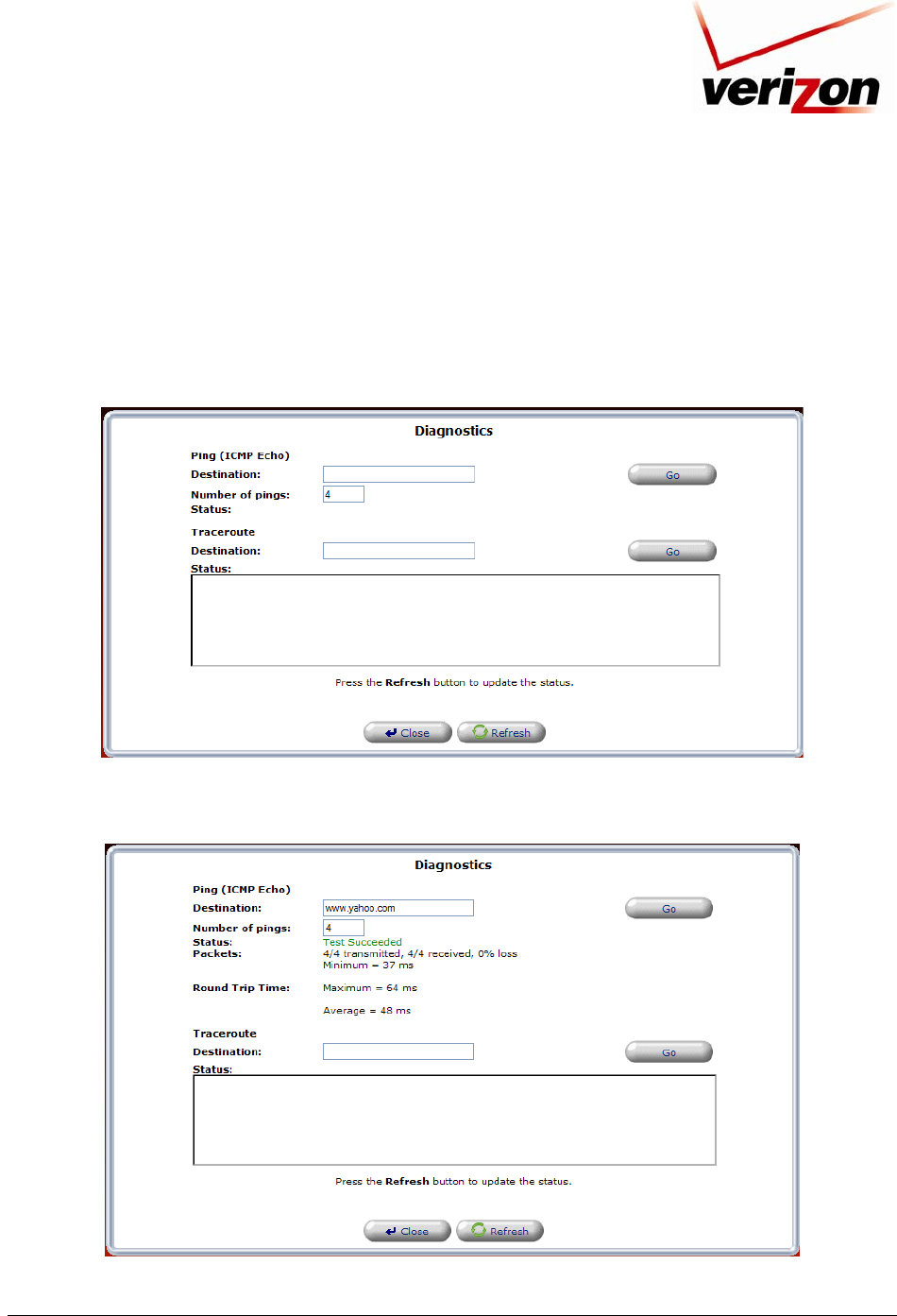
03/24/09 - DRAFT
030-300554 Rev. C 146 March 2009
Verizon FiOS Router
(
Model 9100EM
)
User Guide
15.1 Diagnostics
If you click the Diagnostics link in the Advanced screen, the following screen appears. Using this screen, you can
run the following diagnostics tests:
• To run a PING test, type the appropriate IP address or host name in the field provided, and then click Go.
• To run a Traceroute test, type the appropriate IP address or host name in the field provided, and then click Go.
For example, if you enter a host name in the Destination field and then click Go, the following screen appears. This
screen shows that the Ping test succeeded. Click Close to return to the Advanced screen.
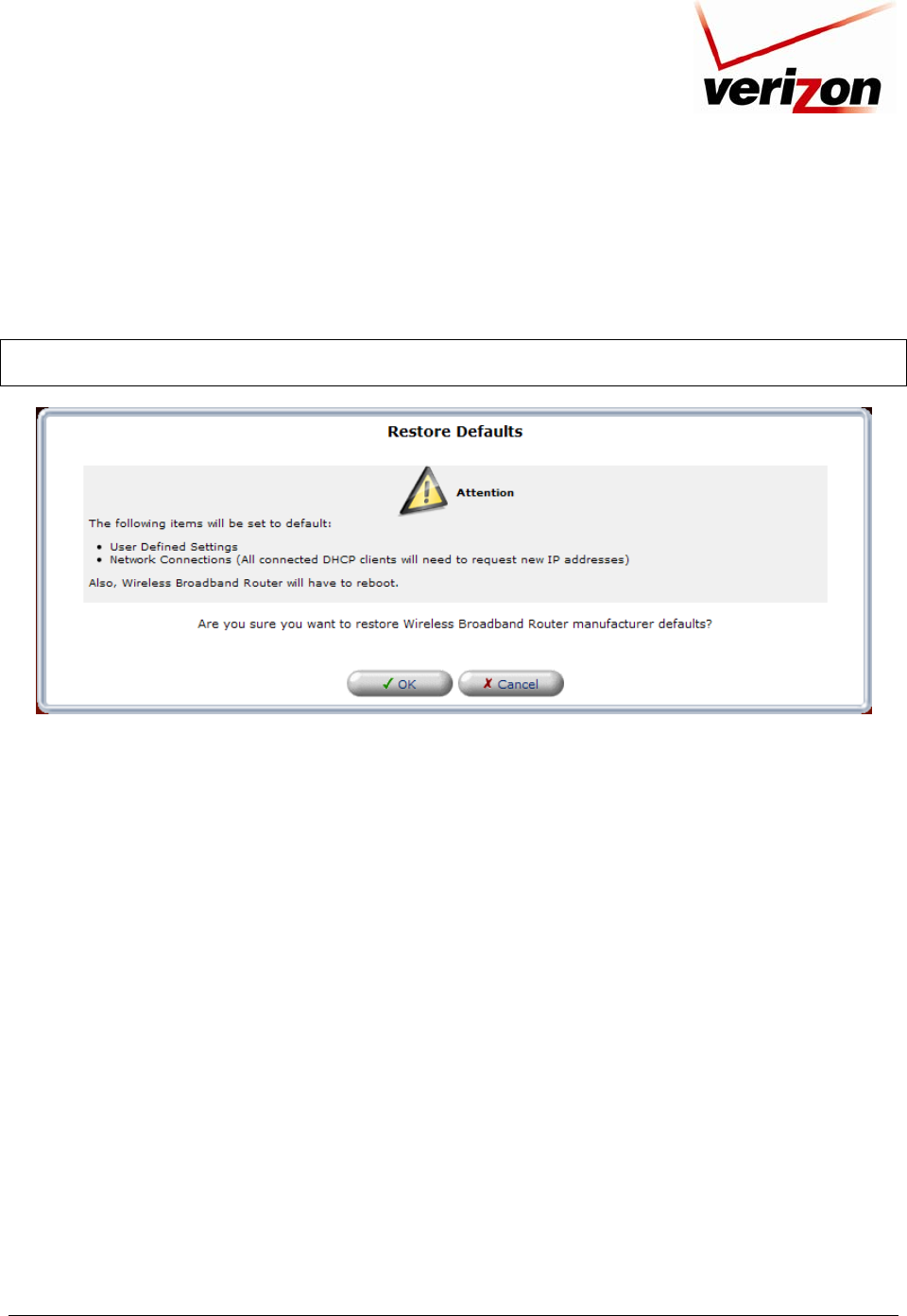
03/24/09 - DRAFT
030-300554 Rev. C 147 March 2009
Verizon FiOS Router
(
Model 9100EM
)
User Guide
15.2 Restore Defaults
If you click the Restore Defaults link in the Advanced screen, the following screen appears. Click OK to allow the
Router to be reset to factory default settings. After the Router has rebooted, you will need to log in to the Router.
IMPORTANT: If you click OK, any settings that you have configured in the Router will be erased, and any data
that the Router has reported will be lost.
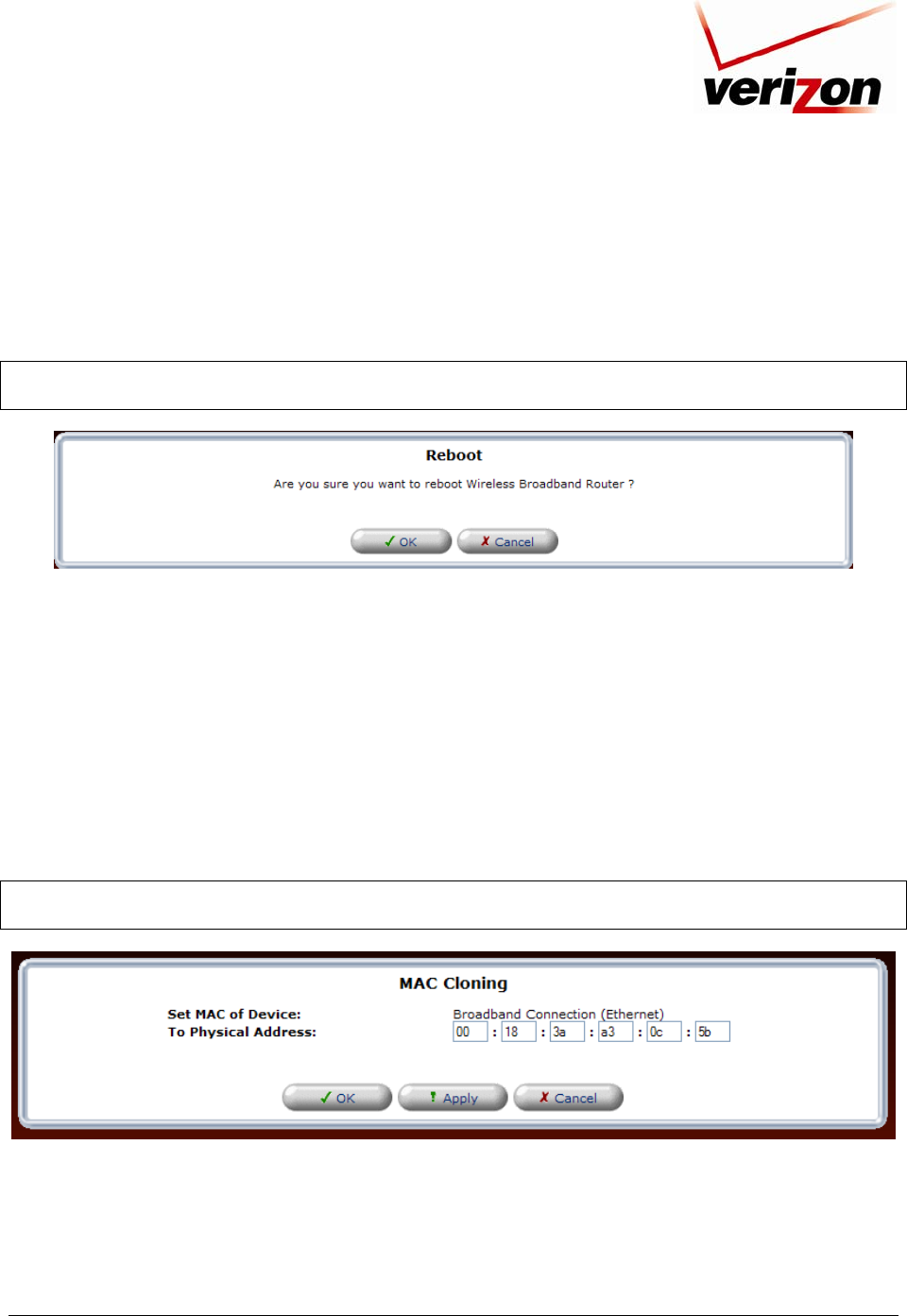
03/24/09 - DRAFT
030-300554 Rev. C 148 March 2009
Verizon FiOS Router
(
Model 9100EM
)
User Guide
15.3 Reboot
If you click the Reboot link in the Advanced screen, the following screen appears. Rebooting the Router allows the
Router to be restarted. Click OK to allow the Router to reboot. Please wait a brief moment while the Router is
rebooting. Afterwards, you will need to log in to the Router.
IMPORTANT: The Reboot feature does not reset the Router to factory default settings. If you want to reset the
Router to factory default settings, follow the instructions in section 15.2, “Restore Defaults.”
15.4 MAC Cloning
If you click the MAC Cloning link in the Advanced screen, the following screen appears. A Media Access Control
(MAC) address is a hexadecimal code that identifies a device on a network, such as a router. All networking devices
have a MAC address, and in some cases, your service provider may need you to provide the MAC address of your
network device. If you use MAC Cloning, you can simply enter the MAC address of the “old” Router into your
Verizon Router, bypassing the need to contact the service provider with “new” MAC Address values (from the
Verizon Router).
To configure MAC Cloning, enter the MAC Address of the Router you are replacing. Then, click Apply to save the
settings.
NOTE: By default, this screen displays the MAC address of the Verizon Router. Replace these values with the
MAC address of your “old” Router and click Apply.
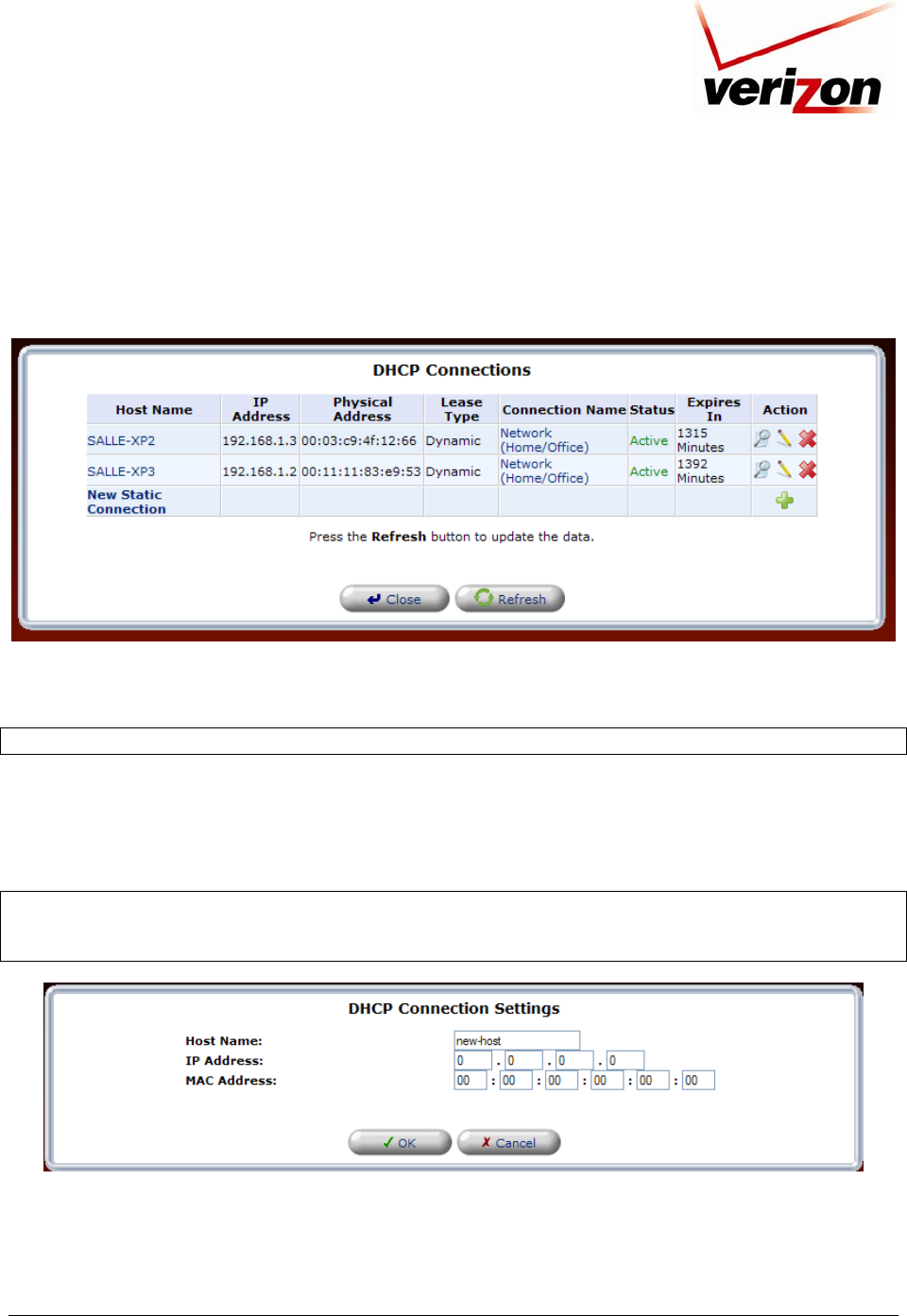
03/24/09 - DRAFT
030-300554 Rev. C 149 March 2009
Verizon FiOS Router
(
Model 9100EM
)
User Guide
15.5 ARP Table
If you click the ARP Table link in the Advanced screen, the following screen appears. This screen allows you to set
up static DHCP connections using Host Names, IP Addresses, or MAC addresses. To configure a static DHCP
connection, click the New Static Connection link.
If you clicked New Static Connection, the following screen appears. Enter the appropriate values in the fields
provided, and then click OK to continue.
NOTE: You can have a total of 253 static LAN devices connected to your Verizon Router.
• Enter a host name for this connection.
• Enter the fixed IP address to assign to the computer.
• Enter the MAC address of the computer’s network card.
NOTE: A device’s fixed IP address is actually assigned to the specific network card’s MAC address installed on the
network computer. If this network card is replaced, the device’s entry in the DHCP Connections list must be updated
with the new network card’s MAC address.
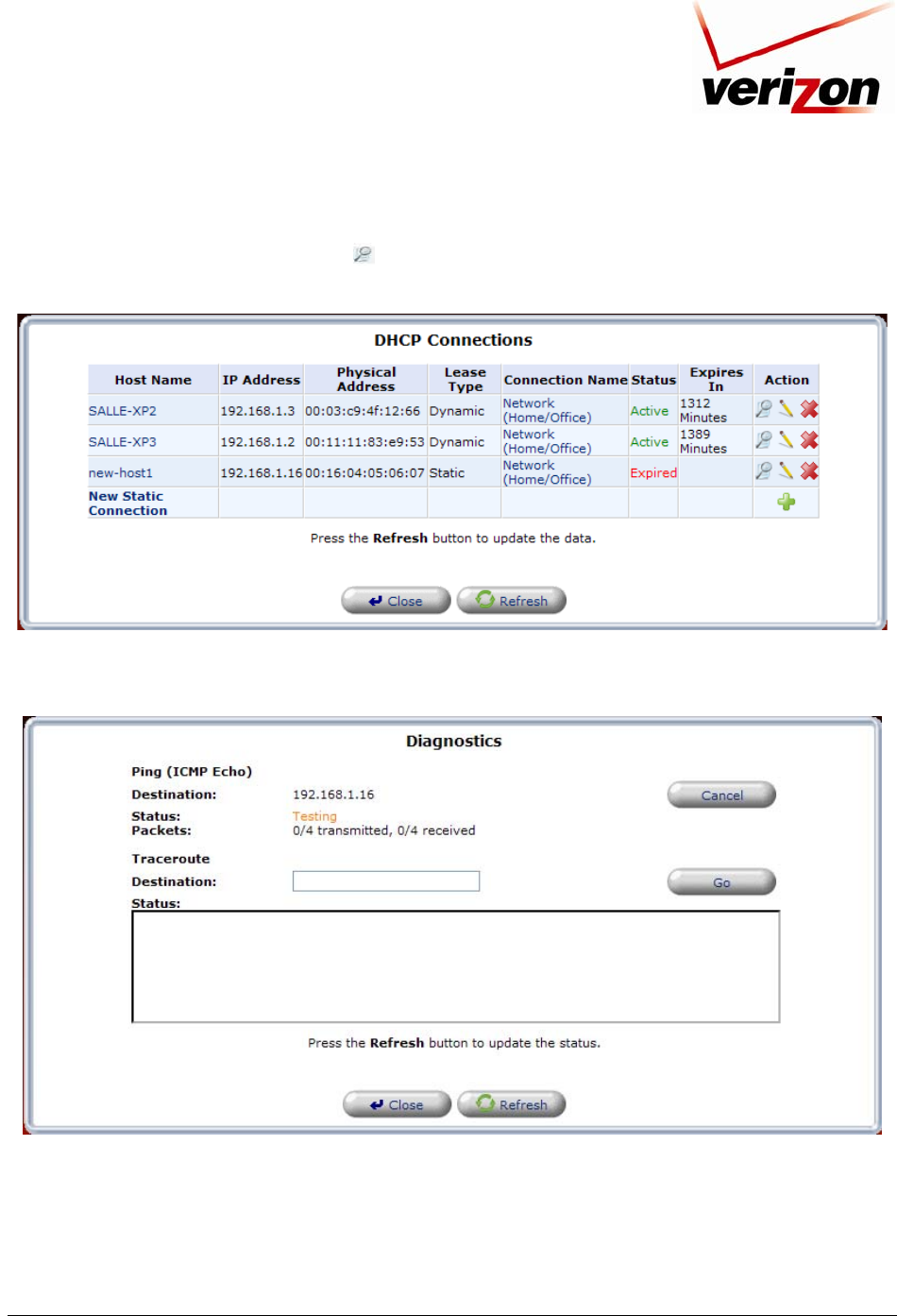
03/24/09 - DRAFT
030-300554 Rev. C 150 March 2009
Verizon FiOS Router
(
Model 9100EM
)
User Guide
For example, if you enter an IP Address and a MAC address and then click OK, the following screen appears. The
screen shows that the entry has been added to the list of static DHCP connections. To run a diagnostics test on a
DHCP connection, click the diagnostics icon adjacent to the connection you want to test. To remove a host from
the table, click the appropriate “X” icon in the Action column.
If you clicked the diagnostics icon, the following screen appears. Review the status of the diagnostics test, and then
click Close to return to the DHCP Connections screen.
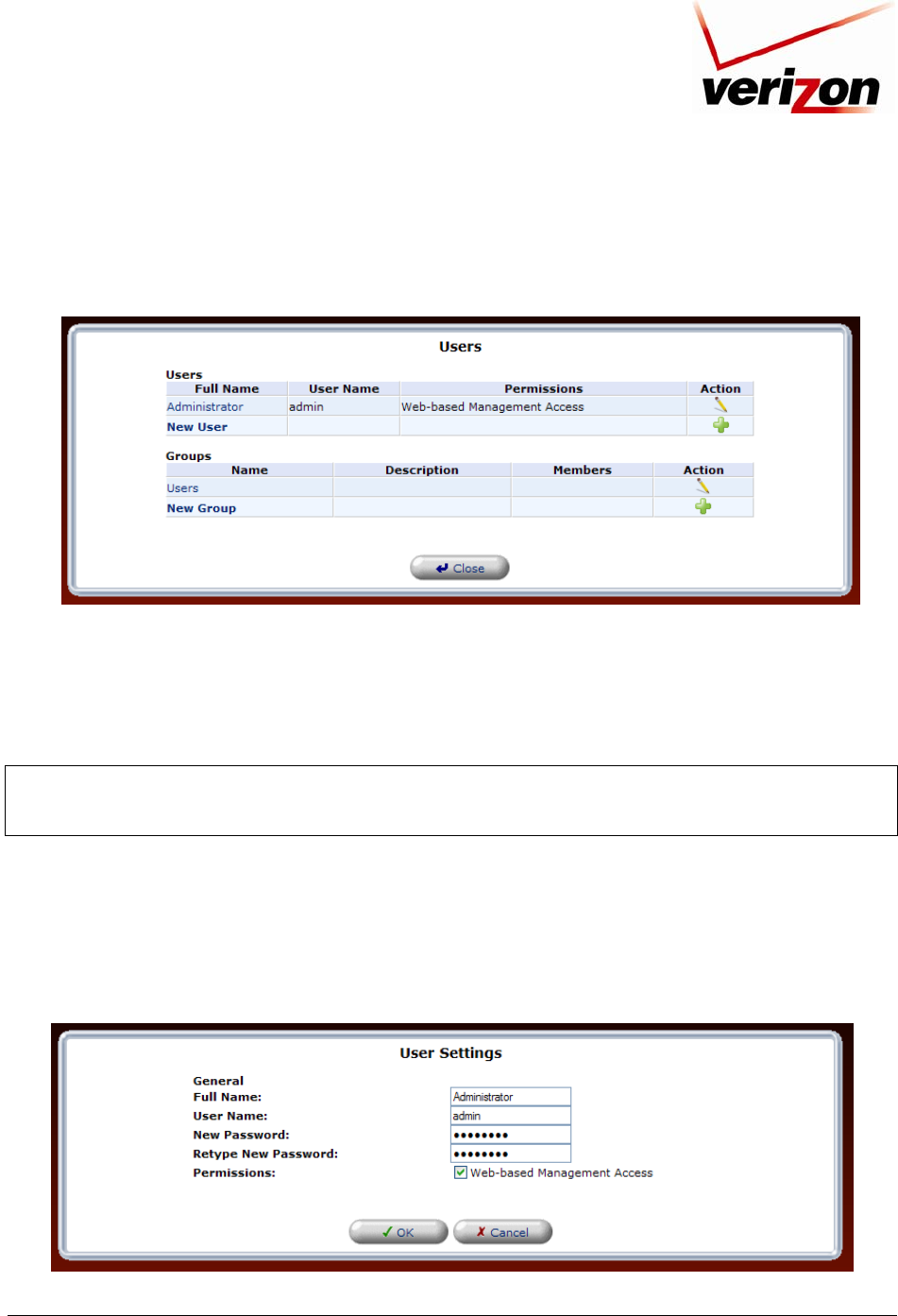
03/24/09 - DRAFT
030-300554 Rev. C 151 March 2009
Verizon FiOS Router
(
Model 9100EM
)
User Guide
15.6 Users
If you click the Users link in the Advanced screen, the following screen appears. This feature allows you to configure
user settings in the Router.
15.6.1 Users—Adding a New Administrator
If you click the Administrator link in the Users screen, the following screen appears. This screen allows you to set
up the desired Administrator values. Enter the appropriate values, and then click OK to save the changes.
NOTE: If the Router is password protected and you are not an authorized user, you will not be allowed to change
and save the values in this screen. (The Router cannot be configured unless the user is logged in.) Contact your
network administrator for further instructions.
• Full Name—Enter the user’s full name.
• User Name—Enter the name a remote user will use to access the home or office network. This field is case-
sensitive.
• New Password/Retype New Password—Enter the password for the user (and enter it again to confirm).
• Permissions—Click the check box to enable web-based management access.
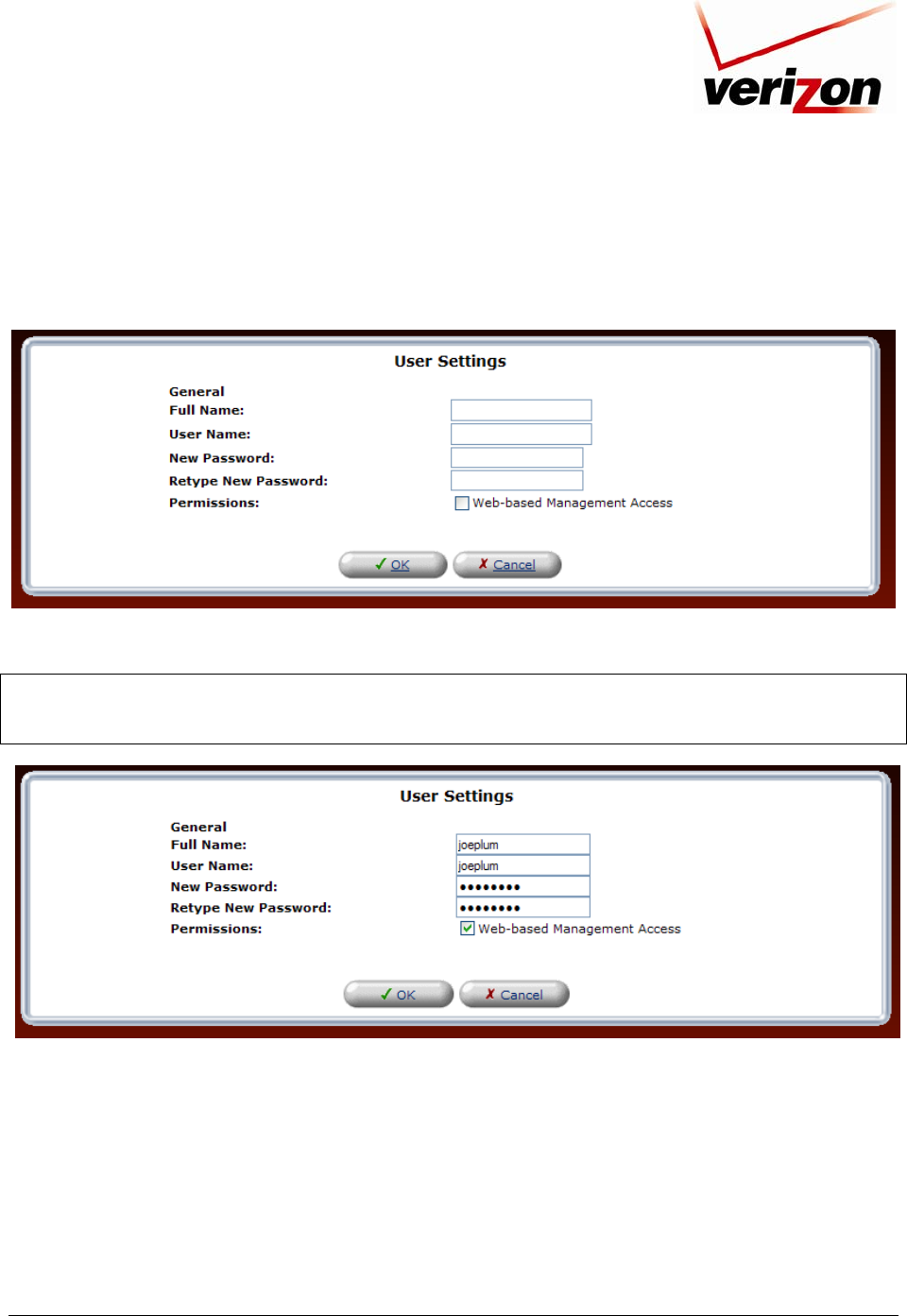
03/24/09 - DRAFT
030-300554 Rev. C 152 March 2009
Verizon FiOS Router
(
Model 9100EM
)
User Guide
15.6.2 Users—Adding a New User
If you click the New User link, the following screen appears. This screen allows specific users to have administrative
permissions in the Router.
To configure User Settings, enter the appropriate values, and then click OK to save the changes.
NOTE: The User Name and Password values must be at least 6 characters, and should consist of standard characters
only (ASCII 32-126), excluding the special character space and any of these characters :@"|\/=+<>[]*?,;. Also, user
names containing capital letters are not recommended. It might cause connectivity problems on Windows 98 hosts.
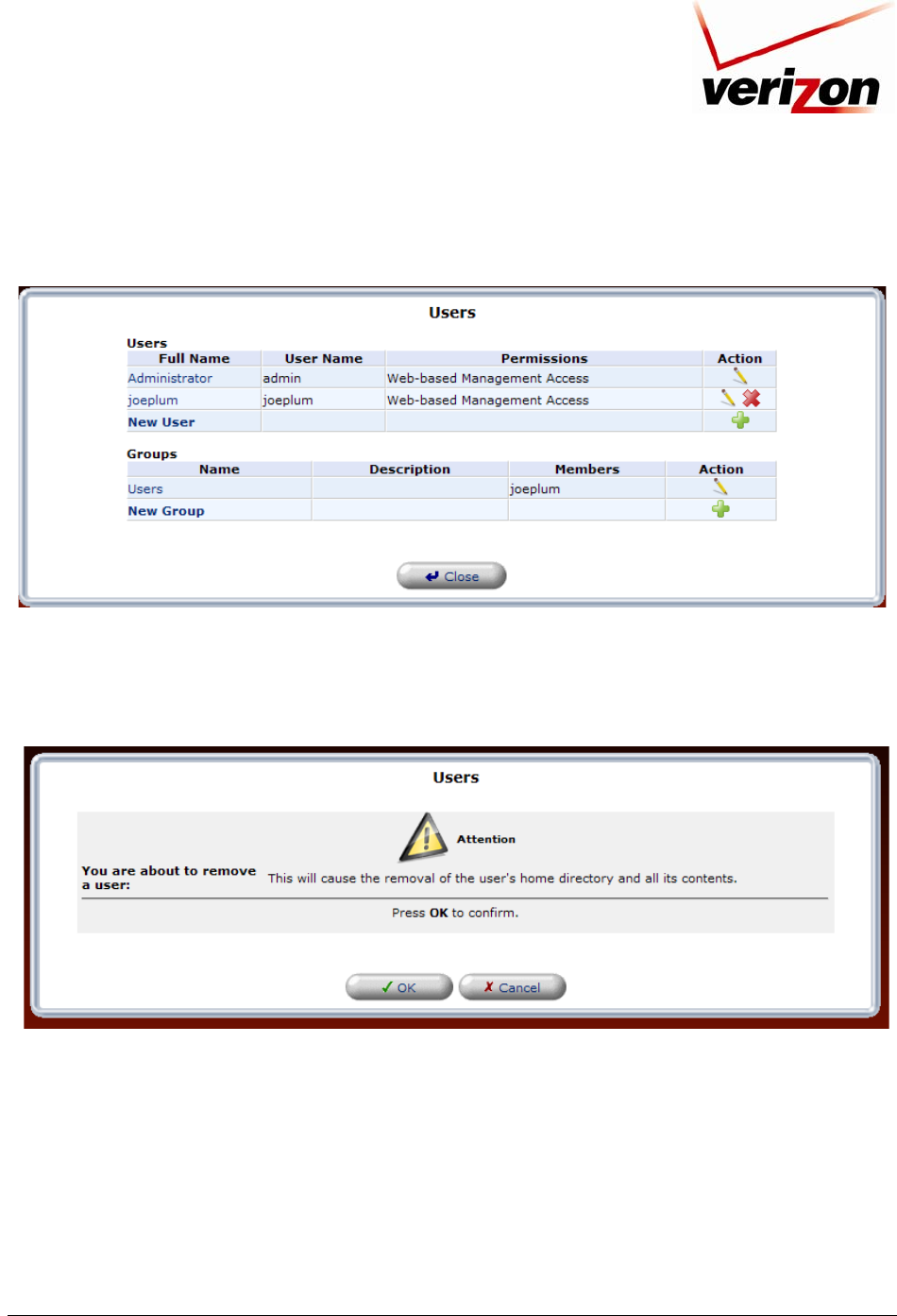
03/24/09 - DRAFT
030-300554 Rev. C 153 March 2009
Verizon FiOS Router
(
Model 9100EM
)
User Guide
After you have entered the appropriate values and click OK, the following screen appears. The user information has
been added to the Router. If desired, repeat the preceding instructions to add additional users to the administrator
permissions list.
15.6.3 Users—Removing a User
To remove a user from the list, click the “X” icon. The following screen appears. Click OK to continue.
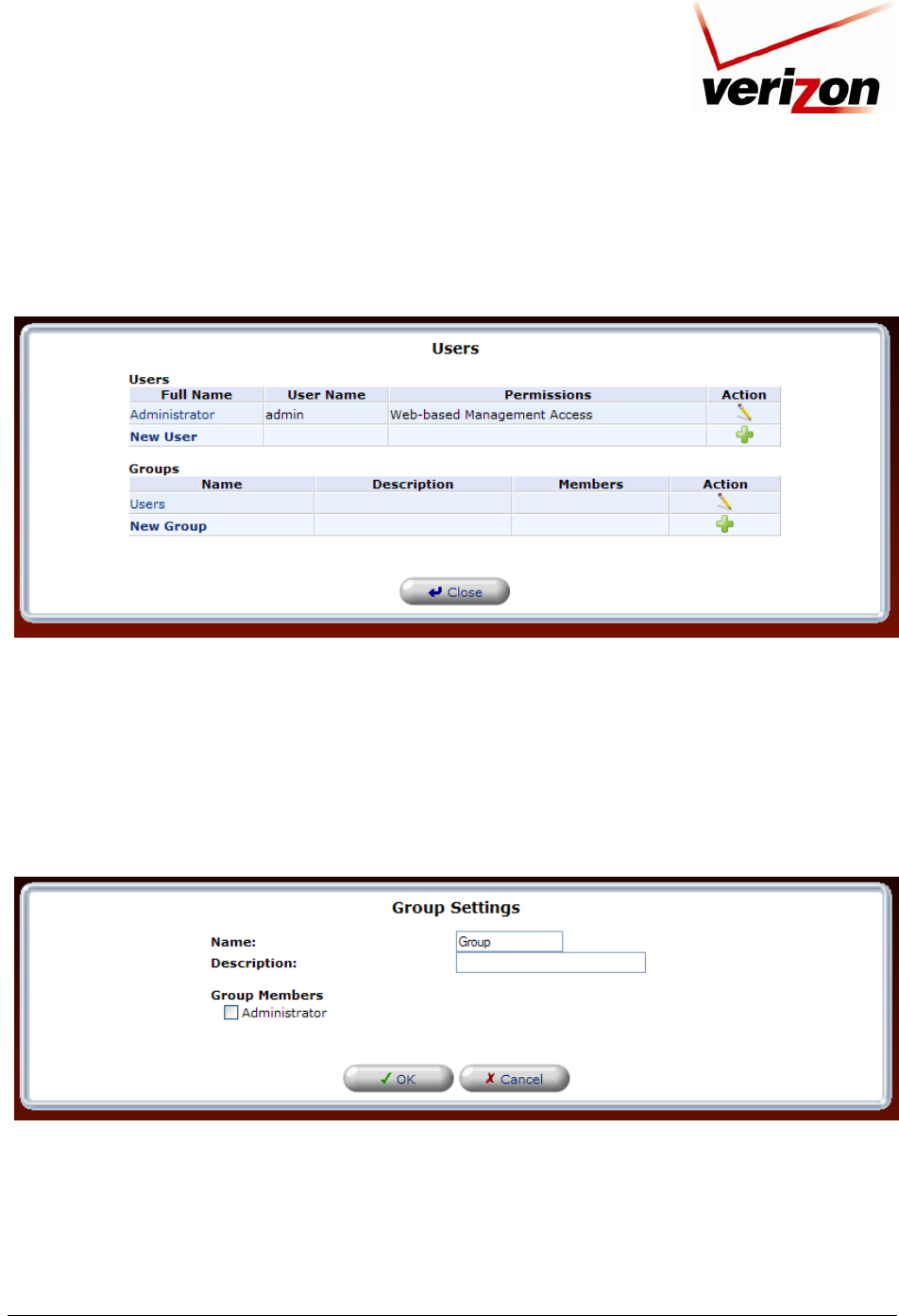
03/24/09 - DRAFT
030-300554 Rev. C 154 March 2009
Verizon FiOS Router
(
Model 9100EM
)
User Guide
15.6.4 Groups—Adding a New Group
To add a new group, click the New Group link.
If you clicked the New Group link, the following screen appears. Using this screen, you can configure additional
groups in the Router. At this screen, do the following:
1. Enter a Group Name of your choice.
2. Enter a description of your choice.
3. If you want to assign administrative permissions to the group, click the Group Members Administrator
check box; otherwise, leave this box empty.
4. Click OK to save the settings.
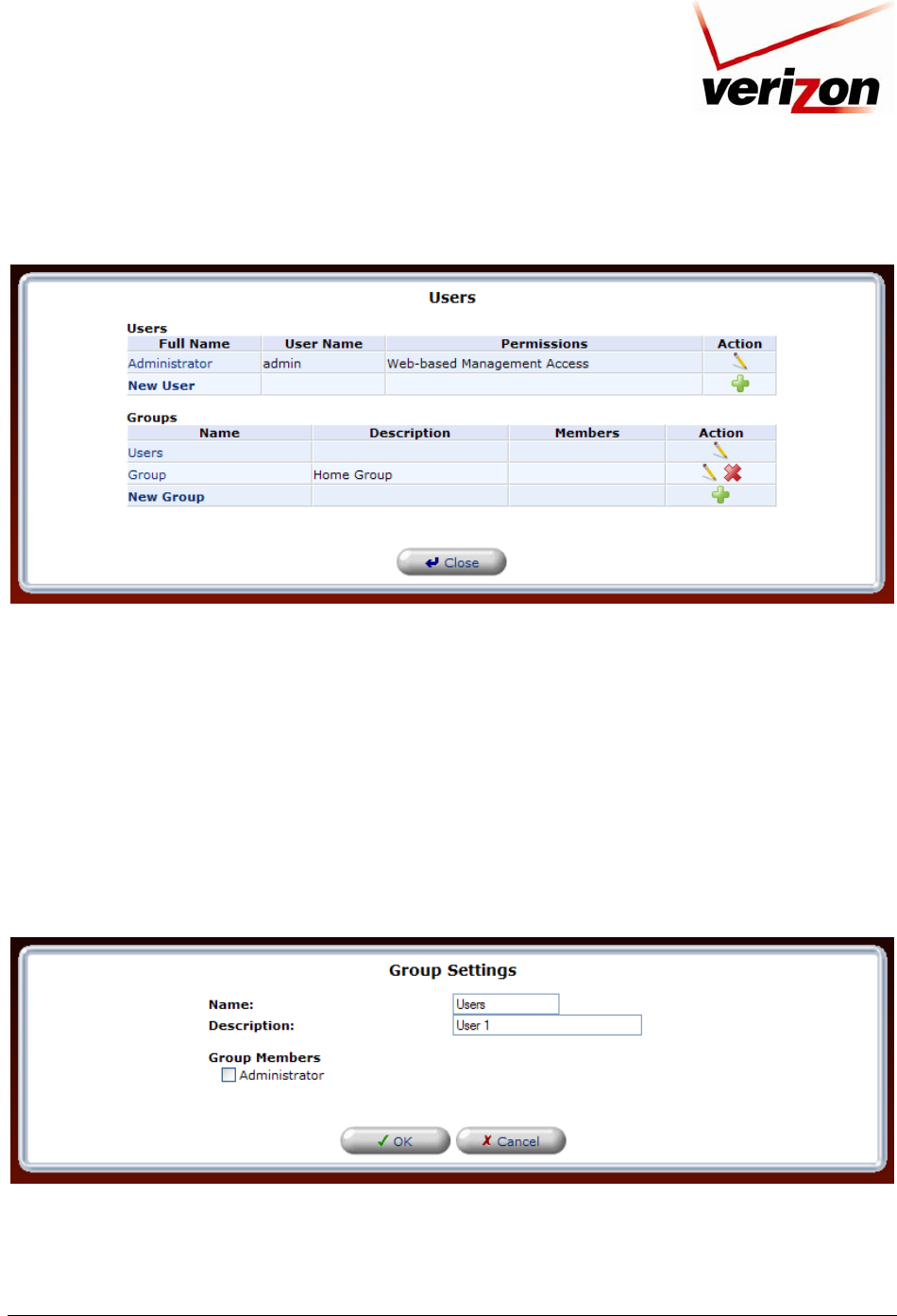
03/24/09 - DRAFT
030-300554 Rev. C 155 March 2009
Verizon FiOS Router
(
Model 9100EM
)
User Guide
After you have entered the desired values and clicked OK, the following screen will display the group attributes.
Click Close to return to the Advanced screen.
15.6.5 Groups—Add a User to a Group
To set up new users for a group, click the User link in the Groups section of the screen. The following screen
appears. Using this screen, you can assign users to a designated group.
At this screen, do the following:
1. Enter a User name of your choice.
2. Enter a description of your choice.
3. If you want to assign administrative permissions to the user, click the Group Members Administrator
check box; otherwise, leave this box empty.
4. Click OK to save the settings.
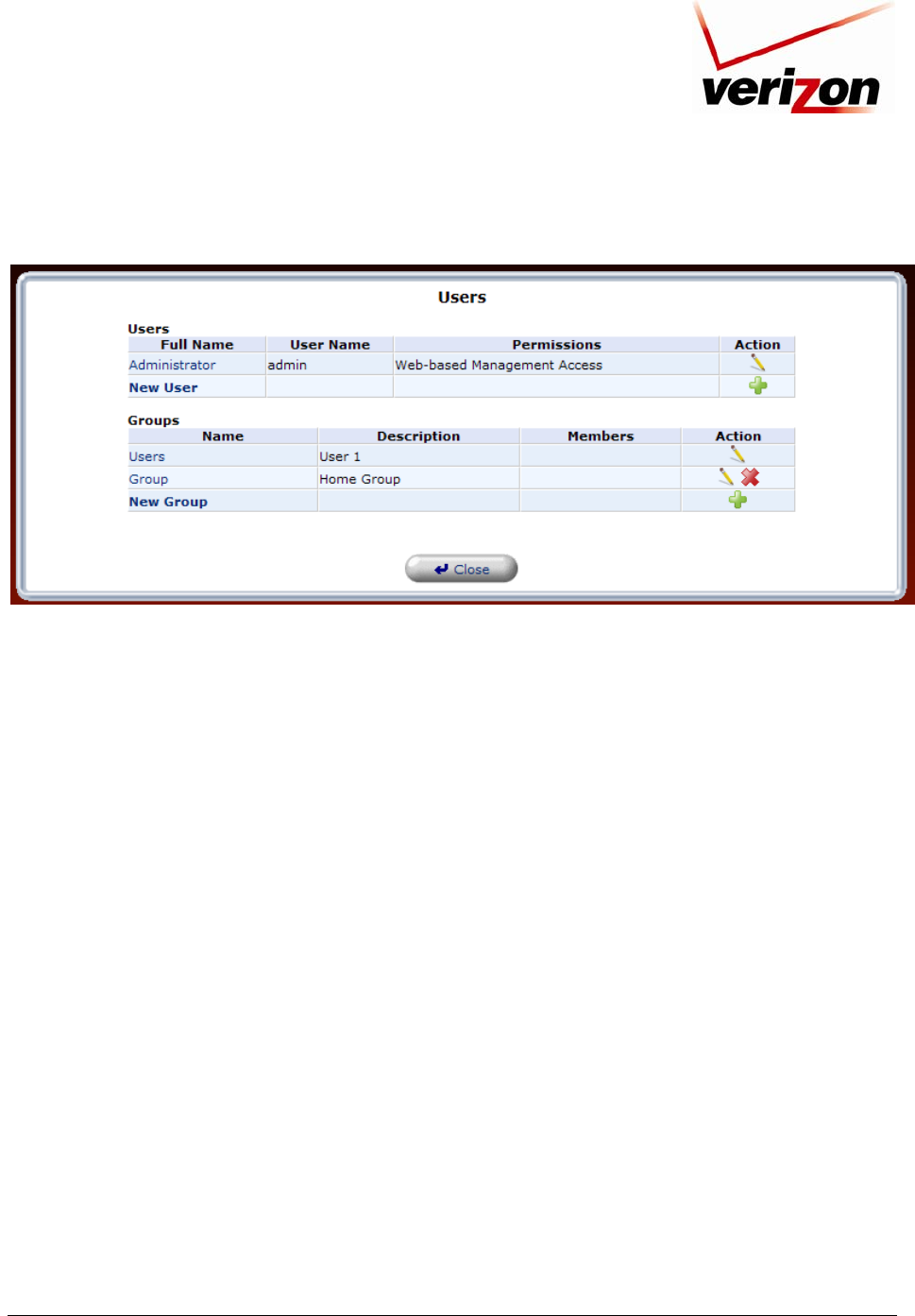
03/24/09 - DRAFT
030-300554 Rev. C 156 March 2009
Verizon FiOS Router
(
Model 9100EM
)
User Guide
After you have entered the desired values and clicked OK, the following screen will display the group attributes.
Click Close to return to the Advanced screen.

03/24/09 - DRAFT
030-300554 Rev. C 157 March 2009
Verizon FiOS Router
(
Model 9100EM
)
User Guide
15.7 Quality of Service
The QoS feature allows you to configure Quality of Service parameters in your Router. Network-based applications
and traffic are growing at a high rate, producing an ever-increasing demand for bandwidth and network capacity.
Bandwidth and capacity cannot be expanded infinitely, requiring that bandwidth-demanding services be delivered over
existing infrastructure, without incurring additional expensive investments. The next logical means of ensuring optimal
use of existing resources are Quality of Service (QoS) mechanisms for congestion management and avoidance. Quality
of Service refers to the capability of a network device to provide better service to selected network traffic. This is
achieved by shaping the traffic and processing higher priority traffic before lower priority traffic.
15.7.1 General
If you click the Quality of Service link in the Advanced screen, the following screen appears. This screen allows
you to configure general QoS settings. Enter the appropriate settings, and then click Apply.
NOTE: Choosing a new QoS profile will cause all previous QoS settings to be lost.
Before selecting the QoS profile that mostly suits your needs, select your bandwidth from this combo-box. If you do
not see an appropriate entry, select 'User Defined', and enter your Tx and Rx bandwidths manually.
• Enter your Tx bandwidth in Kbits per second.
• Enter your Rx bandwidth in Kbits per second.
Select the profile that mostly suits your bandwidth usage. Each profile entry displays a quote describing what the
profile is best used for, and the QoS priority levels granted to each bandwidth consumer in this profile.
• Default - No QoS preferences
• P2P User - Peer-to-peer and file sharing applications will receive priority
• Triple Play User - VoIP and video streaming will receive priority
• Home Worker - VPN and browsing will receive priority
• Gamer - Game-related traffic will receive priority
• Priority By Host - This entry provides the option to configure which computer in your LAN will receive the
highest priority and which the lowest. If you have additional computers, they will receive medium priority.
High Priority Host: Enter the host name or IP address of the computer to which you would like to grant the
highest bandwidth priority.
Low Priority Host: Enter the host name or IP address of the computer to which you would like to grant the
lowest bandwidth priority.
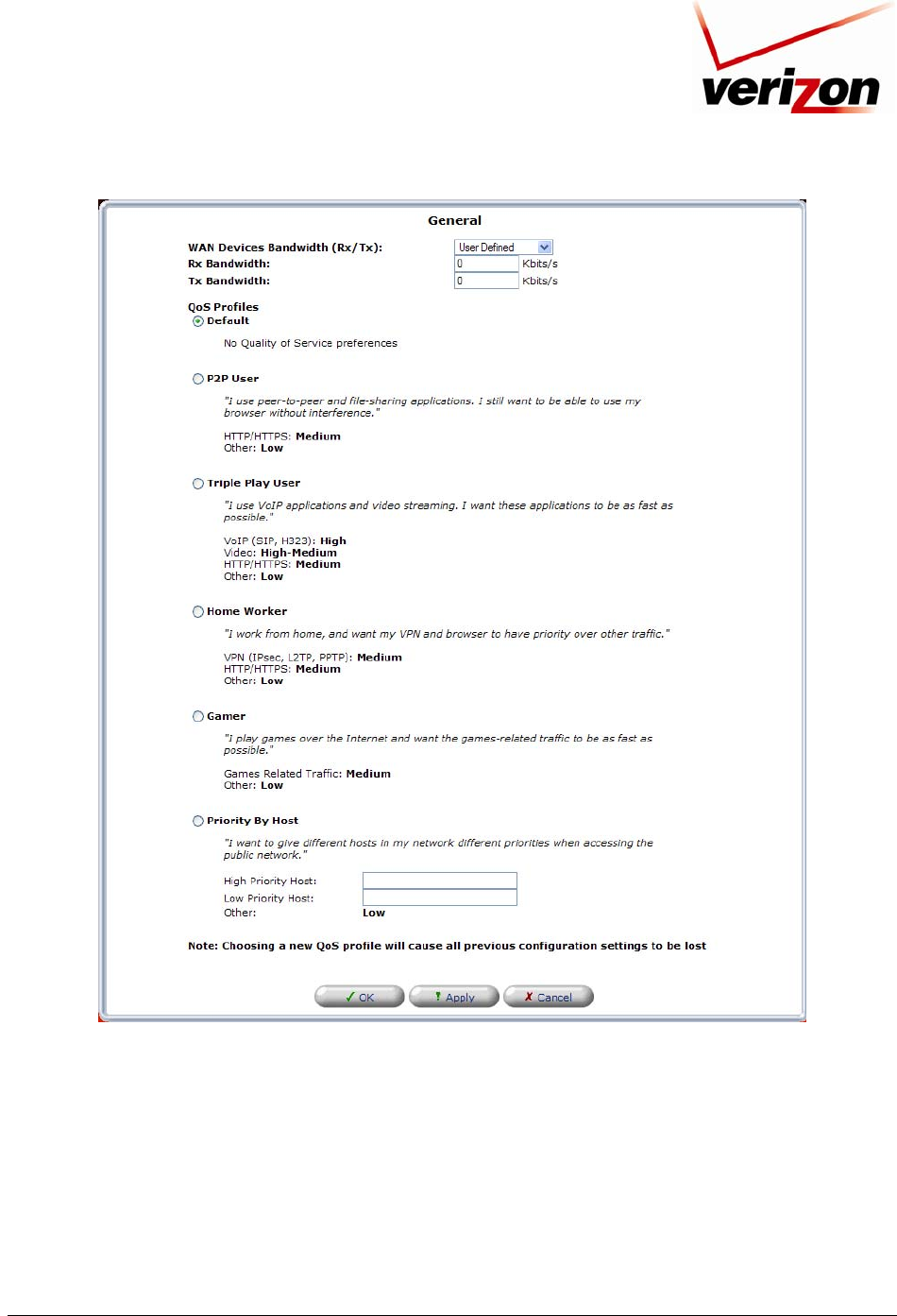
03/24/09 - DRAFT
030-300554 Rev. C 158 March 2009
Verizon FiOS Router
(
Model 9100EM
)
User Guide
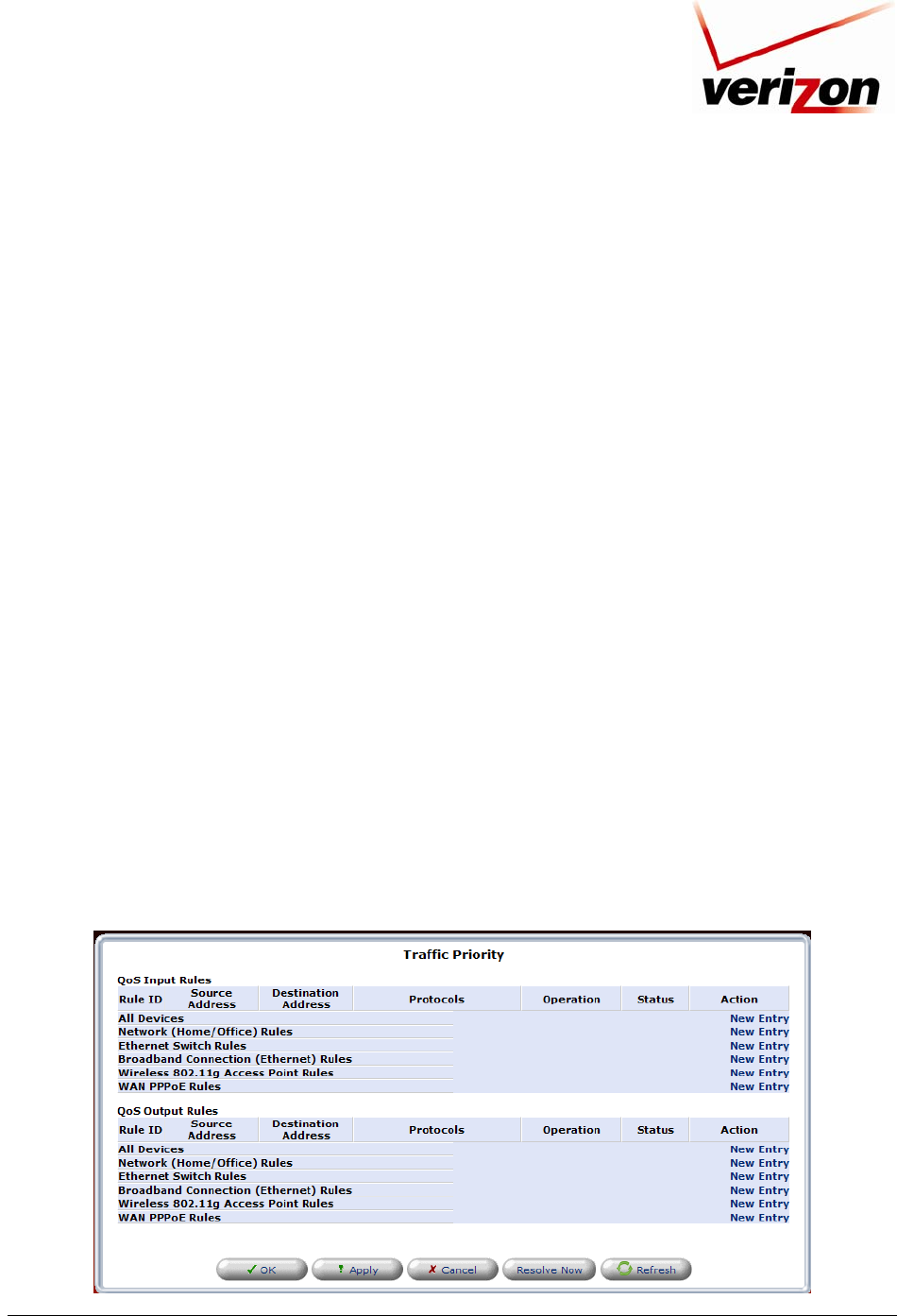
03/24/09 - DRAFT
030-300554 Rev. C 159 March 2009
Verizon FiOS Router
(
Model 9100EM
)
User Guide
15.7.2 Traffic Priority
If you click the Quality of Service link in the Advanced screen and then click Traffic Priority in the left submenu,
the following screen appears. This screen allows you to configure QoS to prioritize input and output traffic.
Traffic Priority manages and avoids traffic congestion by defining inbound and outbound priority rules for each
device on the Router. These rules determine the priority that packets, traveling through the device, will receive. QoS
parameters (DSCP marking and packet priority) are set per packet, on an application basis.
QoS can be configured using flexible rules, according to the following parameters:
• Source/destination IP address, MAC address, or host name
• Device
• Source/destination ports
• Limit the rule for specific days and hours
The Router supports two priority marking methods for packet prioritization:
• DSCP
• 802.1p Priority
The matching of packets by rules, also known as Stateful Packet Inspection is connection-based and uses the
Router’s firewall mechanism. Once a packet matches a rule, all subsequent packets with the same attributes receive
the same QoS parameters, both inbound and outbound.
A packet can match more than one rule. Therefore:
• The first class rule has precedence over all other class rules (scanning is stopped once the first rule is reached).
• The first traffic-priority (classless) rule has precedence over all other traffic-priority rules.
• There is no prevention of a traffic-priority rule conflicting with a class rule. In this case, the priority and DSCP
setting of the class rule (if given) will take precedence.
To set up a traffic priority rule, click the adjacent New Entry link for the input/output device you want to configure.
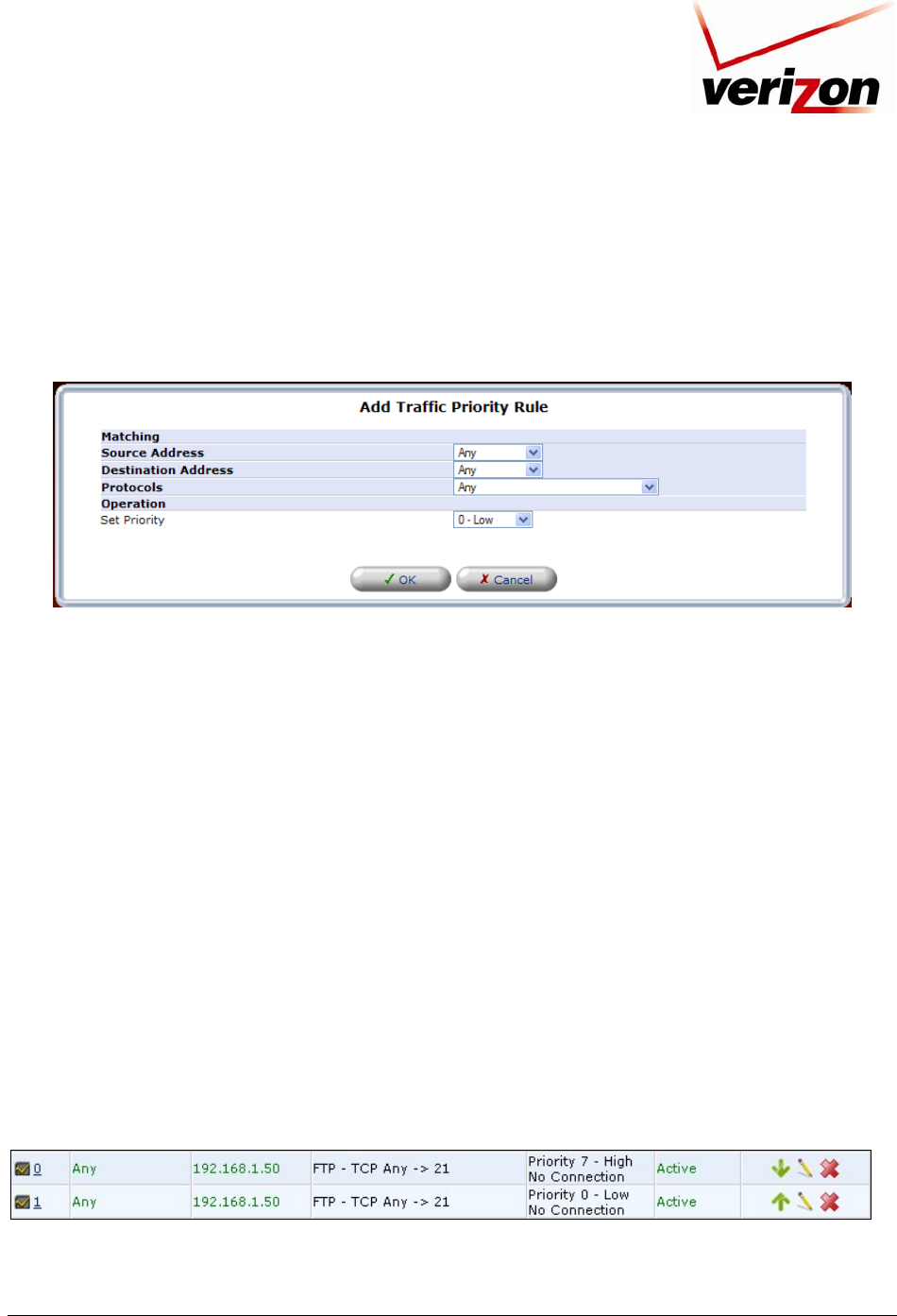
03/24/09 - DRAFT
030-300554 Rev. C 160 March 2009
Verizon FiOS Router
(
Model 9100EM
)
User Guide
If you clicked New Entry, the following screen appears. At this screen, do the following:
1. Select the desired Source Address, Destination Address, and Protocol options from the drop-down lists.
2. Click the Device check box if you will apply the settings to a device. By default this box is cleared.
3. Select the desired option from the Set Priority drop-down list. (Zero is the lowest priority level.)
4. Click OK to save the settings.
Source Address—The source address of packets sent or received from the LAN computer. The drop-down list
displays all the host names or IP addresses of currently connected LAN computers, as well as the options 'Any' and
'User Defined'. Select an address from the list, or select Any to apply the rule on all computers. If you would like
add a new address, select the User Defined option in the drop-down list. This will commence a sequence that will
add a new network object, representing the LAN computer. The network object may be an IP address, subnet or
range, a MAC address or a host name.
Destination Address—The destination address of packets sent or received from the network object. This address can
be configured in the same manner as the source address. This entry enables further filtration of the packets.
Protocols—You may also specify a traffic protocol. Selecting the Show All Services option in the drop-down list
will expand the list of available protocols. Select a protocol or add a new one using the User Defined option. This
will commence a sequence that will add a new service, representing the protocol.
Operation—Set rule priority with Quality of Service:
Set Priority—Check this check-box to add a priority to the rule then select between one of eight priority
levels, zero being the lowest and seven the highest (each priority level is mapped to low/medium/high
priority). This sets the priority of a packet on the connection matching the rule, while routing the packet.
The order of the rules' appearance represents both the order in which they were defined and the sequence
by which they will be applied. You may change this order after your rules are already defined (without having
to delete and then re-add them), by using the Move Up and Move Down action icons as shown in the following
image.
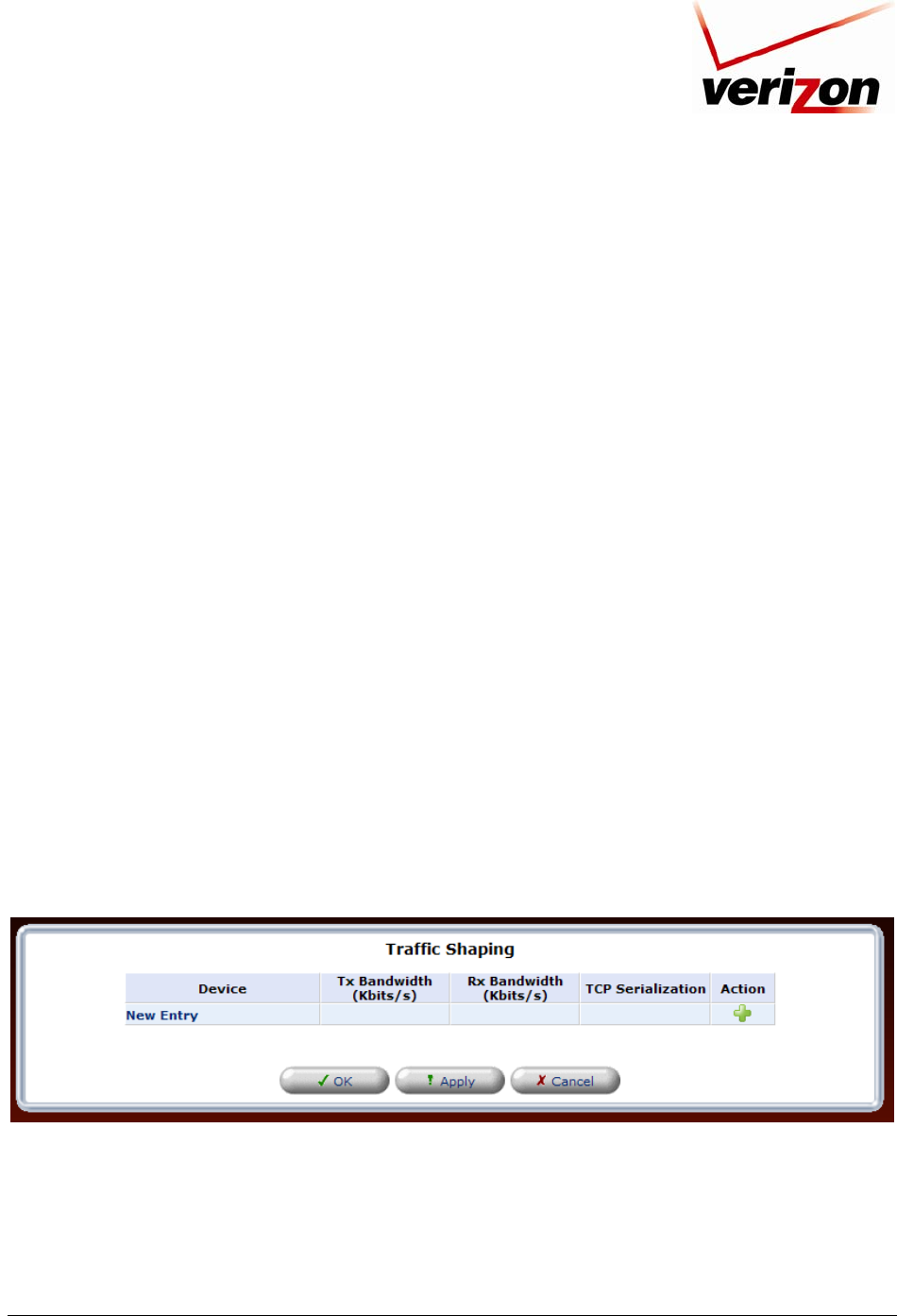
03/24/09 - DRAFT
030-300554 Rev. C 161 March 2009
Verizon FiOS Router
(
Model 9100EM
)
User Guide
15.7.3 Traffic Shaping
If you click the Quality of Service link in the Advanced screen and then click Traffic Shaping in the left submenu,
the following screen appears.
Traffic Shaping is the solution for managing and avoiding congestion where the network meets limited broadband
bandwidth. Typical networks use a 100 Mbps Ethernet LAN with a 100 Mbps WAN interface router. This is where
most bottlenecks occur. A traffic shaper is essentially a regulated queue that accepts uneven and/or bursty flows of
packets and transmits them in a steady, predictable stream so that the network is not overwhelmed with traffic.
While traffic priority allows basic prioritization of packets, traffic shaping provides more sophisticated definitions,
such as:
• Bandwidth limit for each device
• Bandwidth limit for classes of rules
• Prioritization policy
• TCP serialization on a device
Additionally, QoS traffic shaping rules can be defined for a default device. These rules will be used on a device that
has no definitions of its own. This enables the definition of QoS rules on the default WAN, for example, and their
maintenance even if the PPP or bridge device over the WAN is removed.
The matching of packets by rules is connection-based, known as Stateful Packet Inspection (SPI ), using the
Router’s firewall mechanism. Once a packet matches a rule, all subsequent packets with the same attributes receive
the same QoS parameters, both inbound and outbound. Connection-based QoS also allows inheriting QoS
parameters by some of the applications that open subsequent connections. For instance, QoS rules can be defined on
SIP, and the rules will apply to both control and data ports (even if the data ports are unknown). Applications that
support such inheritance have an application-level gateway (ALG) in the firewall.
To add a traffic shaping rule, click the New Entry link.
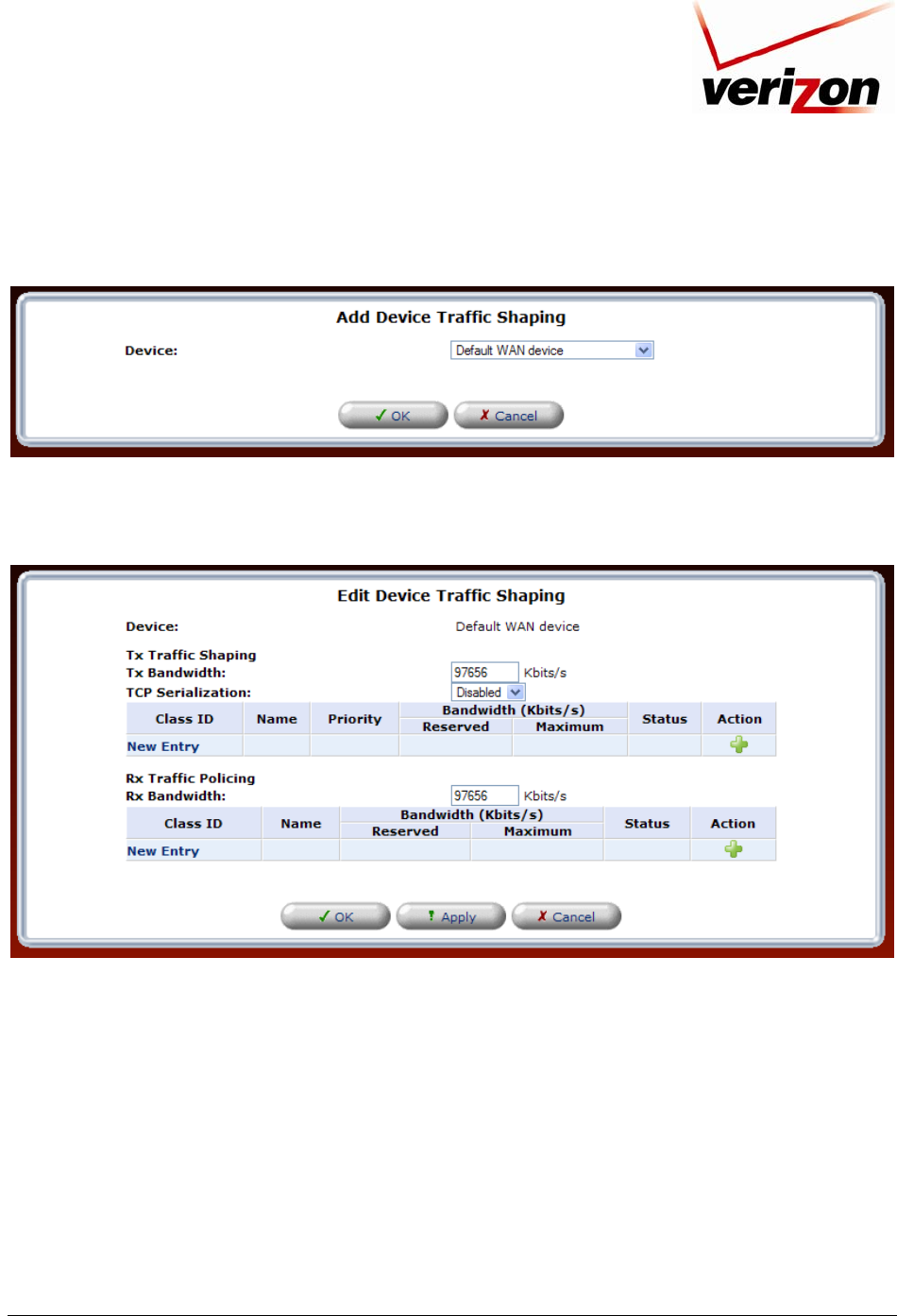
03/24/09 - DRAFT
030-300554 Rev. C 162 March 2009
Verizon FiOS Router
(
Model 9100EM
)
User Guide
If you clicked New Entry, the following screen appears. Select a device from the Device drop-down list. Then, click
OK to continue.
After you have selected a device and clicked OK in the preceding screen, the following screen appears. Enter the
bandwidth values for transmit (Tx) and receive (Rx), and then select the desired option from the TCP Serialization
drop-down list. Next, click the desired New Entry link to add a class.
Tx Traffic Shaping
The bandwidth of a device can be divided in order to reserve constant portions of bandwidth to predefined
traffic types. Such a portion is known as a Shaping Class. When not used by its predefined traffic type, or
owner (for example VoIP), the class will be available to all other traffic. However when needed, the entire
class is reserved solely for its owner. Moreover, you can limit the maximum bandwidth that a class can use
even if the entire bandwidth is available. Configure the following fields:
Tx Bandwidth
This parameter limits the gateway's bandwidth transmission rate. The purpose is to limit the bandwidth of the WAN
device to that of the weakest outbound link, for instance, the DSL speed provided by the ISP. This forces the router
to be the network bottleneck, where sophisticated QoS prioritization can be performed. If the device's bandwidth is
not limited correctly, the bottleneck will be in an unknown router or modem on the network path, rendering this
router’s QoS useless.
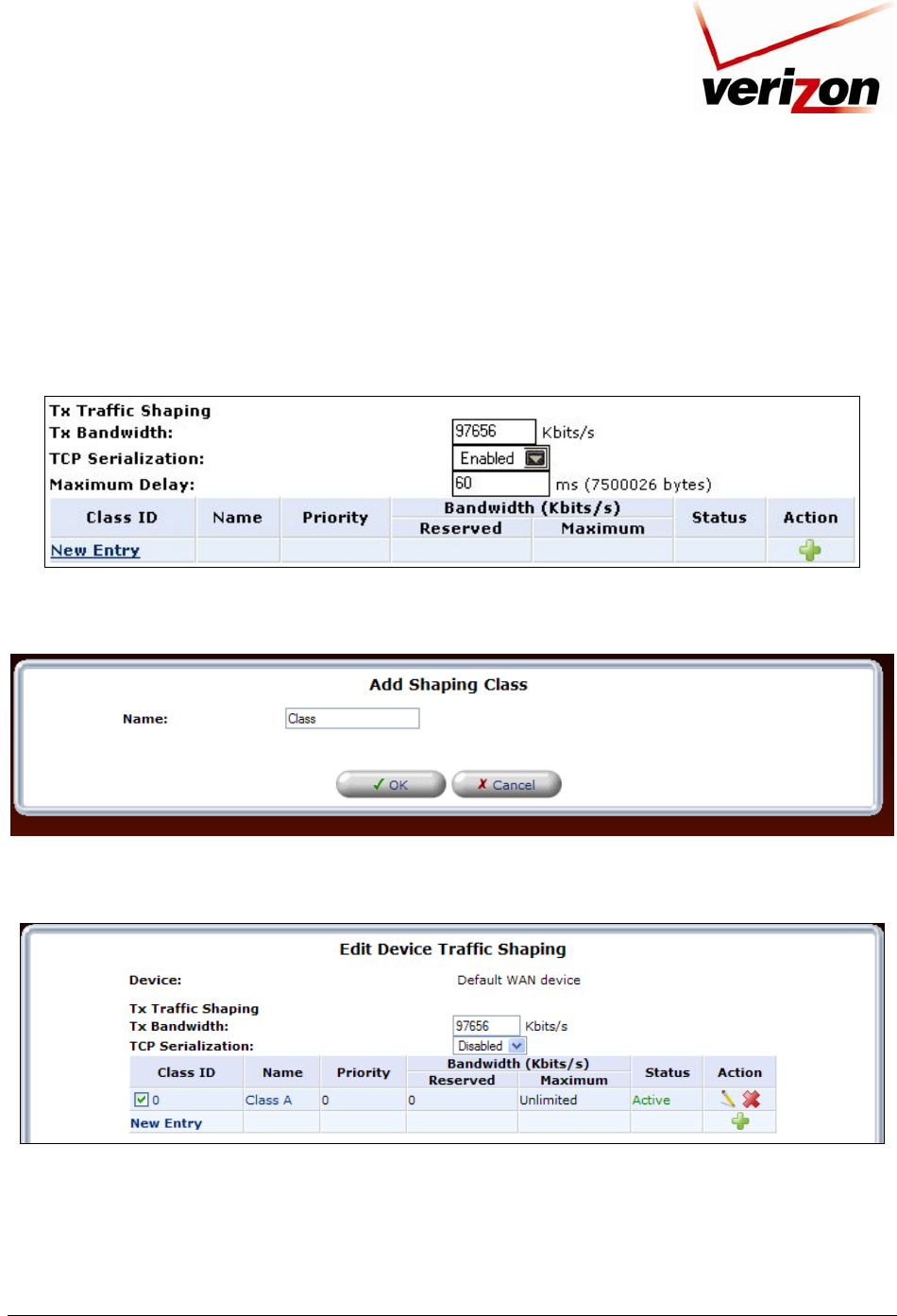
03/24/09 - DRAFT
030-300554 Rev. C 163 March 2009
Verizon FiOS Router
(
Model 9100EM
)
User Guide
TCP Serialization
You can enable TCP Serialization in its combo box, either for active voice calls only or for all traffic. The screen
will refresh, adding a 'Maximum Delay' field. This function allows you to define the maximal allowed transmission
time frame (in milliseconds) of a single packet. Any packet that requires a longer time to be transmitted, will be
fragmented to smaller sections. This avoids transmission of large, bursty packets that may cause delay or jitter for
real-time traffic such as VoIP. If you insert a delay value in milliseconds, the delay in number of bytes will be
automatically updated on refresh.
For example, if you click the New Entry link in the Tx Traffic Shaping section of the Edit Device Traffic Shaping
screen the Add Shaping Class screen will appear.
Name the new class and click OK to save the settings, e.g., Class A. Now click the class name to edit the shaping
class or alternatively, click its pencil (edit) icon in the Action column.
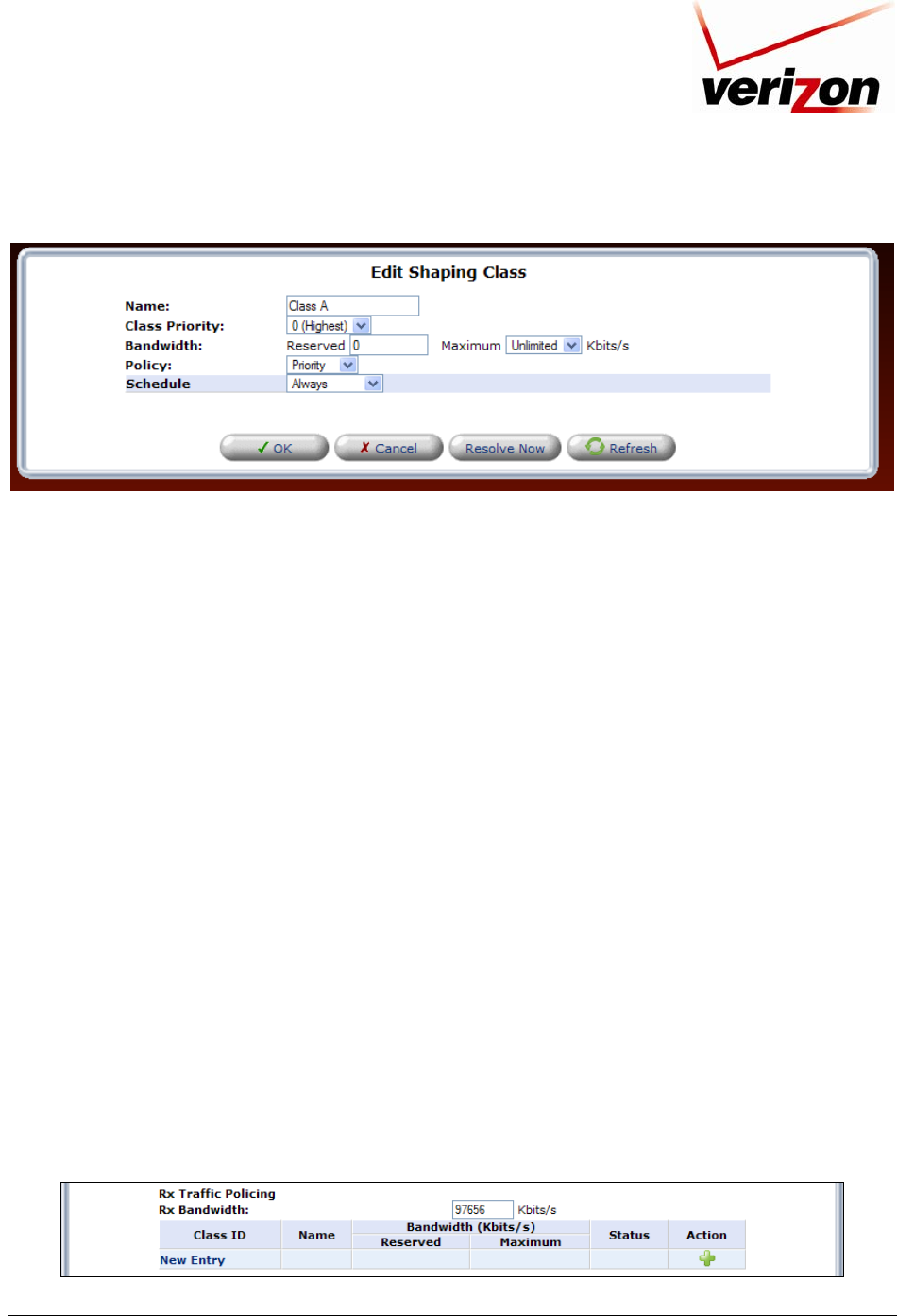
03/24/09 - DRAFT
030-300554 Rev. C 164 March 2009
Verizon FiOS Router
(
Model 9100EM
)
User Guide
If you clicked the edit icon in the preceding screen, the Edit Shaping Class screen will appear.
Configure the following fields by entering or selecting the desired values:
Name—The name of the class.
Class Priority—The class can be granted one of eight priority levels, zero being the highest and seven the lowest
(note the obversion when compared to the rules priority levels). This level sets the priority of a class in comparison
to other classes on the device.
Bandwidth—The reserved transmission bandwidth in kilo-bits per second. You can limit the maximum allowed
bandwidth by selecting Specify in the drop-down list. The screen will refresh, adding yet another Kbits/s.
Policy—The class policy determines the policy of routing packets inside the class. Select one of the four options:
Priority—Priority queuing utilizes multiple queues, so that traffic is distributed among queues based on
priority. This priority is defined according to packet's priority, which can be defined explicitly, by a DSCP
value, or by a 802.1p value.
FIFO—The “First In, First Out” priority queue. This queue ignores any previously-marked priority that
packets may have.
Fairness—The fairness algorithm ensures no starvation by granting all packets a certain level of priority.
RED— The Random Early Detection algorithm utilizes statistical methods to drop packets in a
“probabilistic” way before queues overflow. Dropping packets in this way slows a source down enough to
keep the queue steady and reduces the number of packets that would be lost when a queue overflows and a
host is transmitting at a high rate.
Schedule—By default, the class will always be active. However, you can configure scheduler rules in order
to define time segments during which the class may be active. Refer to section 15.21, “Scheduler Rule,” for details
on setting up schedule rules.
Rx Traffic Policing: Allows you to configure the following fields:
Rx Bandwidth This parameter specifies the maximum traffic the policing can receive from the ISP.
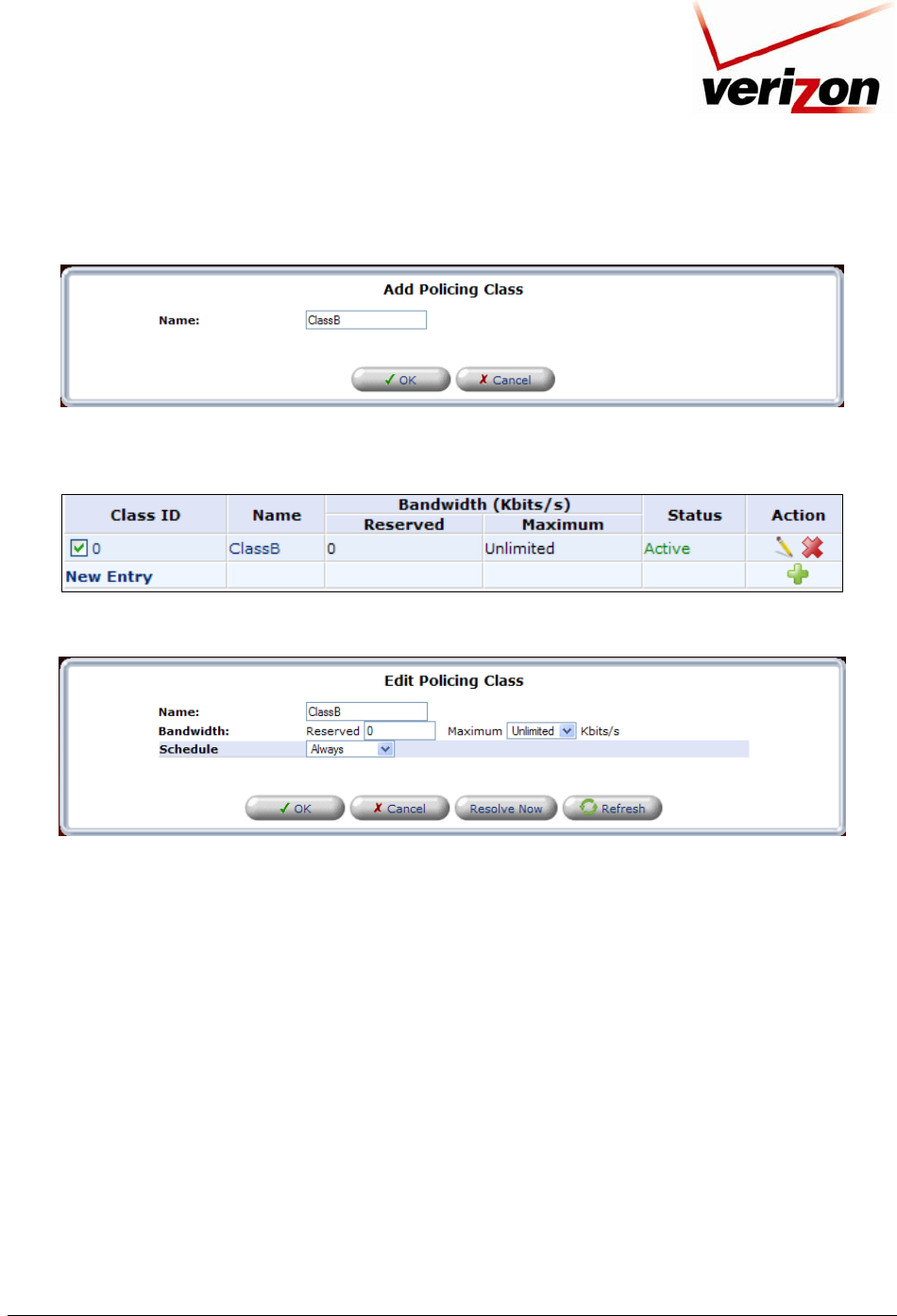
03/24/09 - DRAFT
030-300554 Rev. C 165 March 2009
Verizon FiOS Router
(
Model 9100EM
)
User Guide
For example, if you click the New Entry link in the Rx Traffic Policing section of the Edit Device Traffic
Shaping screen, the Add Policing Class screen will appear.
Name the new class and click OK to save the settings, e.g. Class B. Next, click the class name to edit the shaping
class or alternatively, click its pencil (edit) action icon in the Action column.
The Edit Policing Class screen will appear.
Configure the following fields:
Name—The name of the class.
Bandwidth—The reserved reception bandwidth in kilo-bits per second. You can limit the maximum allowed
bandwidth by selecting the 'Specify' option in the combo box. The screen will refresh, adding yet another Kbits/s
field.
Schedule—By default, the class will always be active. However, you can configure scheduler rules in order to define
time segments during which the class may be active. Refer to section 15.21, “Scheduler Rules,” for details on setting
up schedule rules.
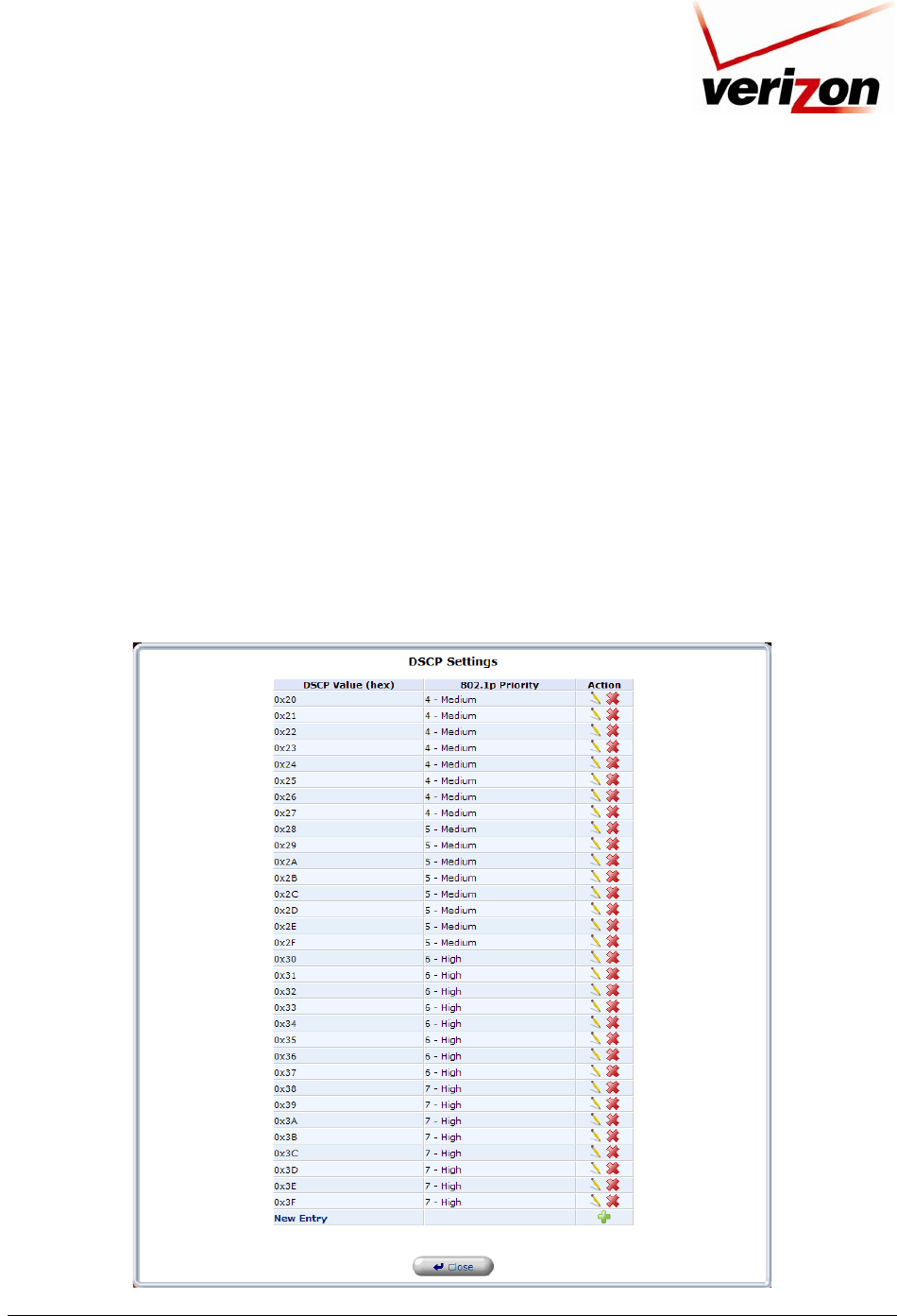
03/24/09 - DRAFT
030-300554 Rev. C 166 March 2009
Verizon FiOS Router
(
Model 9100EM
)
User Guide
15.7.4 Differentiated Service Code Point (DSCP) Settings
If you click the Quality of Service link in the Advanced screen and then click DSCP Settings in the left submenu,
the following screen appears.
Familiarity with the Differentiated Services model is essential to understanding DSCP. Differentiated Services
(Diffserv) is a Class of Service (CoS) model that enhances best-effort Internet services by differentiating traffic by
users, service requirements, and other criteria. Packets are specifically marked, allowing network nodes to provide
different levels of service, as appropriate for voice calls, video playback, or other delay-sensitive applications, via
priority queuing or bandwidth allocation, or by choosing dedicated routes for specific traffic flows.
Diffserv defines a field in IP packet headers referred to as the Differentiated Services Codepoint (DSCP). Hosts or
routers passing traffic to a Diffserv-enabled network will typically mark each transmitted packet with an appropriate
DSCP. The DSCP markings are used by Diffserv network routers to appropriately classify packets and to apply a
particular queue handling or scheduling behavior to packets.
The Router provides a table of predefined DSCP values, which are mapped to 802.1p priority marking method. Any
of the existing DSCP setting can be edited or deleted, and new entries can be added. To add a new DSCP value,
press the New Entry link at the bottom of this screen.
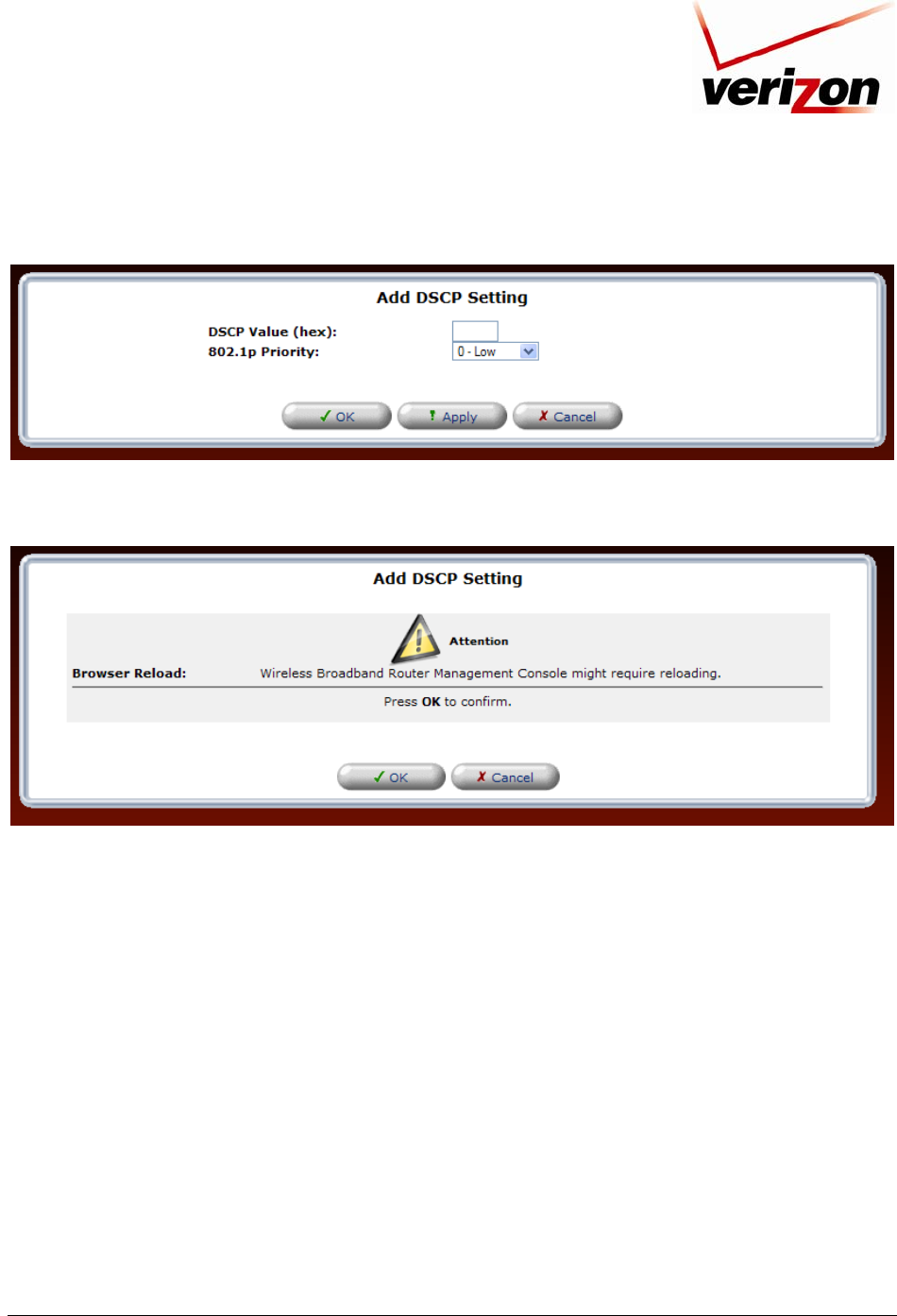
03/24/09 - DRAFT
030-300554 Rev. C 167 March 2009
Verizon FiOS Router
(
Model 9100EM
)
User Guide
If you clicked New Entry, the following screen appears. Enter your hexadecimal value, and then set the priority for
this value. Click Apply to continue.
If you clicked Apply, the following screen appears. Click OK to confirm. Value will be added to the DSCP
Settings screen.
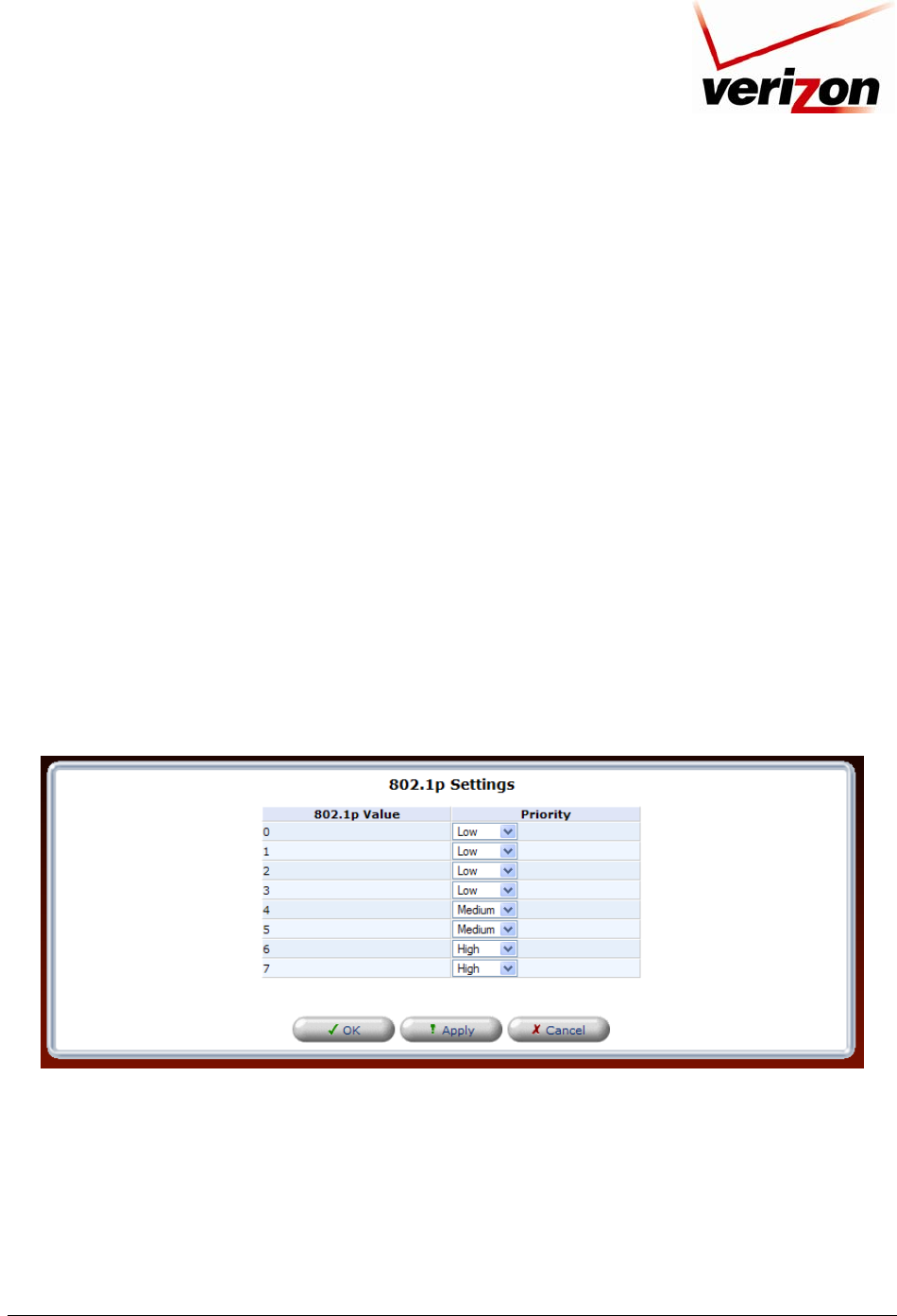
03/24/09 - DRAFT
030-300554 Rev. C 168 March 2009
Verizon FiOS Router
(
Model 9100EM
)
User Guide
15.7.5 802.1P Settings
If you click the Quality of Service link in the Advanced screen and then click 802.1P Settings in the left submenu,
the following screen appears.
The IEEE 802.1p priority marking method is a standard for prioritizing network traffic at the data link/Mac sub-
layer. 802.1p traffic is simply classified and sent to the destination, with no bandwidth reservations established.
The 802.1p header includes a 3-bit prioritization field, which allows packets to be grouped into eight levels of
priority. By default, the highest priority is seven, which might be assigned to network-critical traffic. Values five and
six may be applied to delay-sensitive applications such as interactive video and voice. Data classes four through one
range from controlled-load applications down to “loss eligible” traffic. Zero is the value for unassigned traffic and is
used as a best effort default, invoked automatically when no other value has been set.
A packet can match more than one rule. This means the following:
• The first class rule has precedence over all other class rules (scanning is stopped once the first rule is
reached).
• The first traffic-priority (classless) rule has precedence over all other traffic priority rules.
• There is no prevention of a traffic-priority rule conflicting with a class rule. In this case, the priority and
DSCP setting of the class rule (if given) will take precedence.
Select the desired values from the drop-down lists, and then click Apply to save the settings.
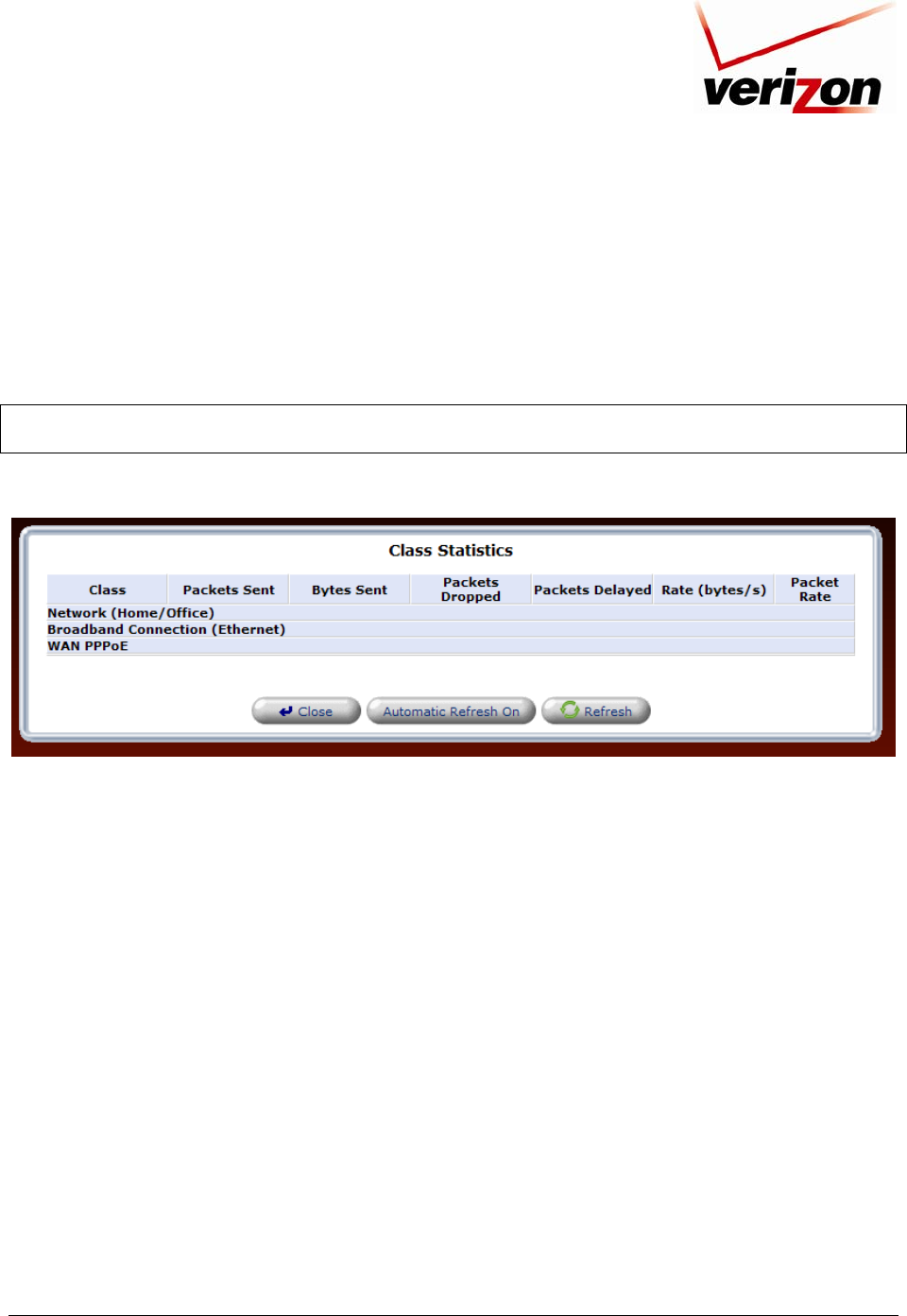
03/24/09 - DRAFT
030-300554 Rev. C 169 March 2009
Verizon FiOS Router
(
Model 9100EM
)
User Guide
15.7.6 Class Statistics
If you click the Quality of Service link in the Advanced screen and then click Class Statistics in the left submenu,
the following screen appears.
The Router provides accurate, real-time information on the traffic moving through the defined device classes. For
example, the amount of packets sent, dropped, or delayed are just a few of the parameters monitored per each
shaping class.
NOTE: Class statistics will be available only after defining at least one class (otherwise the screen will not display
any values).
If you do not want the screen to refresh automatically, click Automatic Refresh Off.
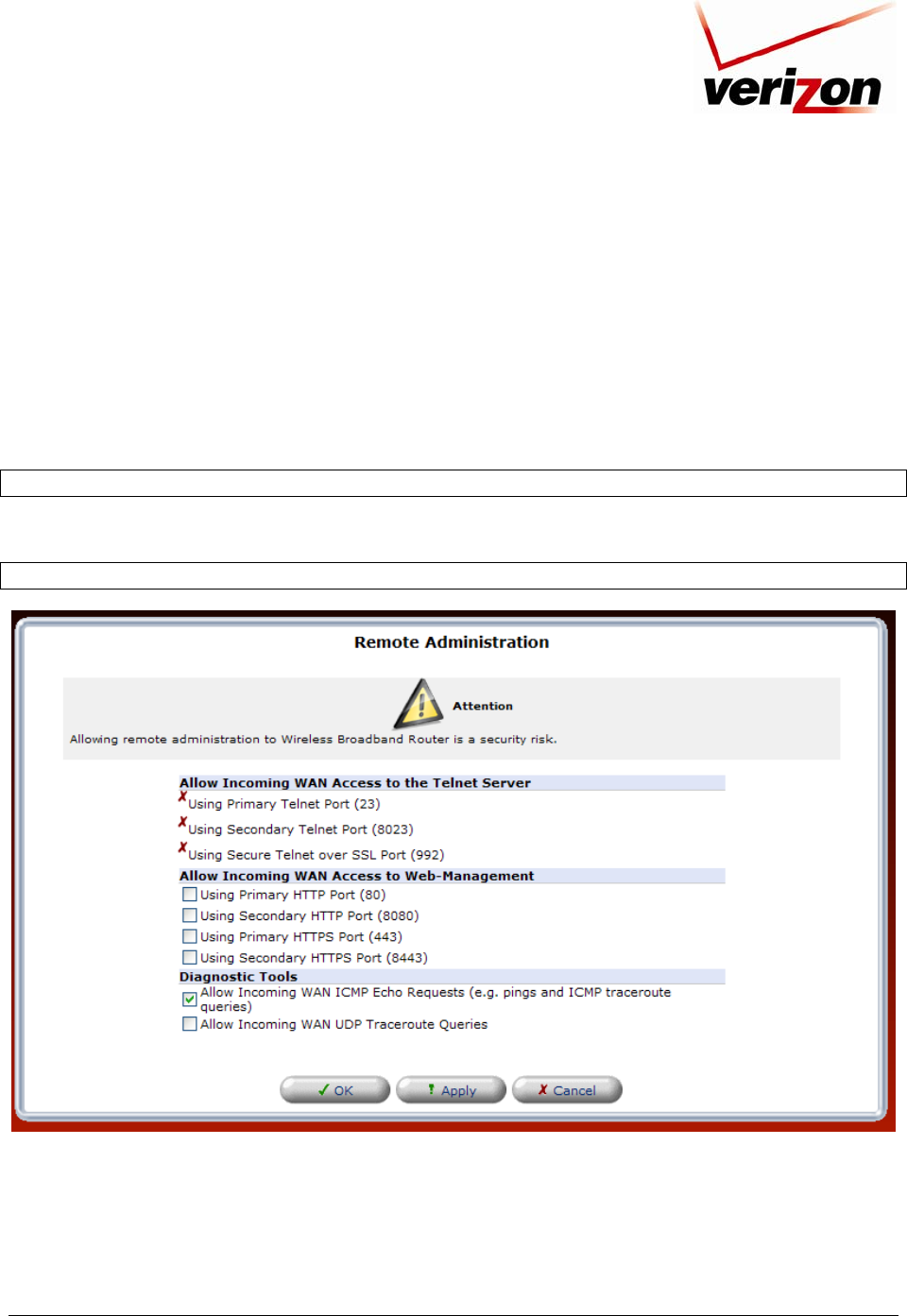
03/24/09 - DRAFT
030-300554 Rev. C 170 March 2009
Verizon FiOS Router
(
Model 9100EM
)
User Guide
15.8 Remote Administration
If you click Advanced in the top navigation menu and then select the Remote Administration link, the following
screen appears.
It is possible to access and control your Router not only from within the home network, but also from the Internet.
This allows you to view or change settings while traveling. It also enables you to allow Verizon to change settings or
help you troubleshoot functionality or communication issues from a remote location. Remote access to your Router
is blocked by default to ensure the security of your network. However, your Router supports the following services,
and you may use the Remote Administration Security screen to selectively enable these services if they are needed.
WARNING: With Remote Administration enabled, your network will be at risk from outside attacks.
To configure Remote Administration, enter the appropriate settings, and then click Apply to save the settings.
NOTE: This Router ships with Telnet disabled.
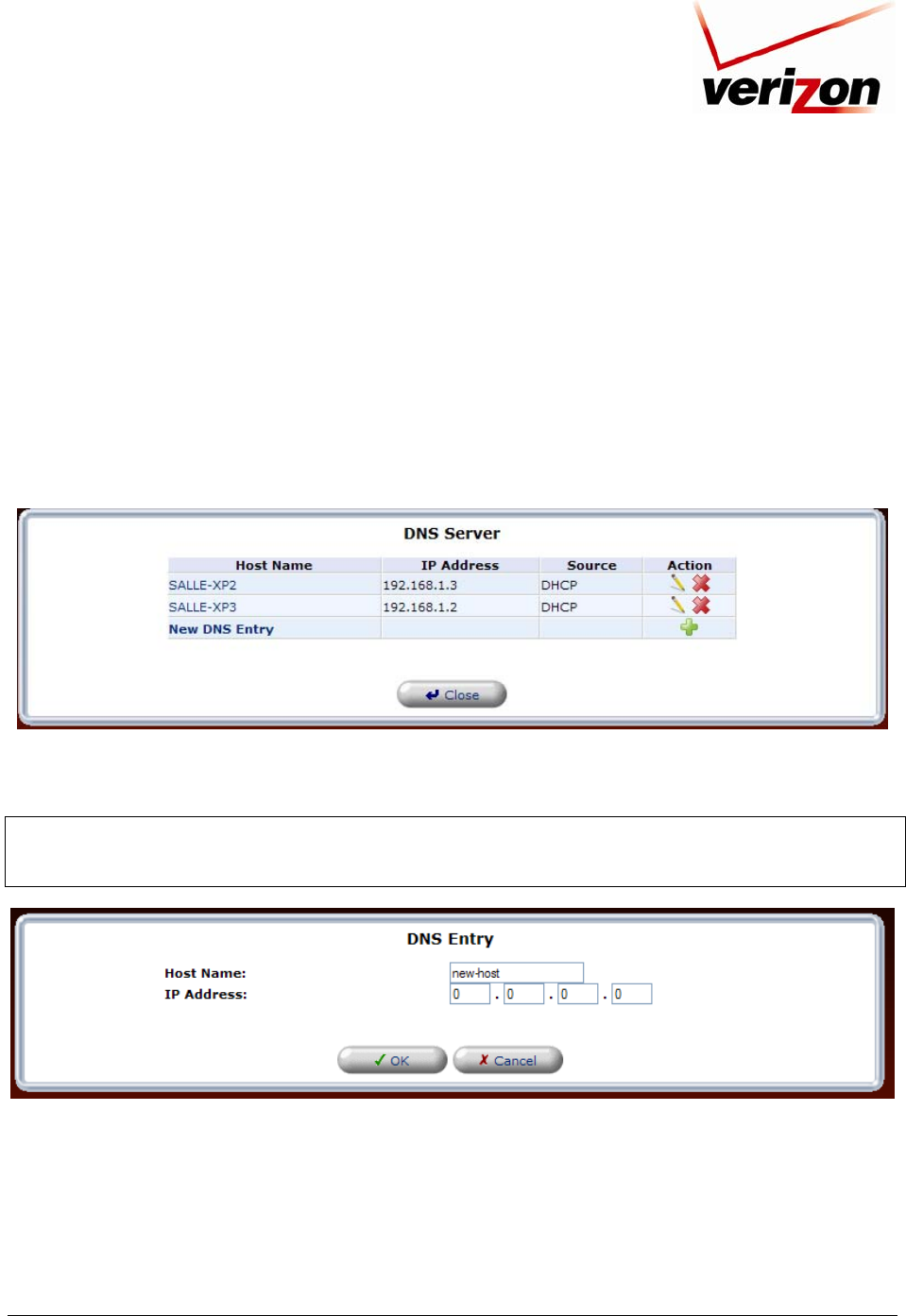
03/24/09 - DRAFT
030-300554 Rev. C 171 March 2009
Verizon FiOS Router
(
Model 9100EM
)
User Guide
15.9 DNS
If you click Advanced in the top navigation menu and then select the DNS link, the following screen appears.
The Router contains a built-in DNS server. When an IP address is assigned, the Router will interrogate the new
device for a machine name using several well-known networking protocols. Any names learned will dynamically be
added to the DNS server’s table of local hosts.
You can do any of the following:
• To rename the domain name, click a host name link.
• To add a host name, click the New DNS Entry link.
To add a new entry, click the New DNS Entry link. The following screen appears. Enter the desired host name, and
then enter the appropriate IP address. Next, click OK to continue.
NOTE: Names may not contain spaces. Only letters, digits and the special characters dash (-), underscore (_) and
dot (.) may be used. These special characters may not appear at the beginning or at the end of a name. The
maximum length of a name can be is 63 characters.
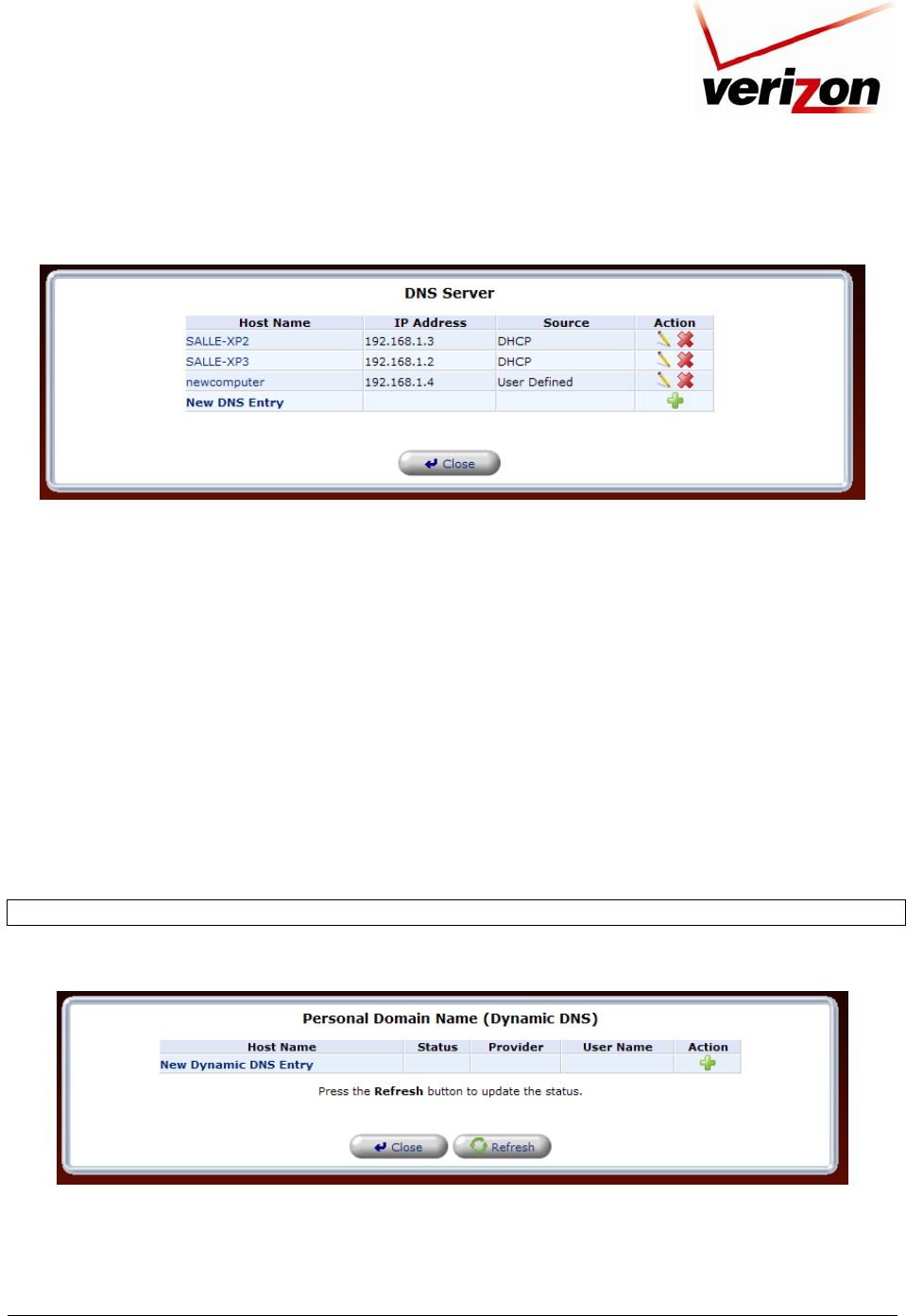
03/24/09 - DRAFT
030-300554 Rev. C 172 March 2009
Verizon FiOS Router
(
Model 9100EM
)
User Guide
If you have entered values in the preceding screen and clicked OK, the following screen appears. The changes have
been saved to the Router.
15.10 Personal Domain (Dynamic DNS)
If you click Advanced in the top navigation menu and then select the Personal Domain Name link, the following
screen appears.
Dynamic DNS (Domain Name Server) a dynamic IP address to be aliased to a static hostname, allowing a computer
on the network to be more easily accessible from the Internet. Typically, when connecting to the Internet, the service
provider assigns an unused IP address from a pool of IP addresses, and this address is used only for the duration of a
specific connection. Dynamically assigning addresses extends the usable pool of available IP addresses, while
maintaining a constant domain name. This allows to user to access a device from a remote location, since the device
will always have the same IP address.
When using Dynamic DNS, each time the IP address provided by the service provider changes, the DNS database
changes accordingly to reflect the change. If the IP address of the computer changes often, its domain name remains
constant and accessible.
NOTE: To use Dynamic DNS, you must subscribe to this service via your service provider.
To configure a new dynamic DNS entry, click the New Dynamic DNS Entry link.
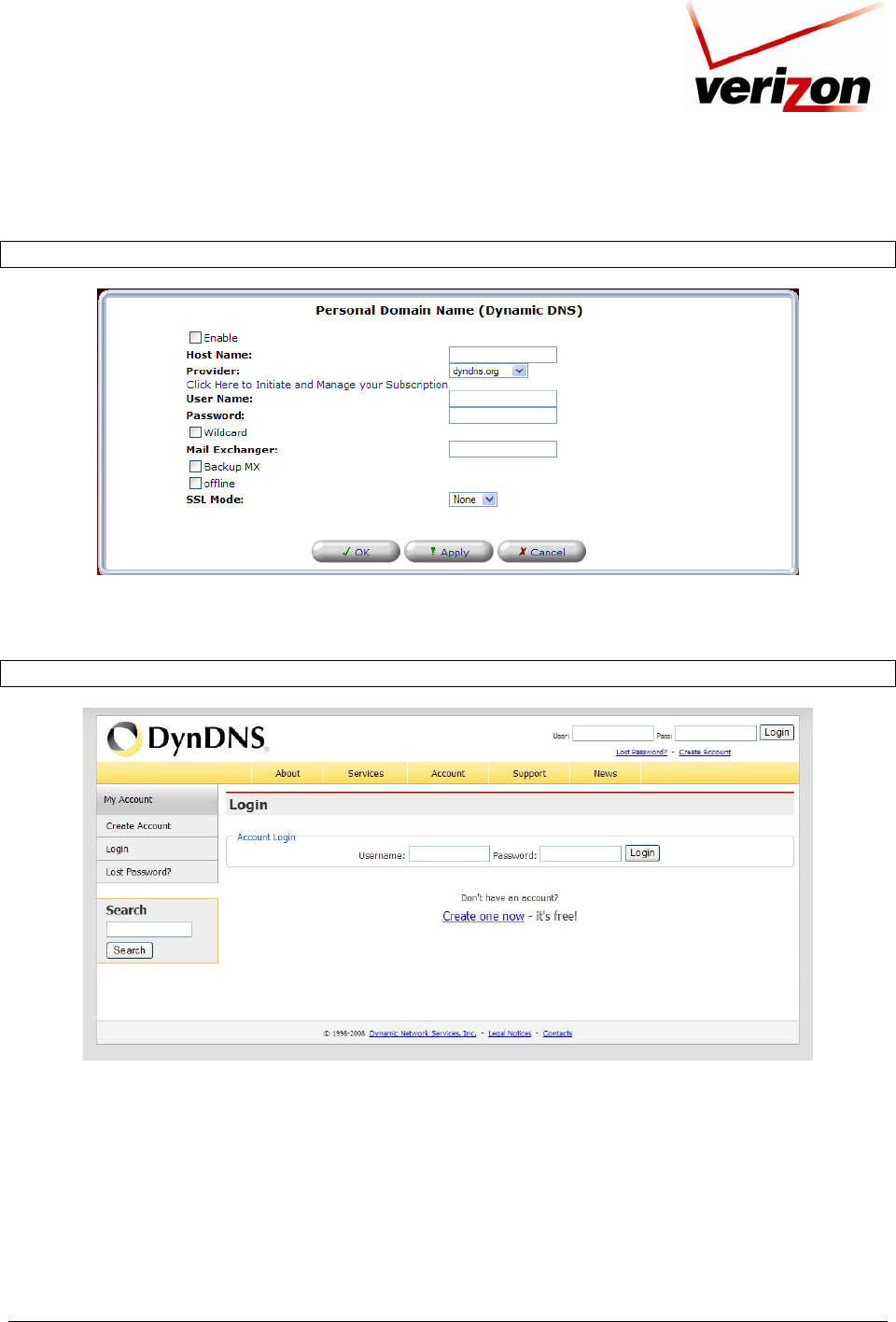
03/24/09 - DRAFT
030-300554 Rev. C 173 March 2009
Verizon FiOS Router
(
Model 9100EM
)
User Guide
The following screen appears. Enter the appropriate values in the fields provided, and then click OK to continue.
NOTE: Your service provider will provide you with the appropriate values to use in this screen.
If you click the Click Here to Initiate and Manage your Subscription link, the following screen appears. Enter
the user name and password (provided by your service provider) in the fields provided to access your account.
NOTE: The screen displayed in this document may differ from the actual screen.
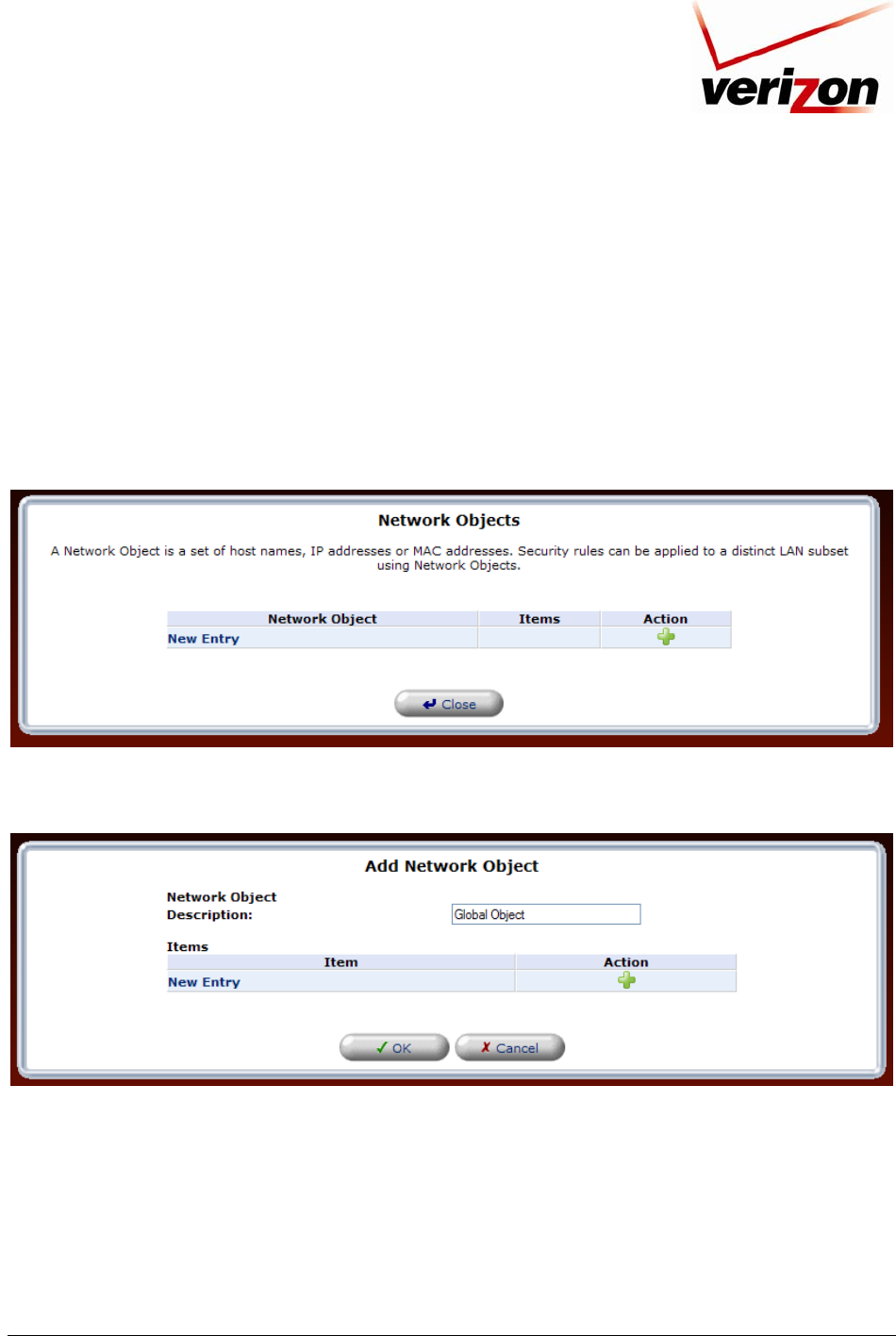
03/24/09 - DRAFT
030-300554 Rev. C 174 March 2009
Verizon FiOS Router
(
Model 9100EM
)
User Guide
15.11 Network Objects
Network Objects is a method used to abstractly define a set of LAN hosts, according to one or more MAC
address, IP address, and host name. Defining such a group can assist when configuring system rules. For
example, network objects can be used when configuring the Router’s security filtering settings such as IP
address filtering, host name filtering or MAC address filtering. You can use network objects to apply security rules
based on host names instead of IP addresses. This may be useful, since IP addresses change from time to time.
Moreover, it is possible to define network objects according to MAC addresses, making rule application more
persistent against network configuration settings.
If you click Advanced in the top navigation menu and then select the Network Objects link, the following screen
appears. To configure a new network object, click the New Entry link.
If you clicked New Entry in the preceding screen, the following screen appears. Enter a name for the network
object in the Network Object Description field, and then click the New Entry link or the plus icon to create it.
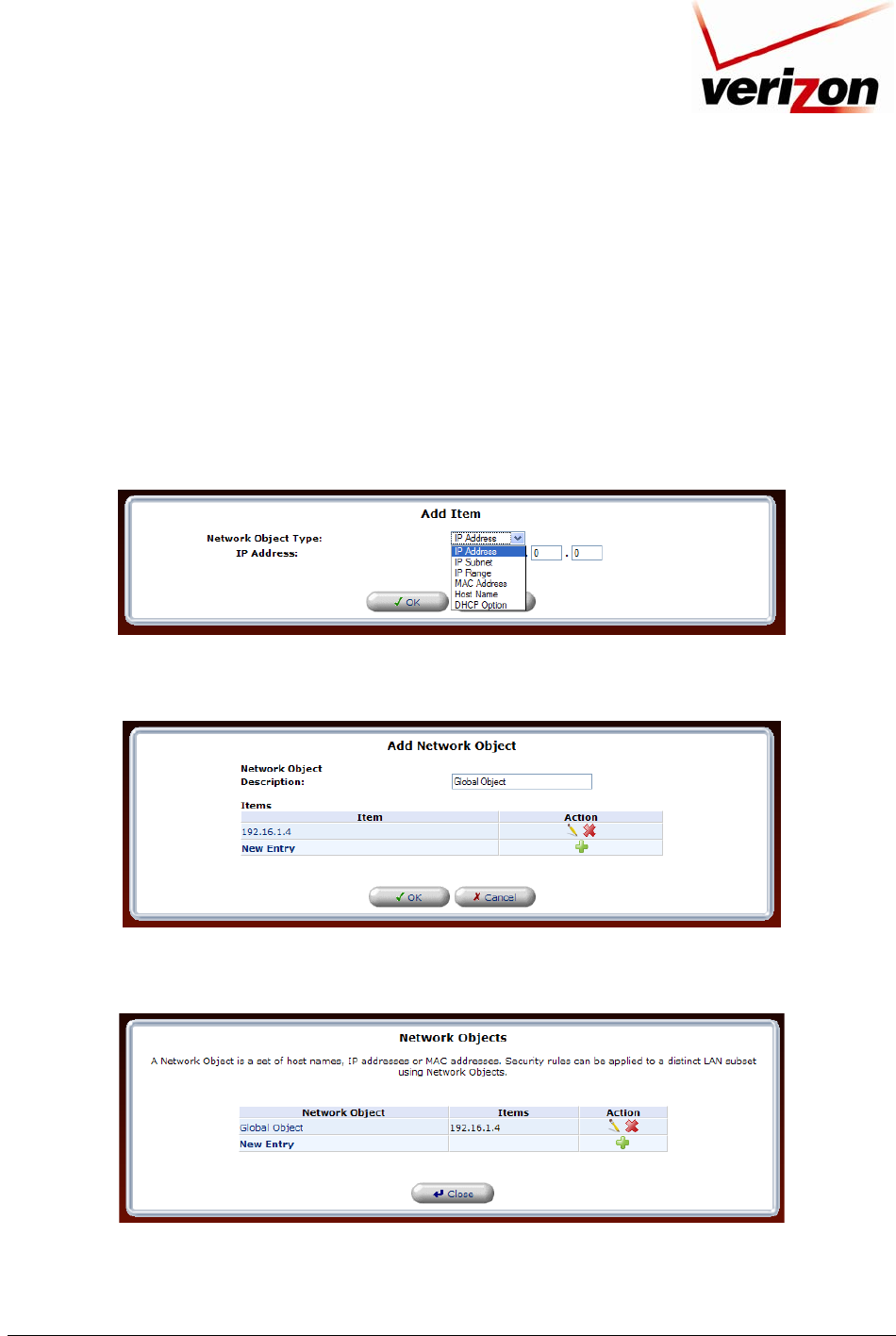
03/24/09 - DRAFT
030-300554 Rev. C 175 March 2009
Verizon FiOS Router
(
Model 9100EM
)
User Guide
If you clicked New Entry, the following screen appears. The source address can be entered using one of the
following methods listed in the IP Address drop-down menu:
• IP Address
• IP Subnet
• IP Range
• MAC Address
• Host Name
• DHCP Option
After you select the desired method, the screen will refresh. Enter the appropriate values in the fields provided, and
then click OK to save the settings.
If you have entered the desired values in the preceding screen and clicked OK, the following screen appears. The
network object has been configured. Click OK to save the configuration.
If you clicked OK, the following screen appears. The network object has been saved to the Router. Click Close to
return to the Advanced screen.
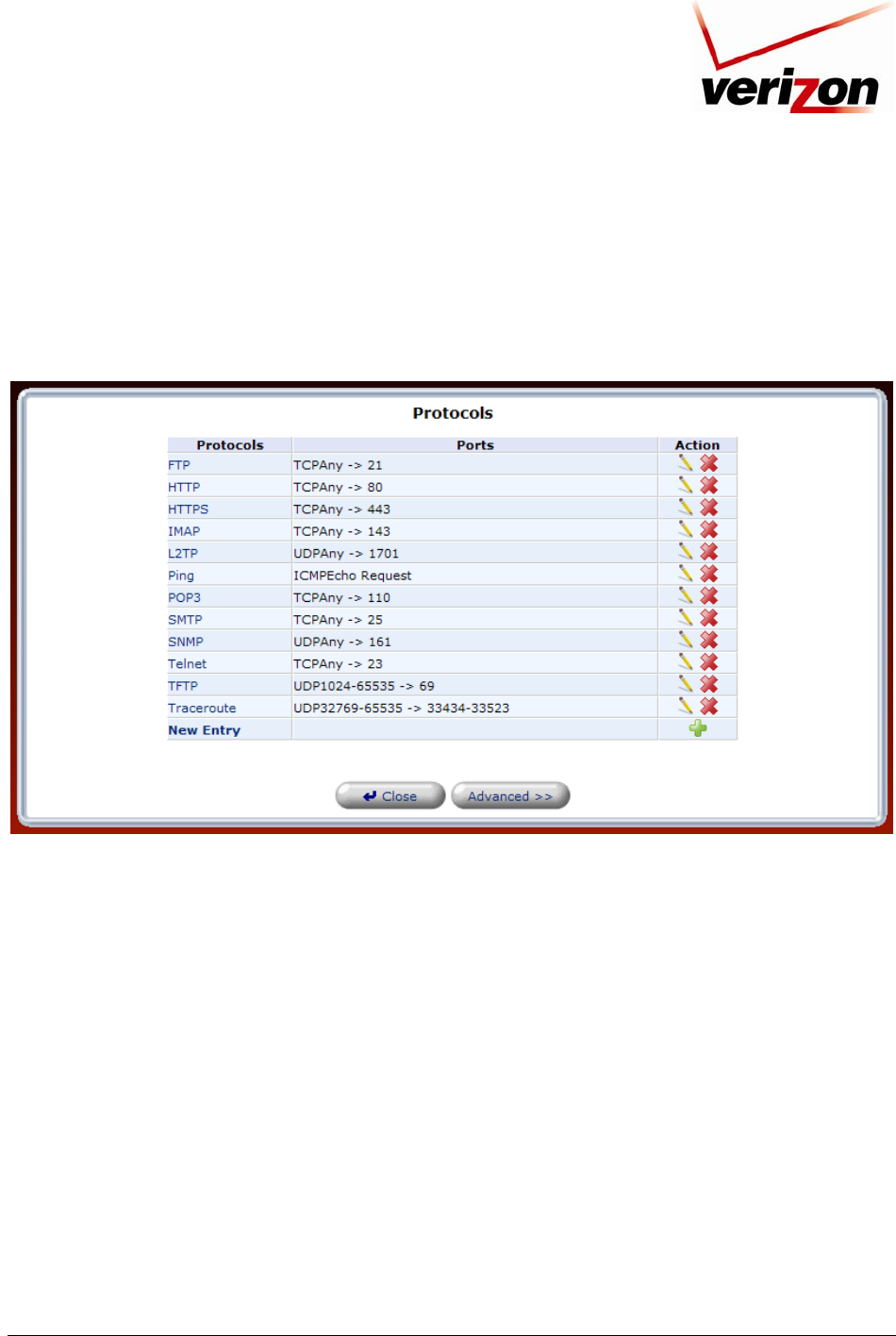
03/24/09 - DRAFT
030-300554 Rev. C 176 March 2009
Verizon FiOS Router
(
Model 9100EM
)
User Guide
15.12 Protocol
If you click Advanced in the top navigation menu and then select the Protocol link, the following screen appears.
For your convenience, the Router supports protocols for Applications, Games, and VPN-specific programs. The
following chart provides port/protocol information for the supported services. The Protocol screen allows you to
select the desired view: Basic Service and Advanced Service. The following sections explain the features of each
service.
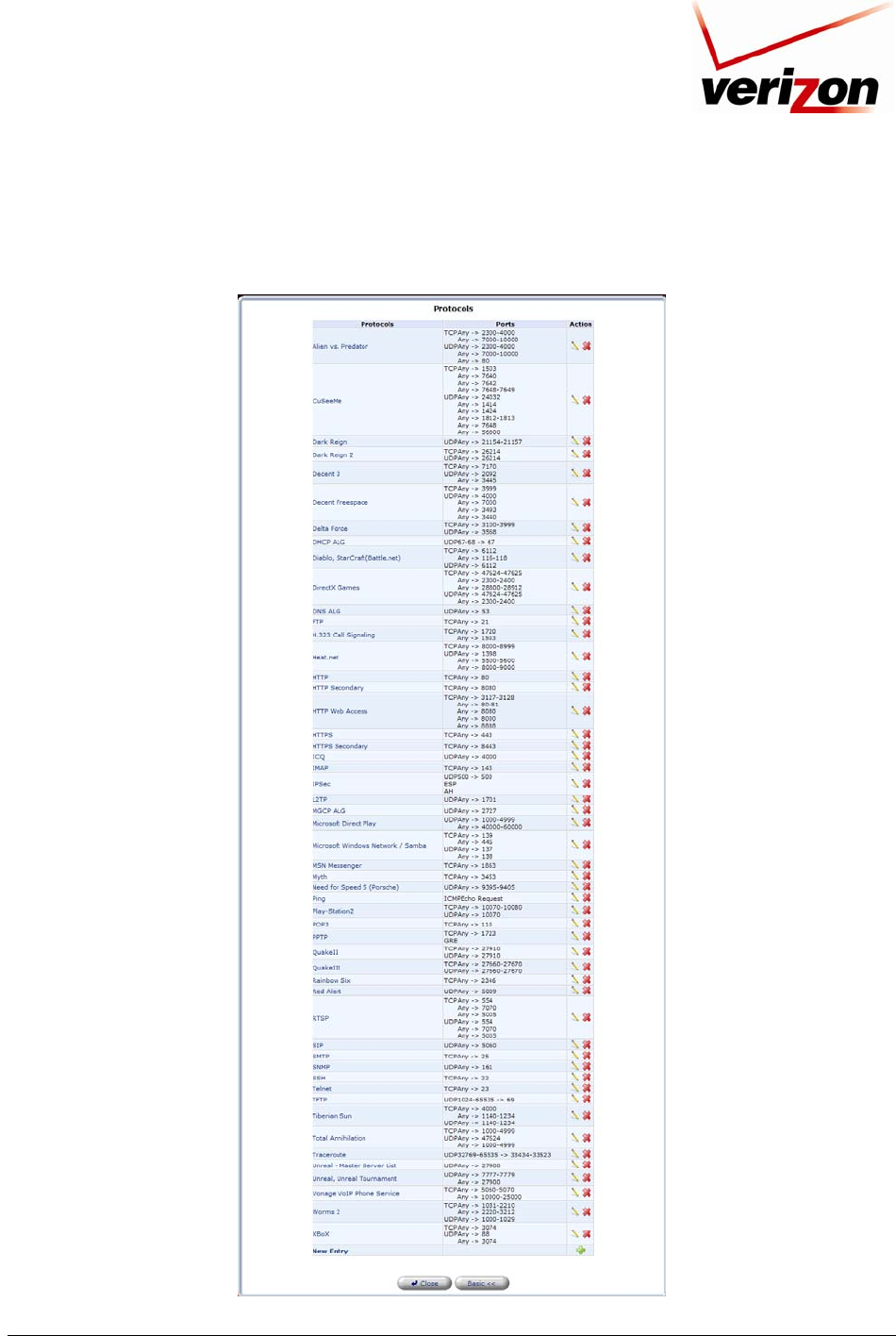
03/24/09 - DRAFT
030-300554 Rev. C 177 March 2009
Verizon FiOS Router
(
Model 9100EM
)
User Guide
15.12.1 Basic Service
To access the basic service Protocols screen (if you are in the Advanced screen), click the Basic button.
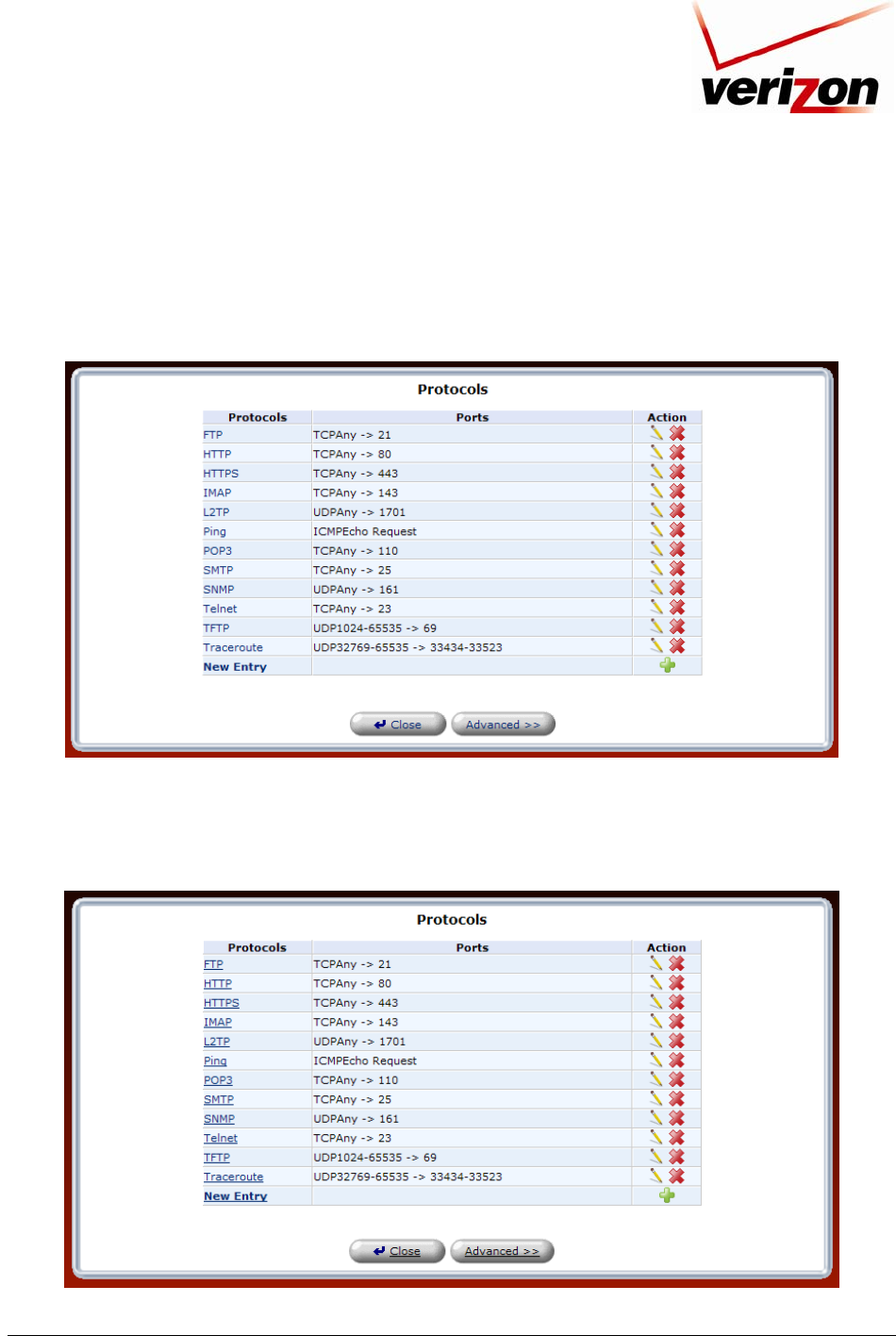
03/24/09 - DRAFT
030-300554 Rev. C 178 March 2009
Verizon FiOS Router
(
Model 9100EM
)
User Guide
If you clicked the Basic button in the preceding screen, the following screen appears.
At this screen, you can:
• Configure ports for predefined protocols by clicking the desired link.
• Configure a new user-defined port for a protocol by clicking the New Entry link.
15.12.1.1 Configuring a Predefined Protocol Service
To configure the Router for a predefined protocol service, click the desired protocol link.
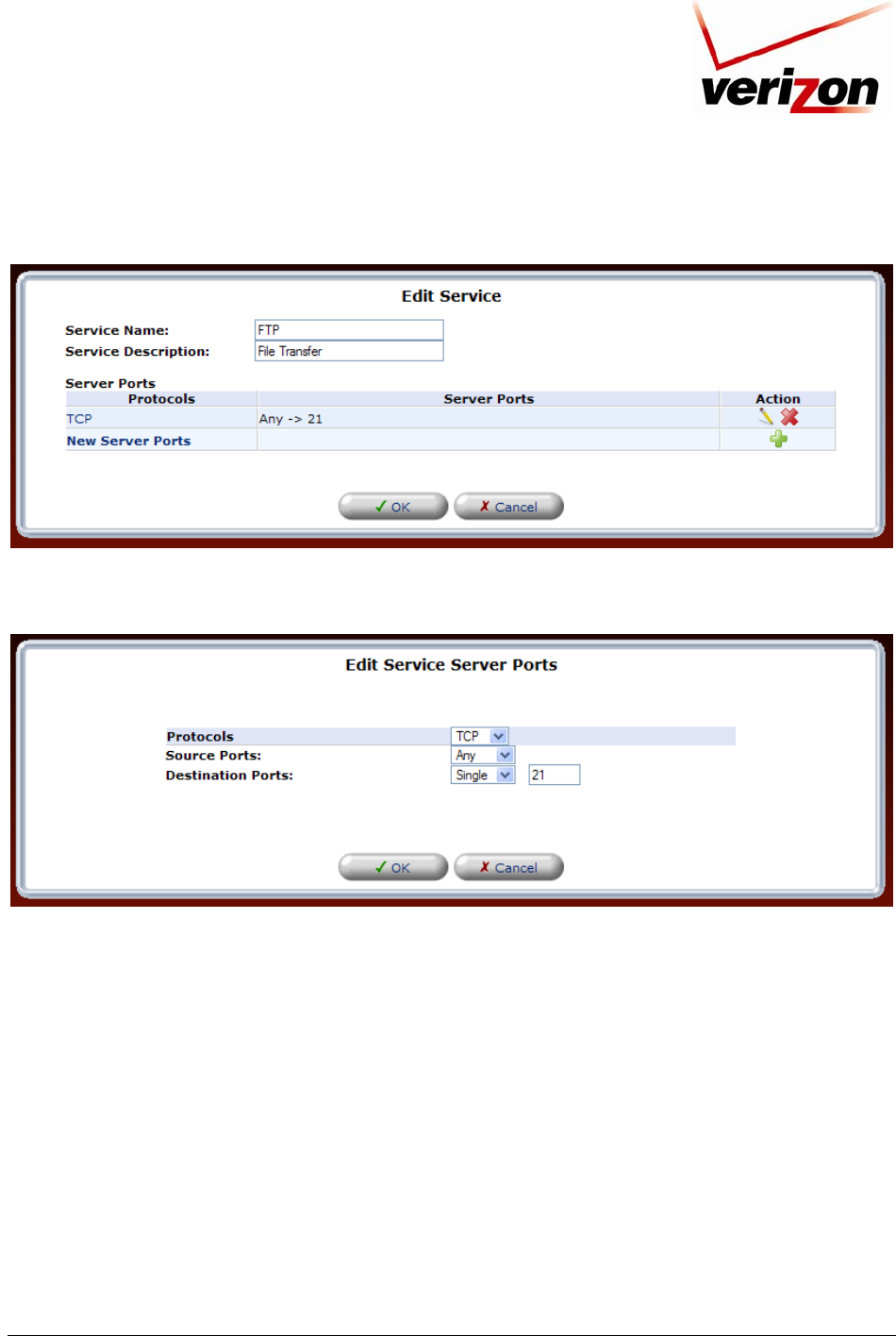
03/24/09 - DRAFT
030-300554 Rev. C 179 March 2009
Verizon FiOS Router
(
Model 9100EM
)
User Guide
For example, if you clicked FTP in the preceding screen, the following screen appears. Next, click the TCP link to
configure the service protocol values.
If you clicked TCP in the Edit Service screen, the following screen appears. Enter the desired values, and then click
OK to continue.
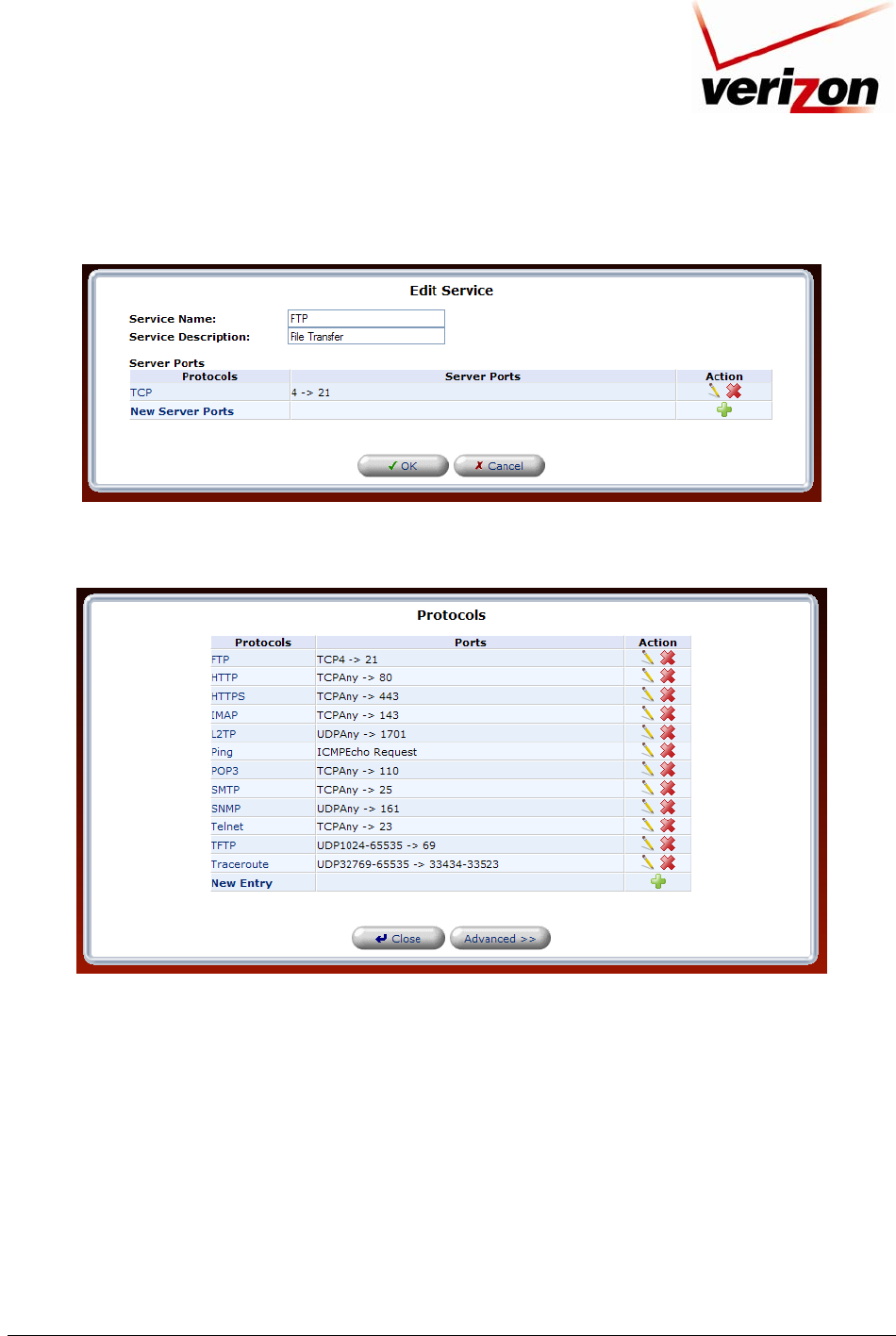
03/24/09 - DRAFT
030-300554 Rev. C 180 March 2009
Verizon FiOS Router
(
Model 9100EM
)
User Guide
If you have entered values and clicked OK in the preceding screen, the following screen appears. A protocol service
has been configured. Click OK to save the settings.
If you clicked OK in the preceding screen, the following screen appears. The protocol service has been saved to the
Router.
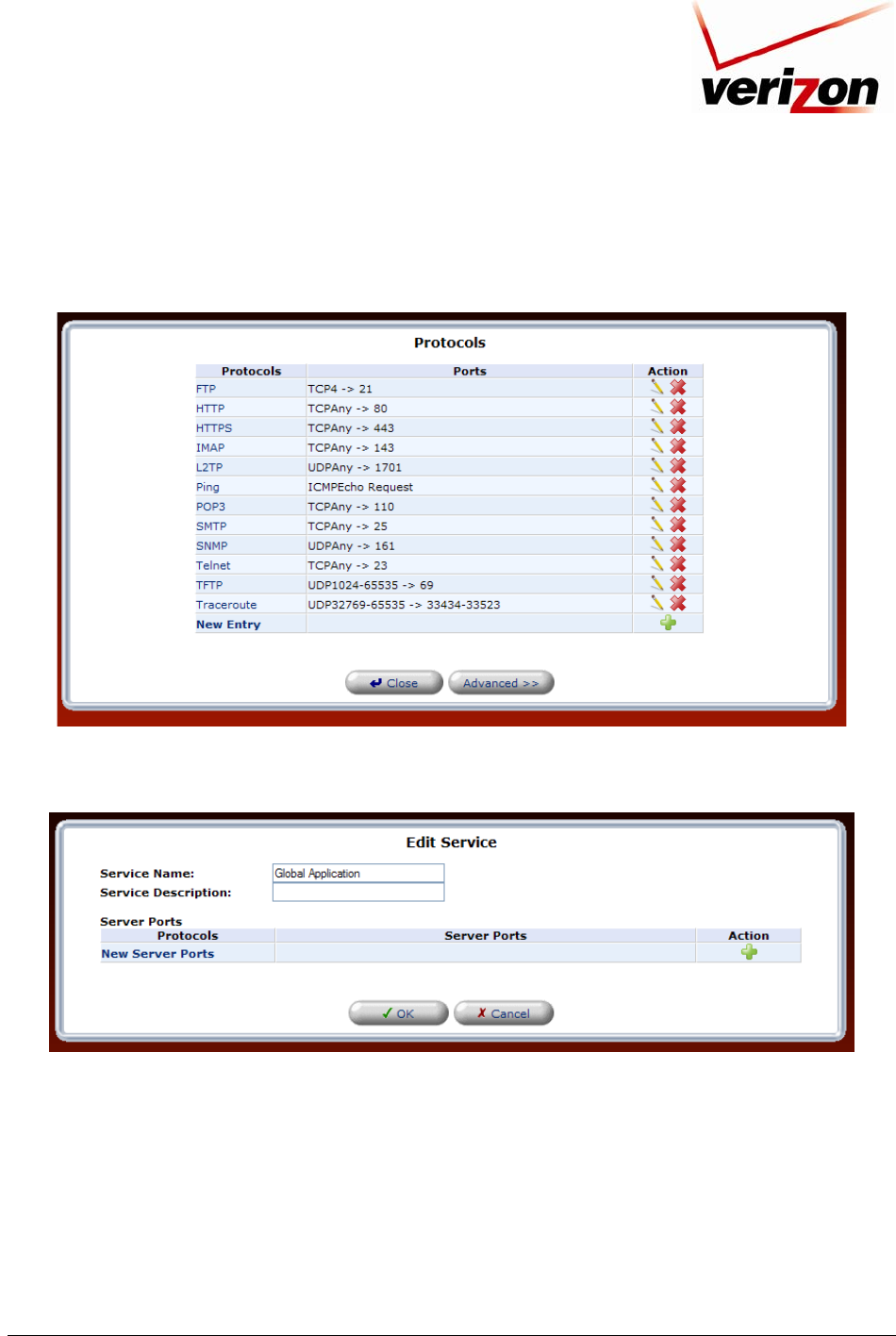
03/24/09 - DRAFT
030-300554 Rev. C 181 March 2009
Verizon FiOS Router
(
Model 9100EM
)
User Guide
15.12.1.2 Configuring a User-defined Protocol Service
To configure the Router for a user-defined protocol service, click the New Entry link.
If you clicked New Entry, the following screen appears. Enter a service name and service description in the fields
provided. Next, click the New Server Ports link.
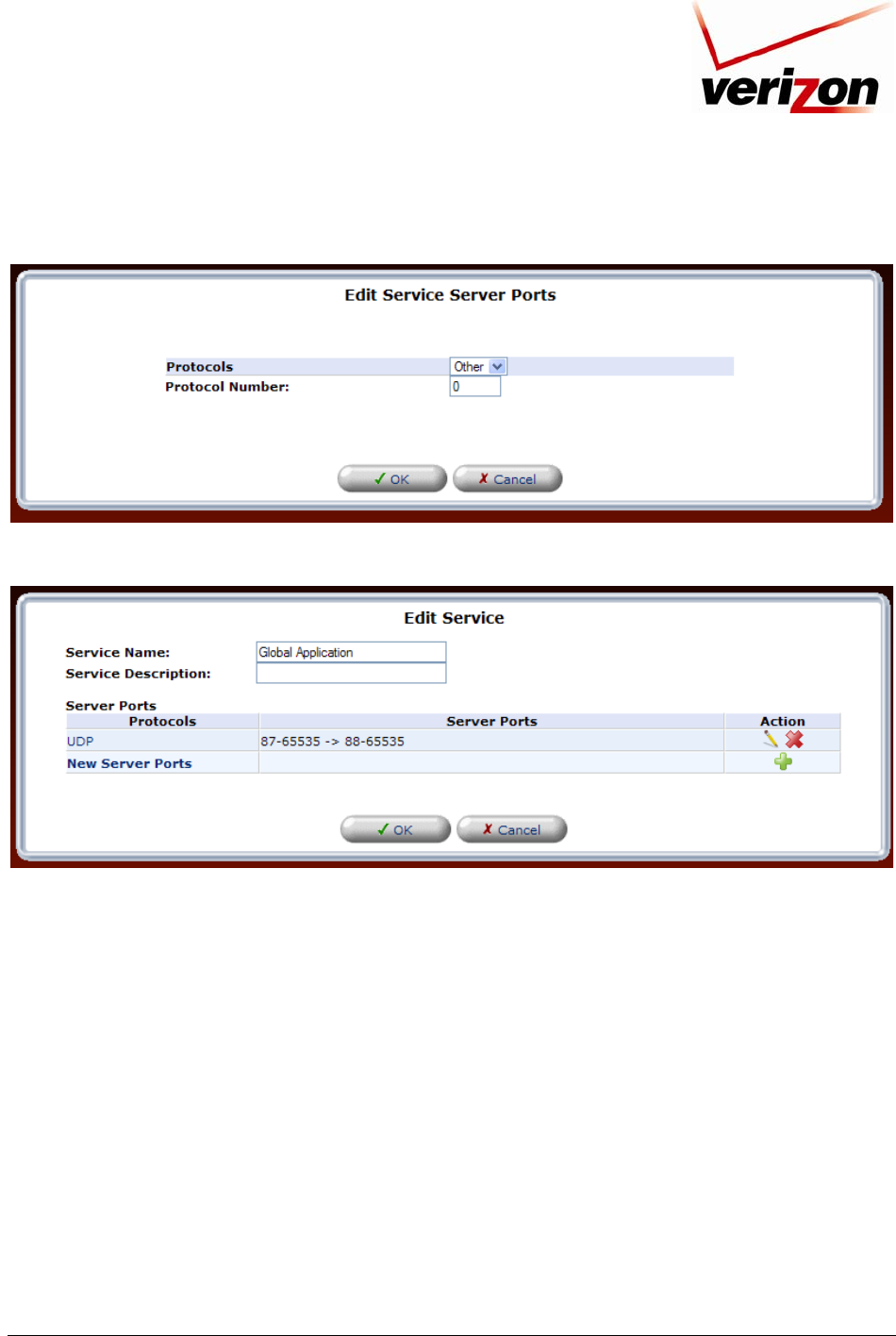
03/24/09 - DRAFT
030-300554 Rev. C 182 March 2009
Verizon FiOS Router
(
Model 9100EM
)
User Guide
If you clicked New Server Ports, the following screen appears. Select a protocol from the drop-down list, and then
enter a protocol number. Click OK to continue.
If you clicked OK, the following screen appears. Click OK to save the settings.
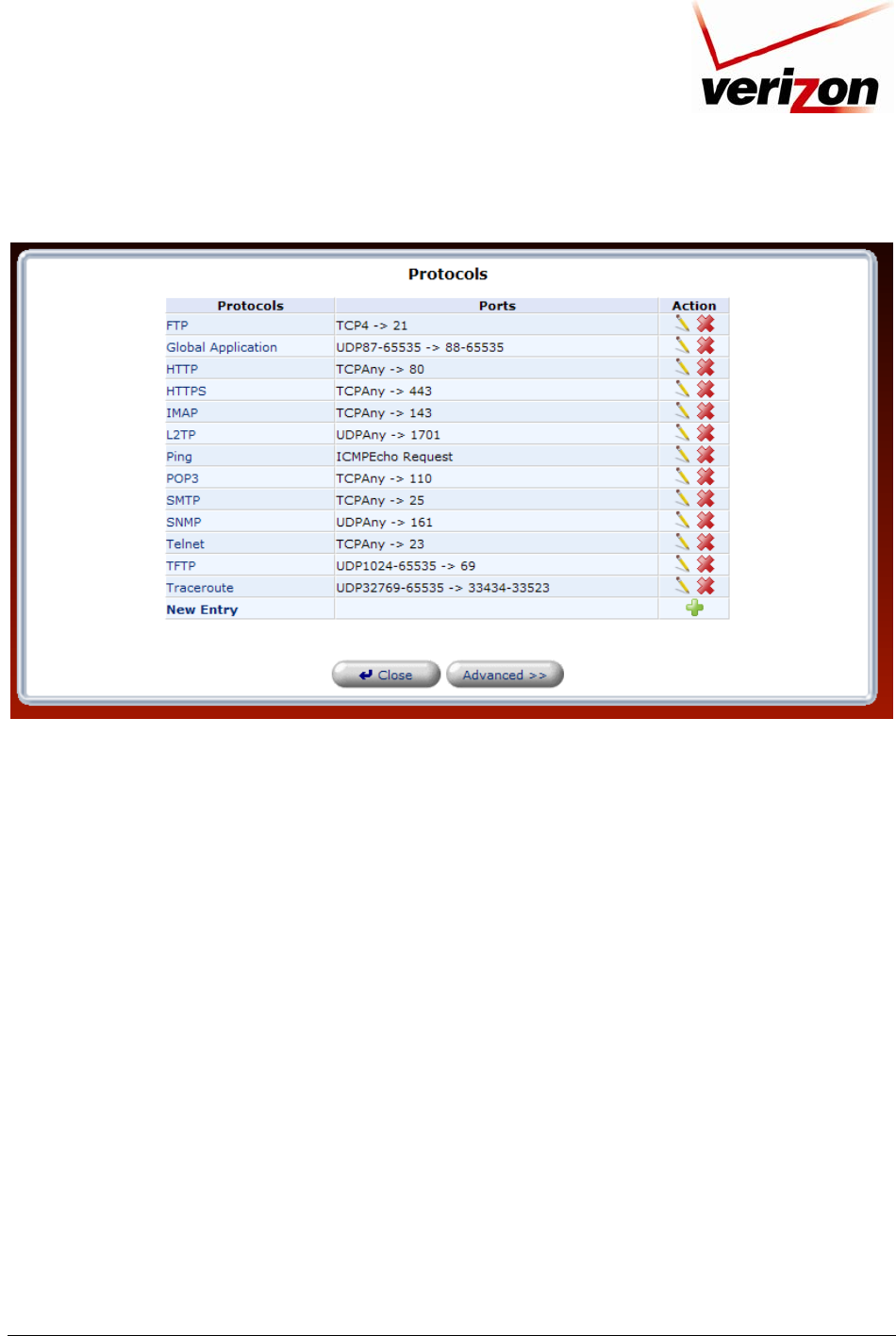
03/24/09 - DRAFT
030-300554 Rev. C 183 March 2009
Verizon FiOS Router
(
Model 9100EM
)
User Guide
If you clicked OK, the following screen appears. The protocol settings have been saved to the Router.
15.12.2 Advanced Protocol Service
To access the advanced service Protocols screen (if you are in the Basic screen), click the Advanced button. The
following advanced Protocols screen will appear.
At the Advanced screen, you can:
• Configure predefined application by clicking the desired link.
• Configure a new user-defined application by clicking the New Entry link.
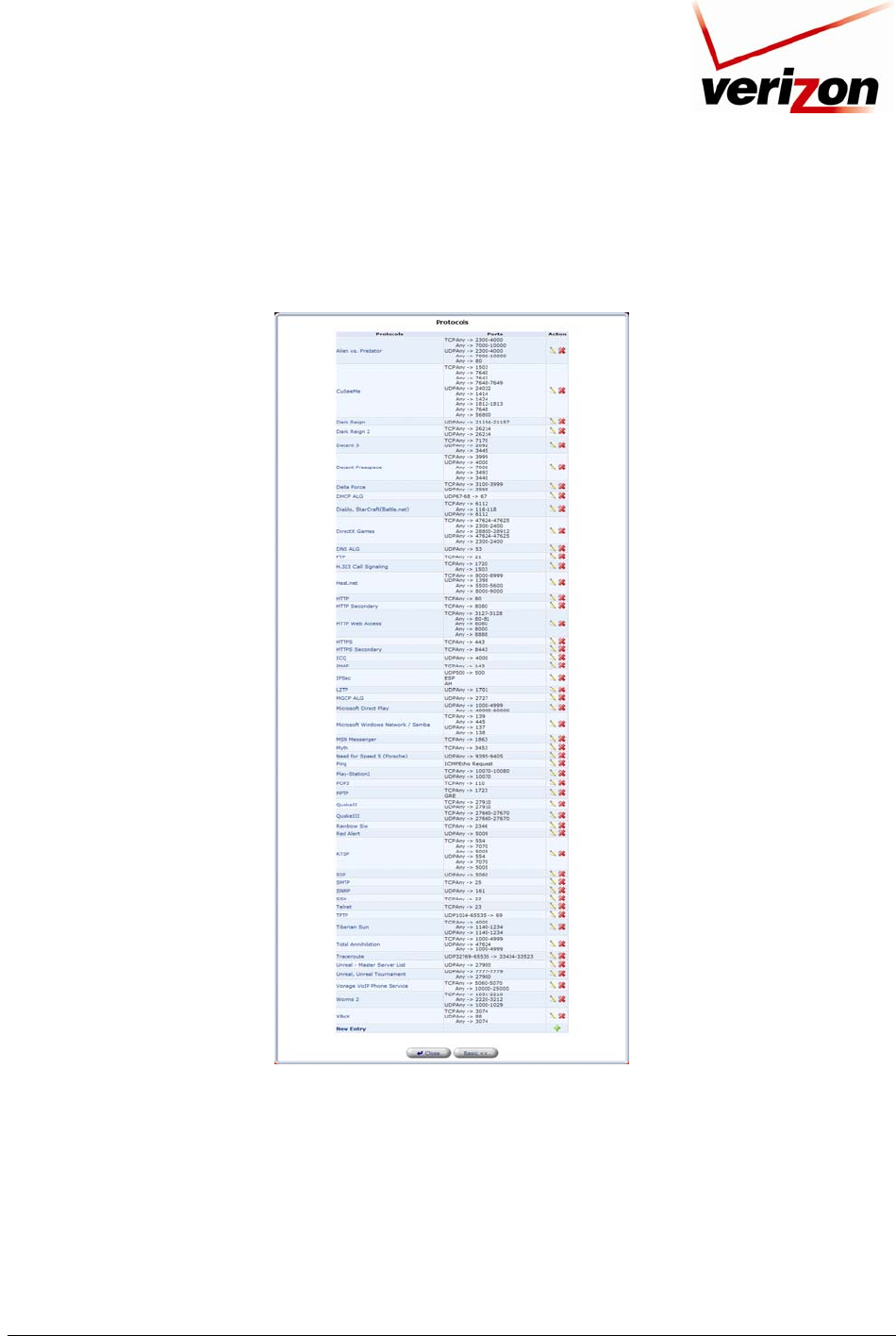
03/24/09 - DRAFT
030-300554 Rev. C 184 March 2009
Verizon FiOS Router
(
Model 9100EM
)
User Guide
15.12.2.1 Configuring a Predefined Application
To configure the Router for a predefined application, click the desired link.
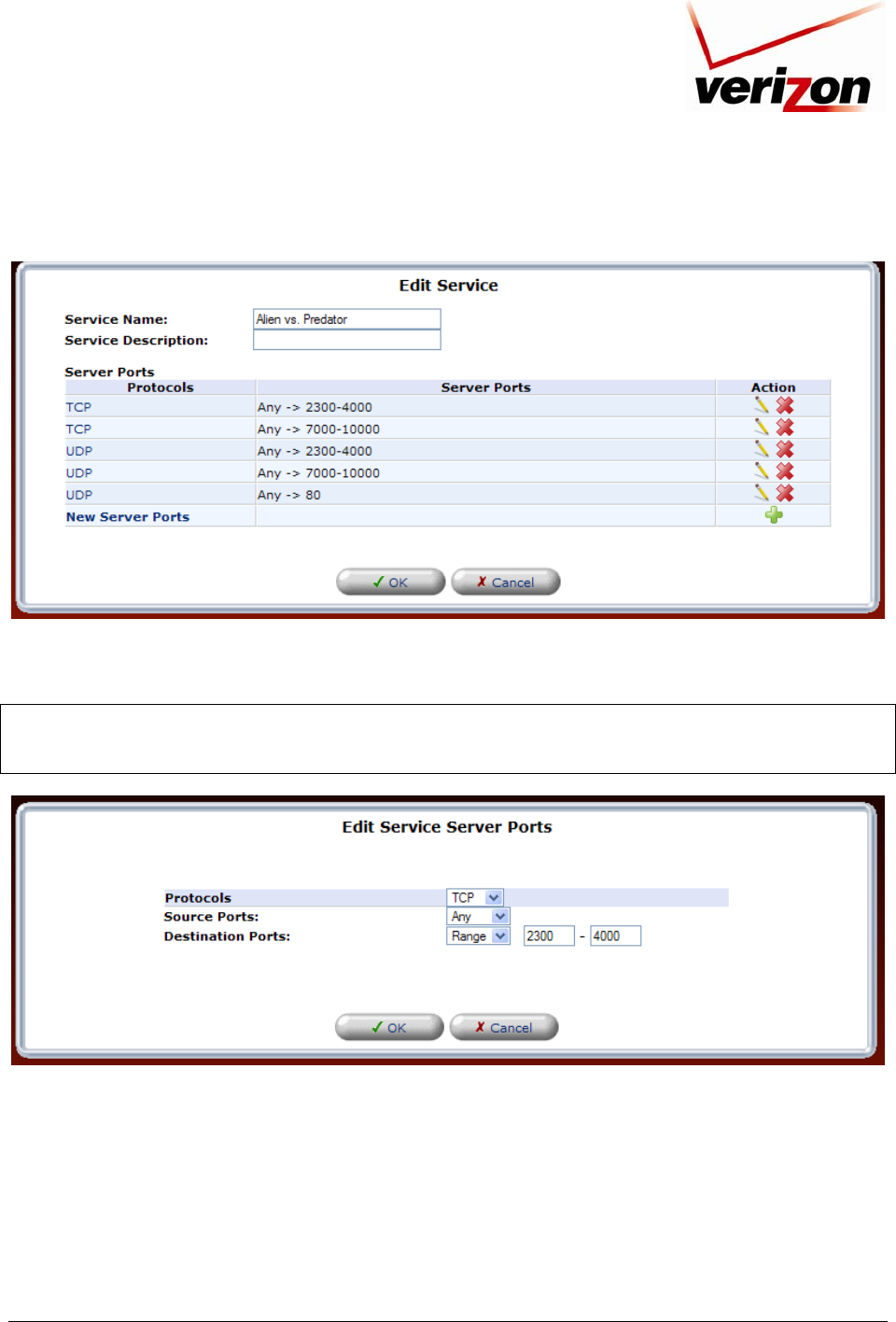
03/24/09 - DRAFT
030-300554 Rev. C 185 March 2009
Verizon FiOS Router
(
Model 9100EM
)
User Guide
For example, if you clicked the link of a predefined service in the preceding screen, the following screen appears. If
desired, enter a description in the Service Description field. Next, click the desired TCP or UDP link.
If you selected TCP (Any -> 2300-4000) the following screen appears. Select the desired source port and destination
port values from the drop-down lists, and then click OK.
NOTE: For the Source and Destination ports, you can select a single port or a range of ports. In this example, the
range for the Source port can be any value from 0 through 65535. And the range for the Destination port can be any
value from 2300-4000.
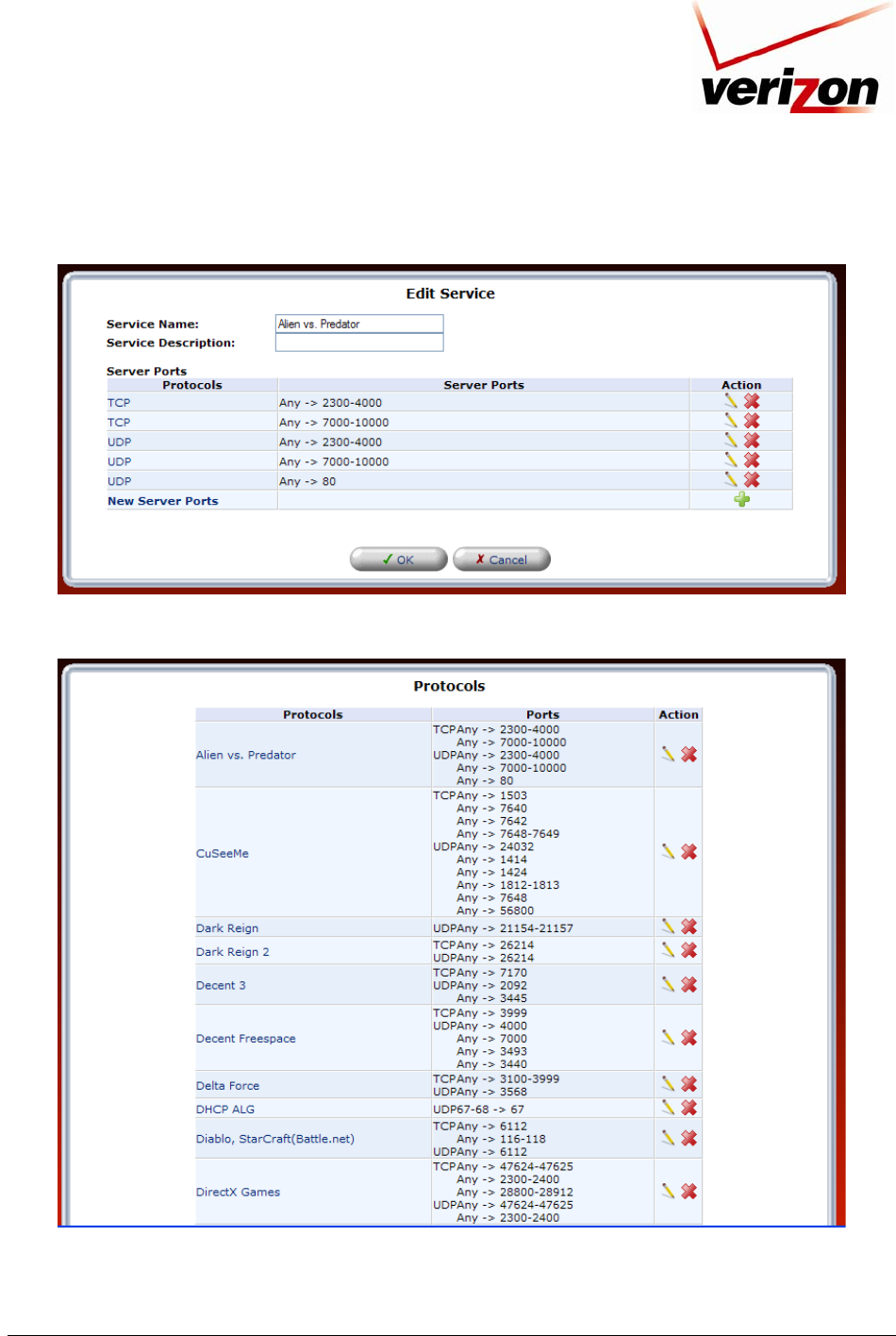
03/24/09 - DRAFT
030-300554 Rev. C 186 March 2009
Verizon FiOS Router
(
Model 9100EM
)
User Guide
After you have entered the desired values and click OK in the preceding screen, the following screen appears. The
TCP protocol values have been configured. Next, click OK to save the settings.
If you clicked OK, the protocol values will be saved to the Router, and the following screen will display the entry.
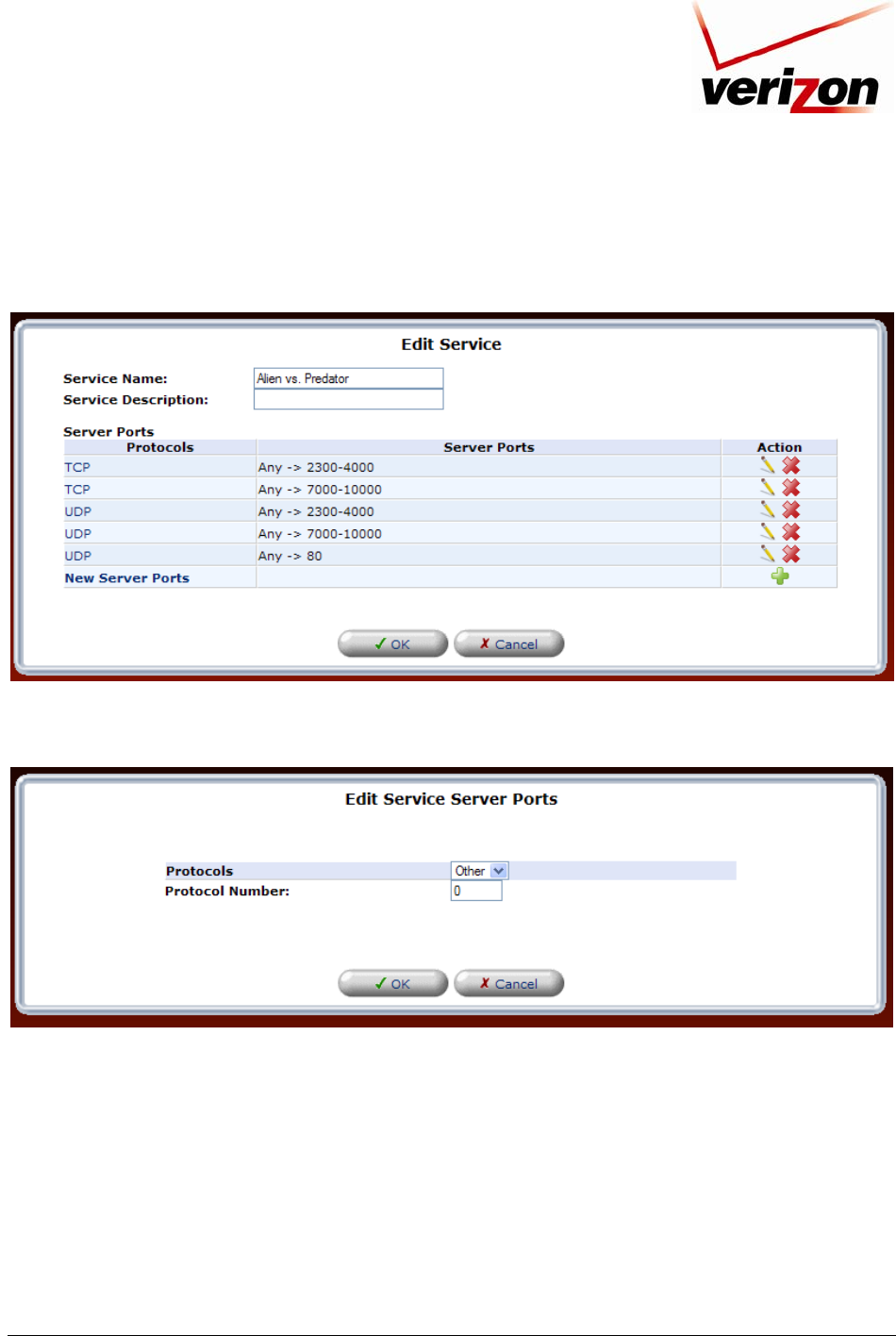
03/24/09 - DRAFT
030-300554 Rev. C 187 March 2009
Verizon FiOS Router
(
Model 9100EM
)
User Guide
15.12.2.2 Configuring a New User-Defined Application
To configure new user-defined application, click the New Server Ports link in the Edit Service screen.
If you clicked New Server Ports, the following screen appears. Select the desired protocol from the Protocol drop-
down list, and then enter the protocol number.
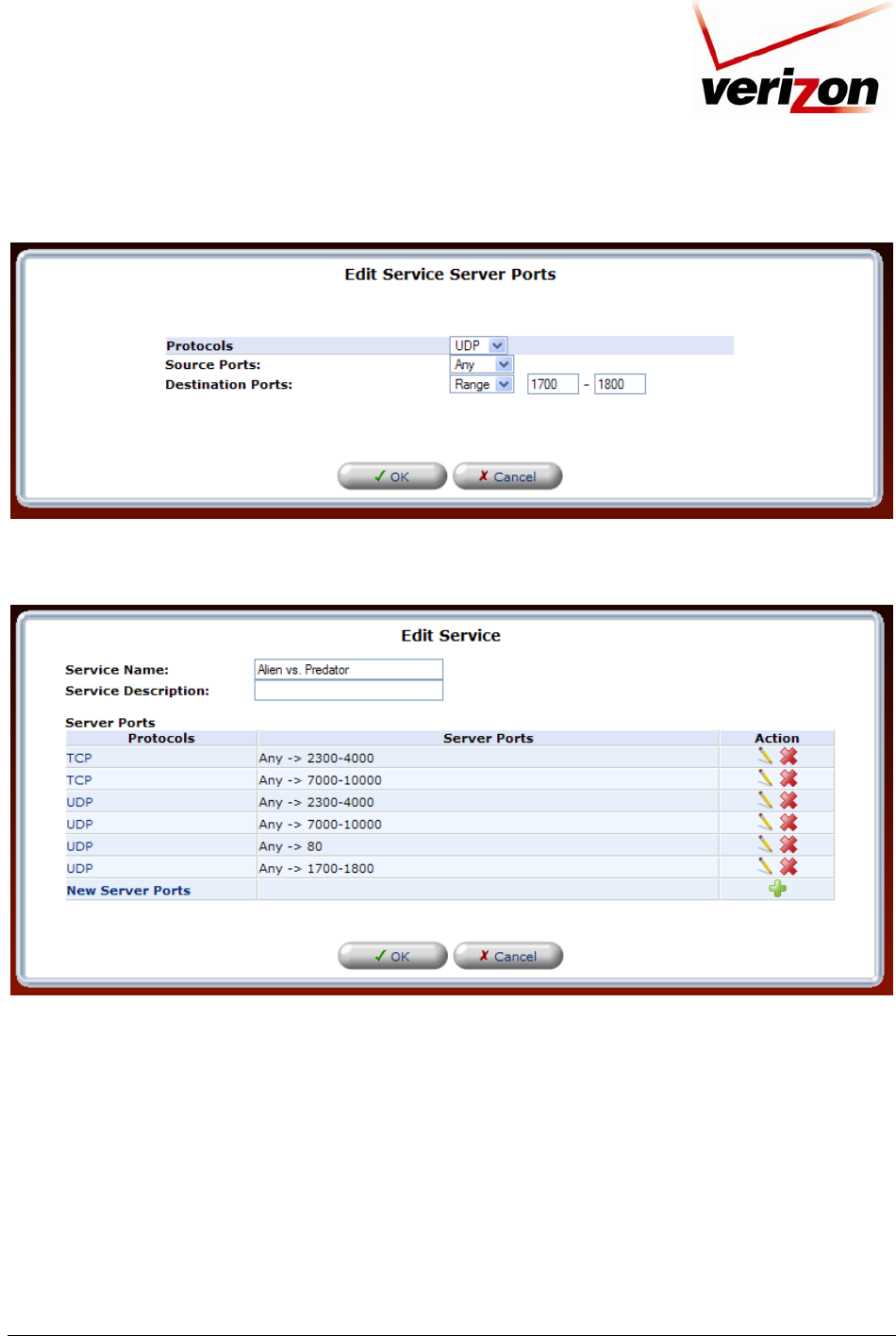
03/24/09 - DRAFT
030-300554 Rev. C 188 March 2009
Verizon FiOS Router
(
Model 9100EM
)
User Guide
For example, this screen shows appropriate values, click OK to continue.
If you clicked OK, the following screen appears. The UDP port values have been configured. Next, click OK to
save the settings.
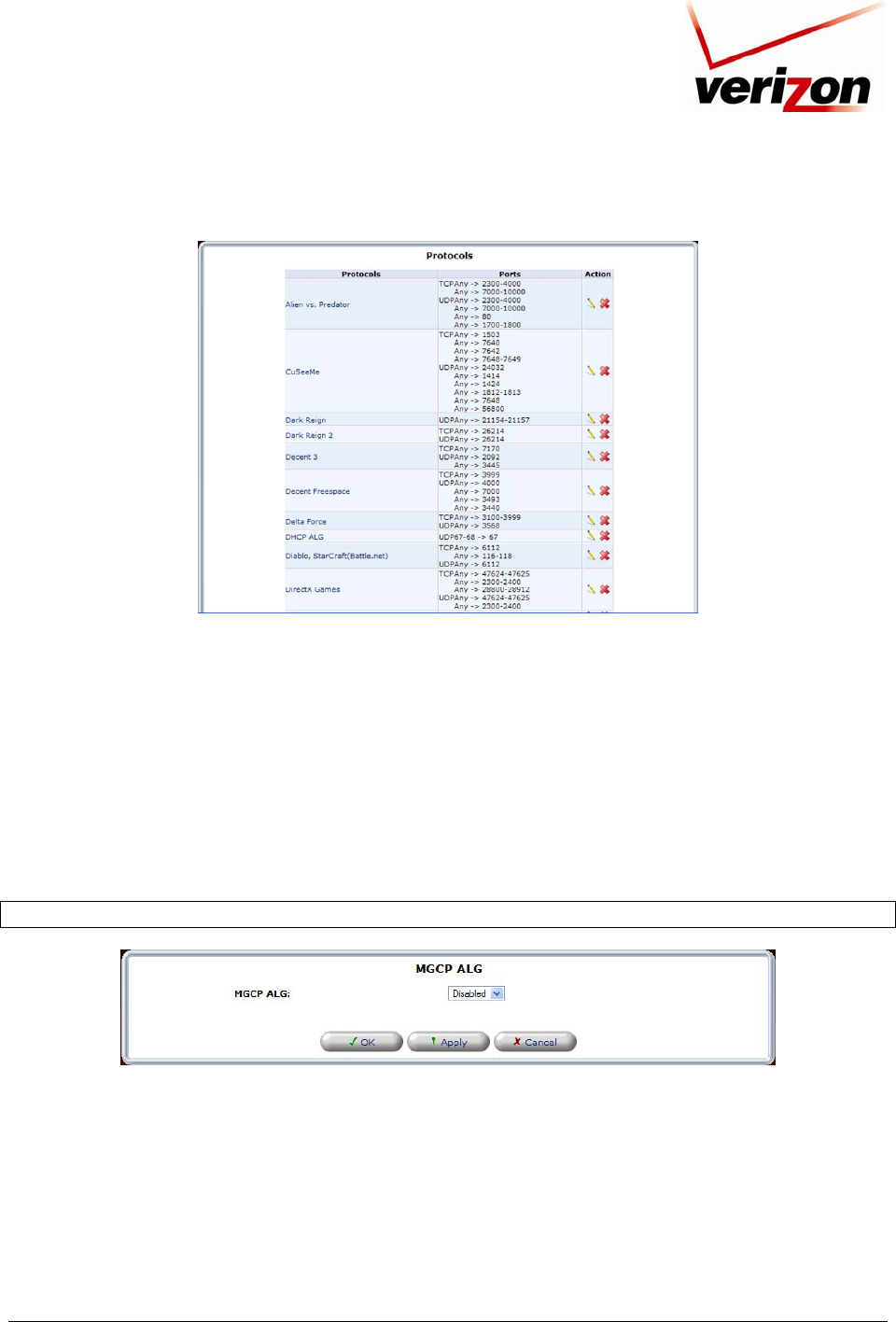
03/24/09 - DRAFT
030-300554 Rev. C 189 March 2009
Verizon FiOS Router
(
Model 9100EM
)
User Guide
If you clicked OK, the following screen appears. The user-defined UDP port settings are now saved to the Router.
15.13 MGCP ALG
If you click Advanced in the top navigation menu and then select the MGCP ALG link, the following screen
appears. The UltraLine Series3 includes a Media Gateway Control Protocol (MGCP) Application-level Gateway
(ALG). MGCP is a signaling and call control protocol used by some Voice over IP (VoIP) systems. This ALG
enables use of MGCP devices behind your firewall without the need to create pinholes or custom firewall rules for
this specific type of traffic.
To enable the MGCP ALG, select Enabled from the MGCP ALG drop-down list. Then click Apply to save the
setting.
NOTE: Do not enable this setting unless your service provider instructs you to do so.
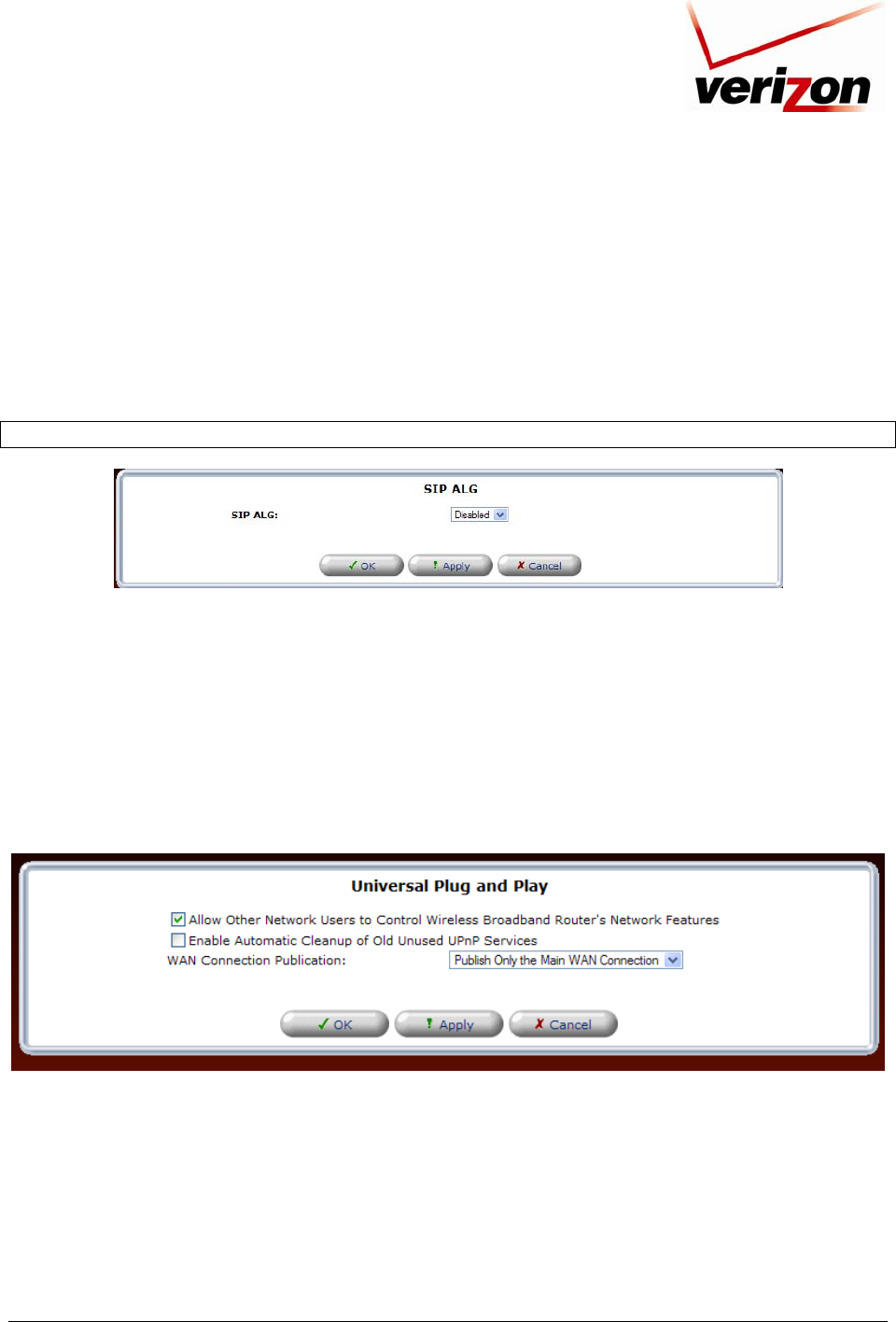
03/24/09 - DRAFT
030-300554 Rev. C 190 March 2009
Verizon FiOS Router
(
Model 9100EM
)
User Guide
15.14 SIP ALG
If you click Advanced in the top navigation menu and then select the SIP ALG link, the following screen appears.
The UltraLine Series3 includes a Session Initiation Protocol (SIP) Application-level Gateway. SIP is a signaling
protocol used by multimedia applications, most commonly a Voice over IP (VoIP) system. This ALG enables use
of SIP devices behind your firewall without the need to create pinholes or custom firewall rules for this specific type
of traffic.
To enable SIP ALG, select Enabled from the SIP ALG drop-down list. Then, click Apply to save the setting.
NOTE: Do not enable this setting unless your service provider instructs you to do so.
15.15 UPnP
If you click Advanced in the top navigation menu and then select the UPnP link, the following screen appears. This
feature advertises the presence of your Router on the LAN. Universal Plug-and-Play is a networking architecture
that provides compatibility among networking equipment, software and peripherals. Products that have UPnP can
seamlessly connect and communicate with other Universal Plug-and-Play enabled devices, without the need for user
configuration, centralized servers, or product-specific device drivers.
To configure UPnP enter the desired values and then click Apply to save the settings.
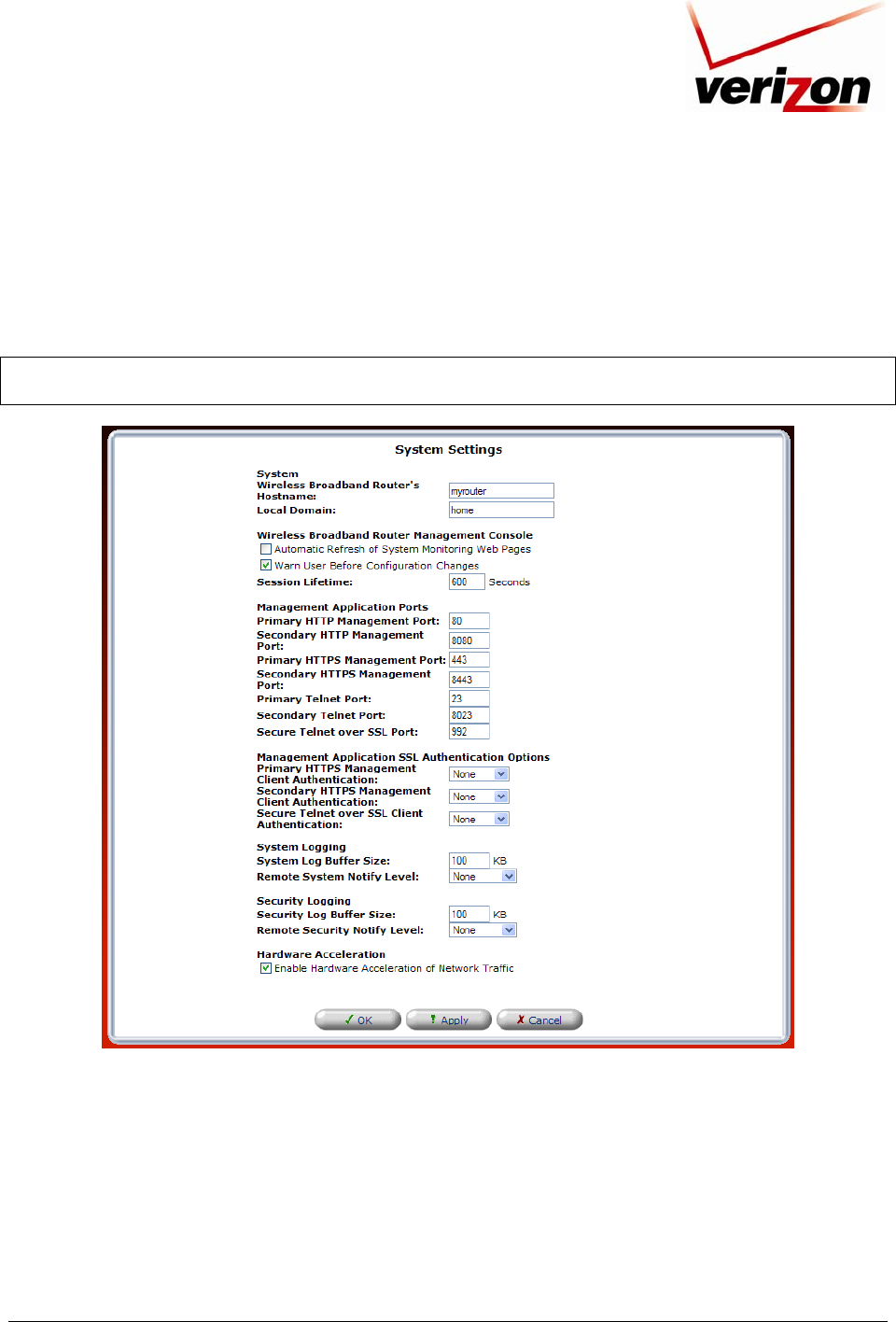
03/24/09 - DRAFT
030-300554 Rev. C 191 March 2009
Verizon FiOS Router
(
Model 9100EM
)
User Guide
15.16 System Settings
If you click Advanced in the top navigation menu and then select the System Settings link, the following screen
appears. Use this page to configure various system settings. Enter the desired system settings and then click Apply to
save the settings.
NOTE: This Router ships with Telnet disabled. If Telnet is enabled, you can configure Secure Telnet over SSL
Port/Client Authentication.
Hostname—Specify the Router’s host name. The host name is the Router’s URL address.
Local Domain—Specify your network’s local domain.
Wireless Broadband Router Management Console
Automatic Refresh of System Monitoring Web Pages—select this check box to enable the automatic refresh of
system monitoring web pages.
Warn User Before Network Configuration Changes—select this check box to activate user warnings before network
configuration changes take effect.
Session Lifetime—this value represents duration of idle time (in seconds) in which the Router will remain active.
When this duration times out, the user will have to re-login.
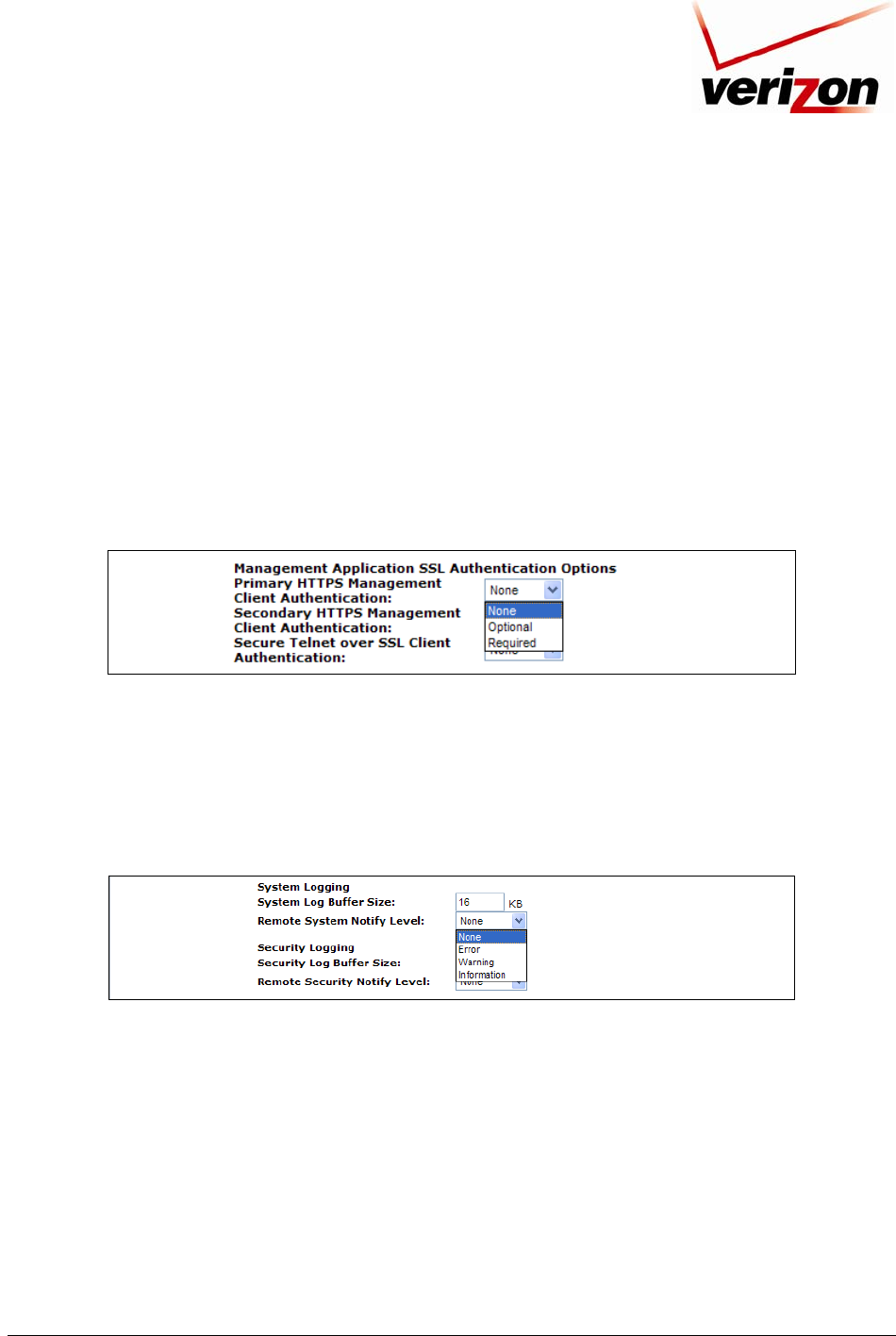
03/24/09 - DRAFT
030-300554 Rev. C 192 March 2009
Verizon FiOS Router
(
Model 9100EM
)
User Guide
Management Application Ports
You can configure the following management application ports:
• Primary/Secondary HTTP Management Port
• Primary/Secondary HTTPS Management Port
• Primary/Secondary Telnet Port HTTPs
• Secure Telnet over SSL Port
Management Application SSL Authentication Options
You can configure the Primary and Secondary HTTPS Management Client Authentication. Select the desired option
from the drop-down lists:
• Select None if you do not want to use client authentication.
• Select Optional if you want client authentication to be optional.
• Select Required if you want client authentication to be required.
System Logging—configure system logging parameters.
System Log Buffer Size—set the size of the system log buffer in Kilobytes.
Remote System Notify Level—select one of the following remote system notification level from the drop-down list:
• None
• Error
• Warning
• Information
Security Logging—configure security logging parameters.
Security Log Buffer Size—set the size of the security log buffer in Kilobytes.
Remote Security Notify Level—select one of the following remote security notification levels from the drop-down
list:
• None
• Error
• Warning
• Information
Hardware Acceleration—To enable this feature, click the Enable Hardware Acceleration of Network Traffic
check box (if it is not already checked).
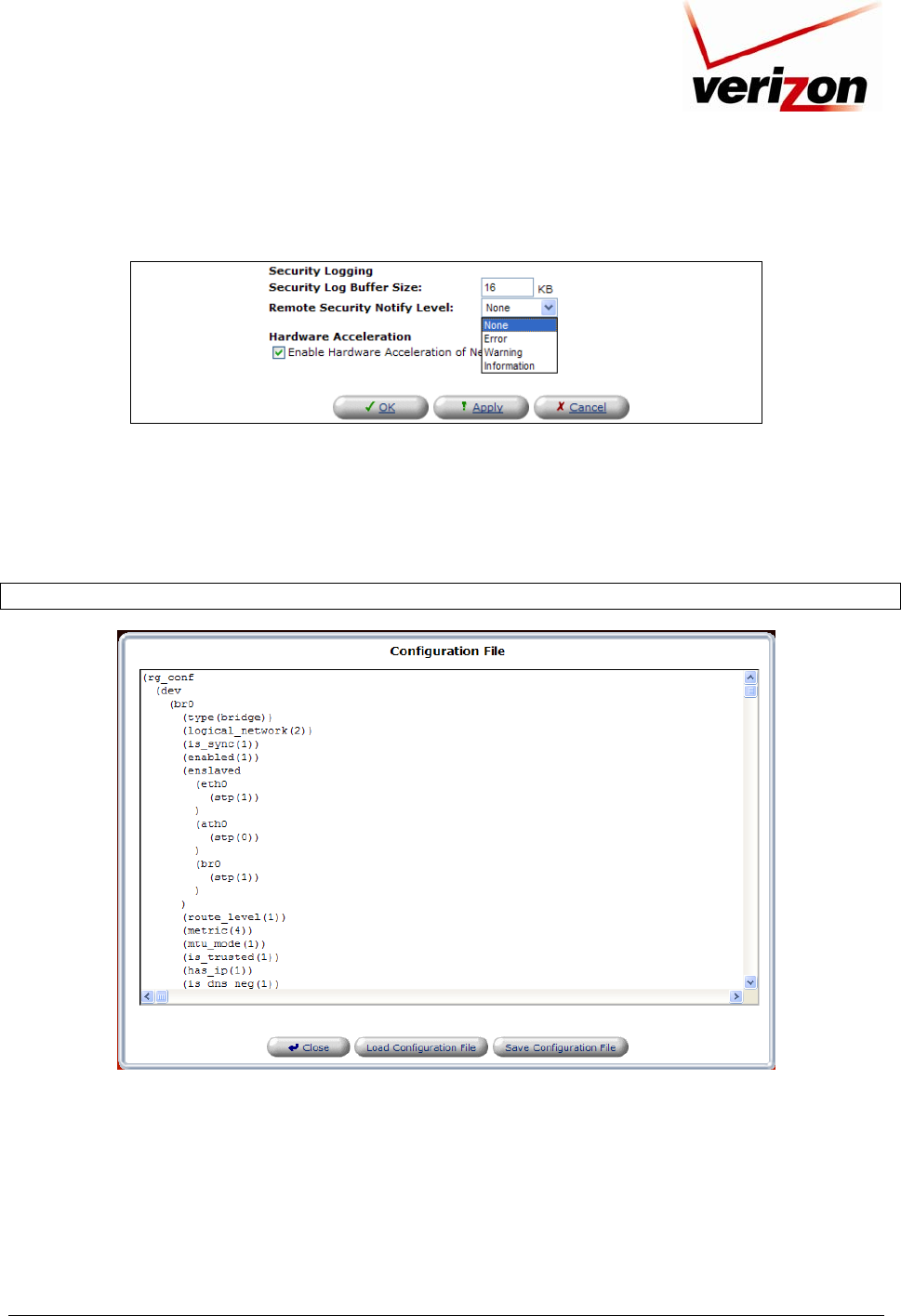
03/24/09 - DRAFT
030-300554 Rev. C 193 March 2009
Verizon FiOS Router
(
Model 9100EM
)
User Guide
After you have configured the desired settings, click Apply to allow the settings to take effect in the Router.
15.17 Configuration File
If you click Advanced in the top navigation menu and then select the Configuration File link, the following screen
appears.
IMPORTANT: Do not change the settings in this page unless instructed by Verizon.
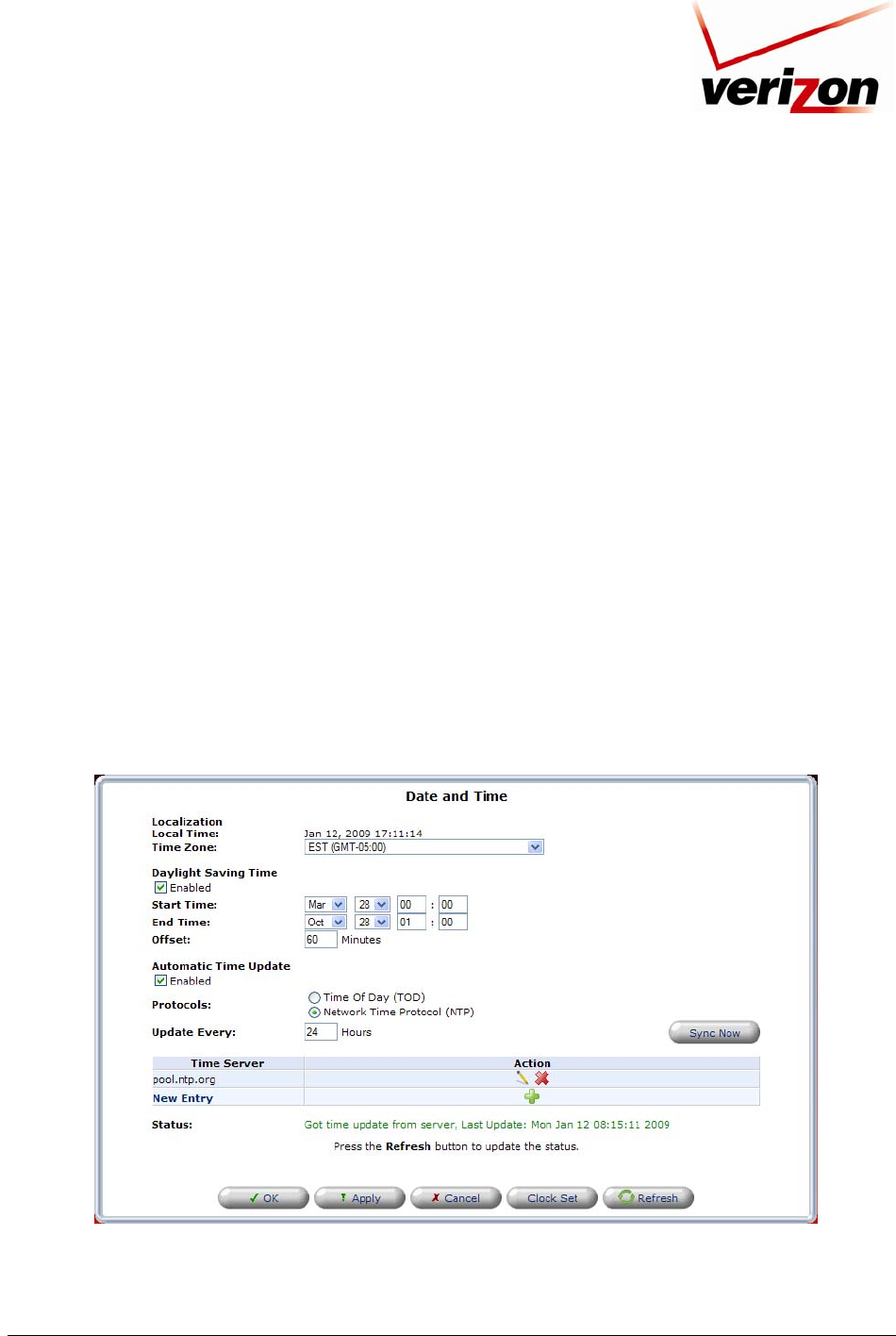
03/24/09 - DRAFT
030-300554 Rev. C 194 March 2009
Verizon FiOS Router
(
Model 9100EM
)
User Guide
15.18 Date and Time Rules
If you click Advanced in the top navigation menu and then select the Date and Time link, the following screen
appears. Enter the desired values in this screen, and then click Apply to save the settings.
The Router can automatically detect daylight saving setting for selected time zones. If the daylight saving settings
for a time zone are not automatically detected, the following fields will be displayed:
• Enabled—Click this check box to enable daylight saving time (a check mark will appear in the box).
• Start—Enter the date and time when daylight saving starts.
• End—Enter the date and time when daylight saving ends.
• Offset—Enter the time amount daylight saving time changes.
• Automatic Time Update—Click the check box to activate automatic time update (a check mark will appear
in the box).
• Protocols—Click the radio button for the protocol used to perform the time update.
• Update Every—Enter the desired value (in Hours) to specify how often to perform the update.
• Time Server—This table lists the address of the time server.
• Status—Displays a time update status.
• Sync Now—Click this button to synchronize the Router’s time with your computer operating system’s time.
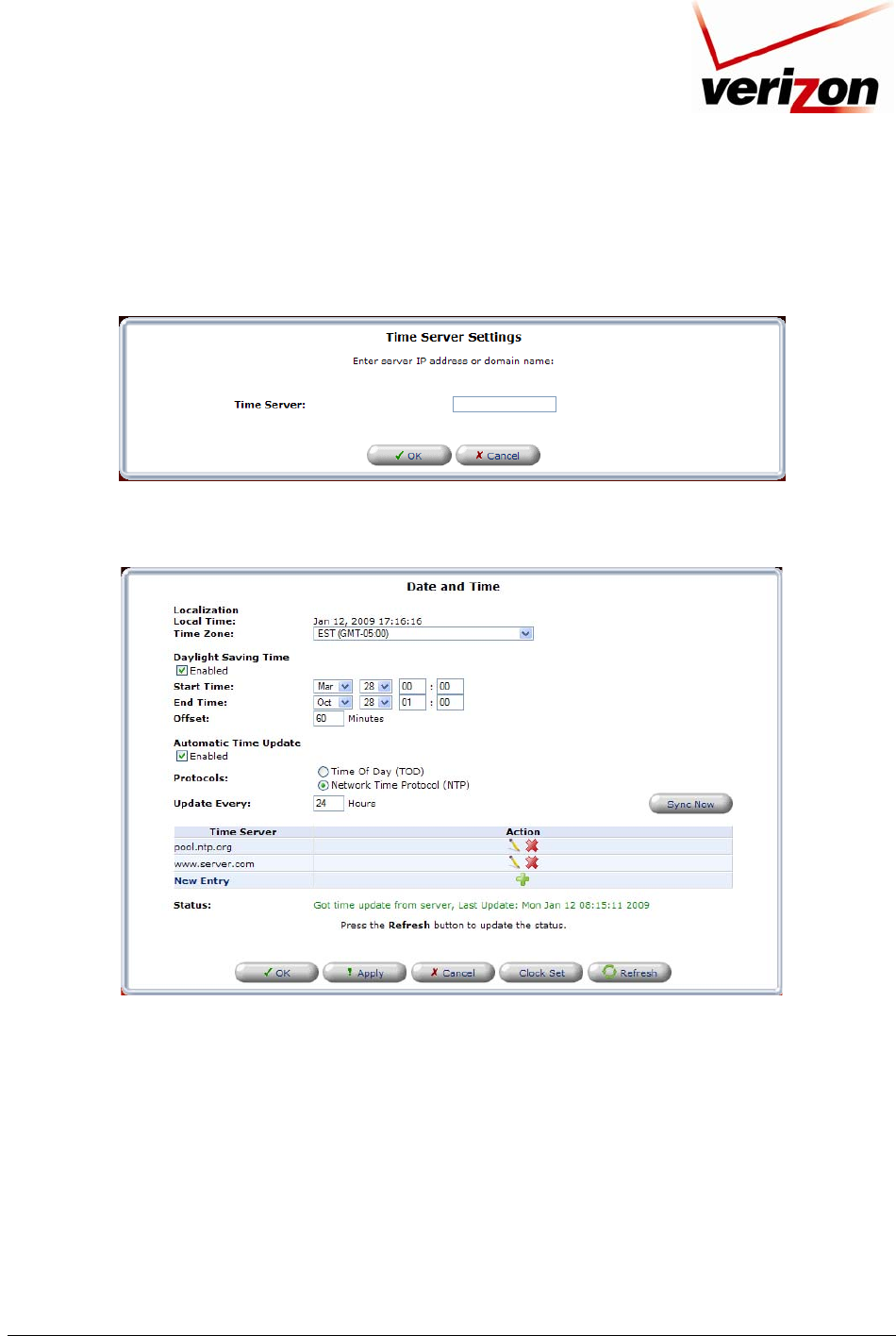
03/24/09 - DRAFT
030-300554 Rev. C 195 March 2009
Verizon FiOS Router
(
Model 9100EM
)
User Guide
15.19 Editing the Time Server Table
If you click the New Entry link under Time Server, the following screen appears. Enter a server IP address or
domain name in the field provided, and then click OK to continue.
The entry will be added to the time server table. To remove server address from the Time Server table, click the “X”
icon next to the server to want to remove. Then, click Apply to save the changes.
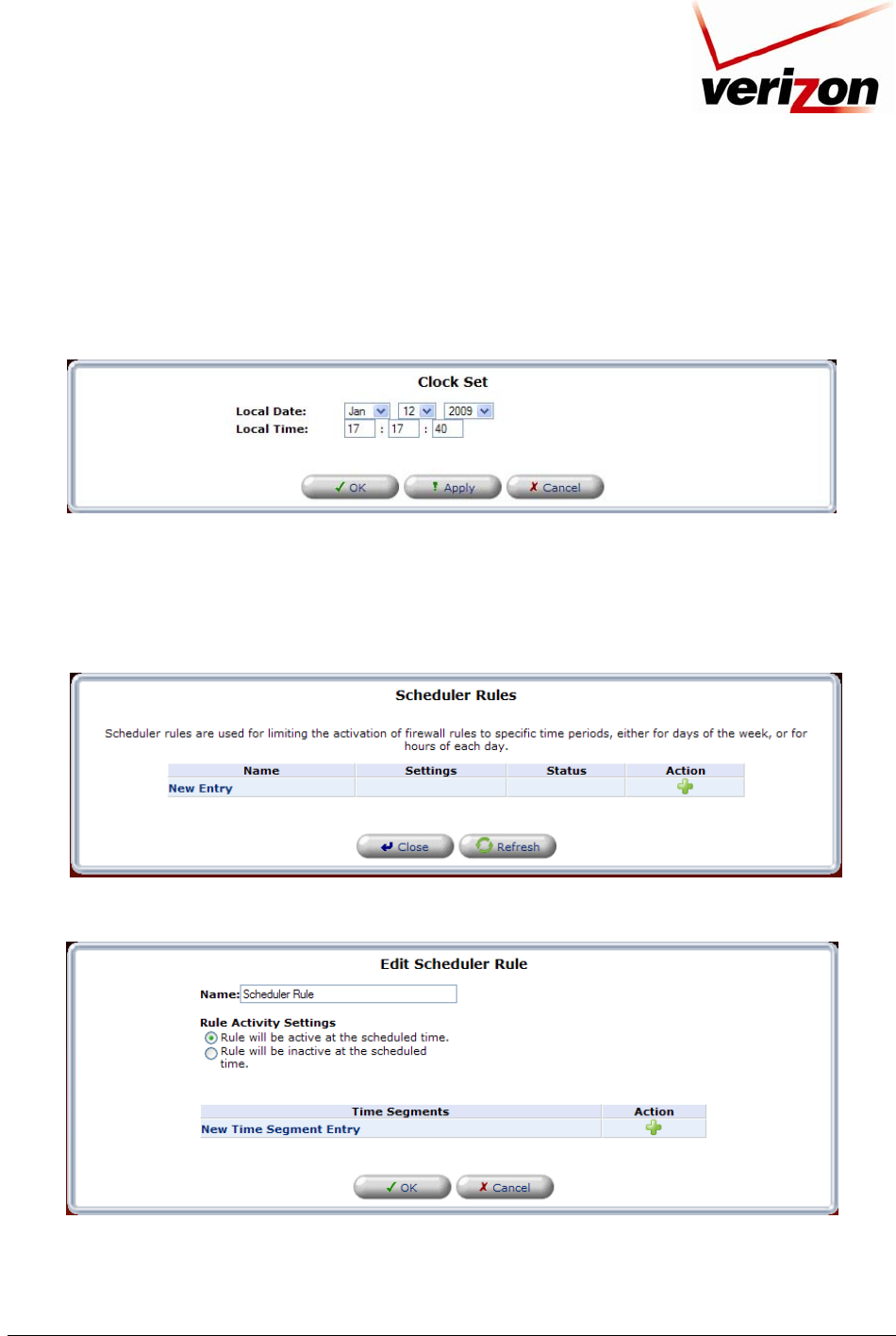
03/24/09 - DRAFT
030-300554 Rev. C 196 March 2009
Verizon FiOS Router
(
Model 9100EM
)
User Guide
15.20 Editing Clock Set
If you click the Clock Set button in the Date and Time screen, the following screen appears. Enter your local time
by selecting the appropriate values from the month, day, and year drop-down lists. Next, enter your local time
(starting with hours, minutes, and seconds) in the fields provided. Click Apply to save the settings. Then click OK
to return to the Date and Time screen.
15.21 Scheduler Rules
If you click Advanced in the top navigation menu and then select the Scheduler Rules link, the following screen
appears. To configure a schedule rule, click the New Entry link.
The following screen appears. Click the New Time Segment Entry link or, alternatively, click the plus icon.
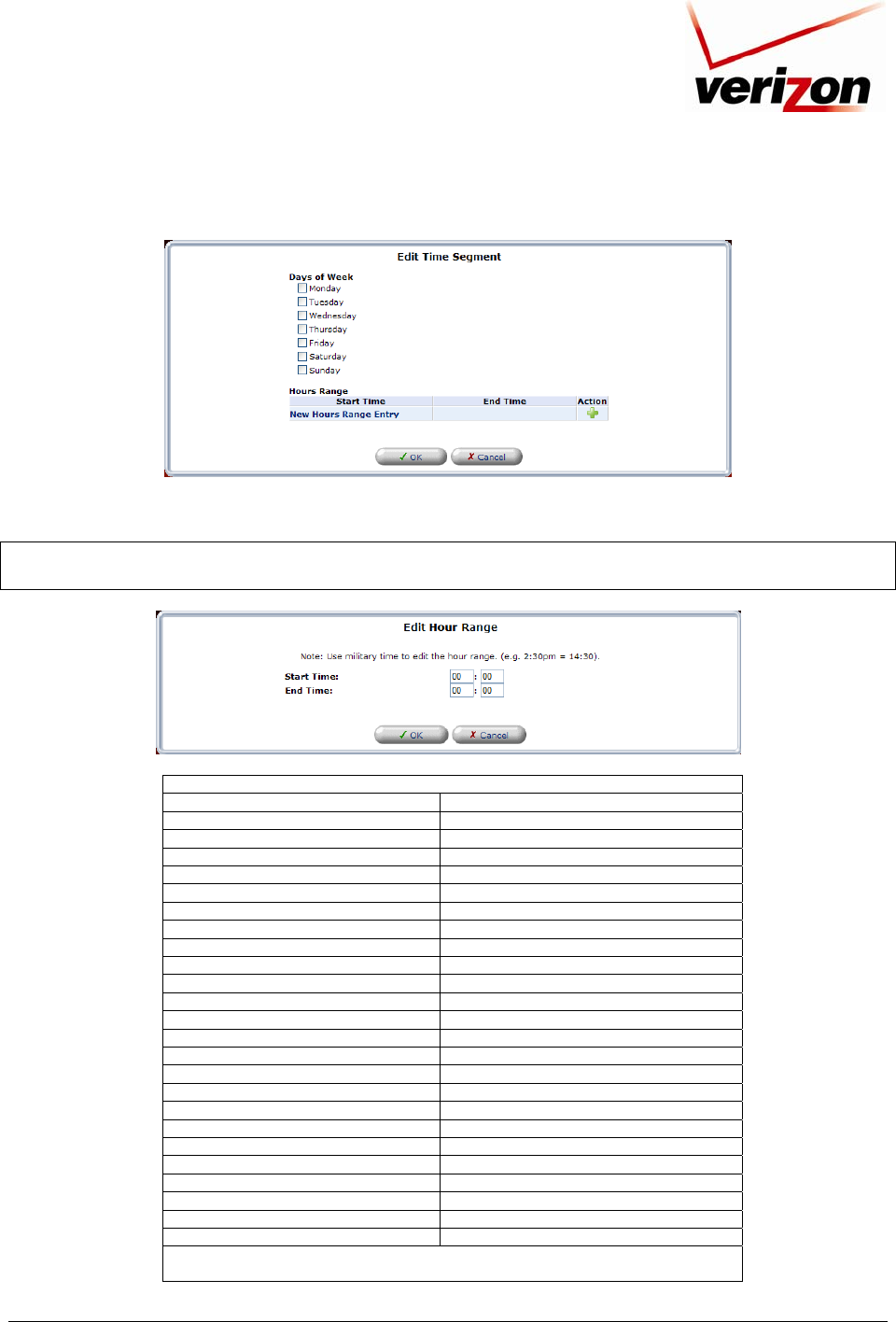
03/24/09 - DRAFT
030-300554 Rev. C 197 March 2009
Verizon FiOS Router
(
Model 9100EM
)
User Guide
If you clicked New Time Segment Entry, the following appears. Click the New Hours Range Entry link.
The following screen appears. Enter the desired start time and end time values in the fields provided.
Note: Use military time to edit the Hour range. For example, 2:00 P.M. standard time is equivalent to 14:00 military
time, as indicated in the following chart.
Military Time Chart
Standard Time Military Time
1:00 A.M. 0100
2:00 A.M. 0200
3:00 A.M. 0300
4:00 A.M. 0400
5:00 A.M. 0500
6:00 A.M. 0600
7:00 A.M. 0700
8:00 A.M. 0800
9:00 A.M. 0900
10:00 A.M. 1000
11:00 A.M. 1100
12:00 P.M. (Noon) 1200
1:00 P.M. 1300
2:00 P.M. 1400
3:00 P.M. 1500
4:00 P.M. 1600
5:00 P.M. 1700
6:00 P.M. 1800
7:00 P.M. 1900
8:00 P.M. 2000
9:00 P.M. 2100
10:00 P.M. 2200
11:00 P.M. 2300
12:00 A.M. (Midnight) 0000
A.M. = Ante Meridiem. The period from midnight until noon.
P.M. = Post Meridiem. The period between noon and midnight.

03/24/09 - DRAFT
030-300554 Rev. C 198 March 2009
Verizon FiOS Router
(
Model 9100EM
)
User Guide
For an example, the values in the following screen represent military hours. After you have entered your desired
values, click OK to continue.
If you clicked OK the following screen appears. Click the check box for each day that you want to apply the time
segment (a check mark will appear in the box). Click OK to continue.
After you have set up the desired time segment and clicked OK, the following screen appears. If desired, you can
enter a name for the schedule rule in the Name field.
Under Rule Activity Settings, be sure to click the setting that you want assigned to the rule:
• Click the first radio button to allow the rule to be active at the scheduled time.
• Click the second radio button to allow the rule to be inactive at the scheduled time.
For example, this screen shows that a schedule has been added to the Time Segments table, and that the rule will be
active at the scheduled time. To add additional schedule rules to your Router, repeat the preceding scheduler rules
instructions. Then, click OK in the Edit Scheduler Rule screen to allow the settings to take effect in the Router.
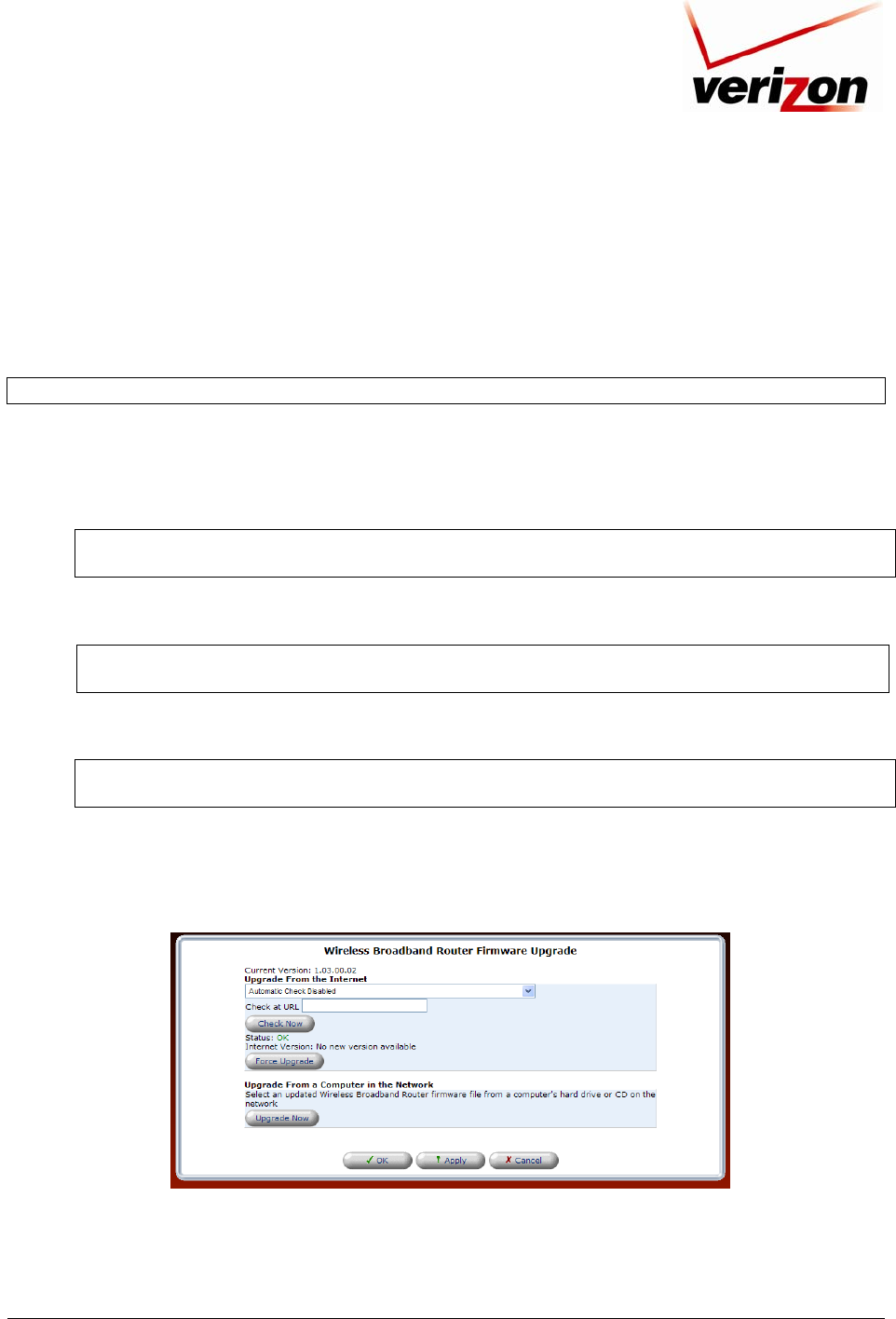
03/24/09 - DRAFT
030-300554 Rev. C 199 March 2009
Verizon FiOS Router
(
Model 9100EM
)
User Guide
15.22 Firmware Upgrade
If you click Advanced in the top navigation menu and then select the Firmware Upgrade link, the following screen
appears. This screen is used to update the firmware that controls the operation of your Router. The updated firmware
may be loaded from a CD-ROM, from a file stored on a local hard drive within your network, or from an update file
stored on an Internet server.
IMPORTANT: The configurable settings of your Router may be erased during the upgrade process.
Do any of the following:
• Select the desired option from the Upgrade from the Internet drop-down list. You can choose to perform an
automatic check at the specified number of hours and URL. Or you can disable automatic check.
NOTE: The URL must be in the format: protocol://user:password@host:port/path where protocol is one of
http, https, ftp or tftp. Either user or password, or both, may be left out. The port number is also optional.
• Click Check Now to retrieve the firmware update file and display any available update information. You
must be connected to the Internet to use this option.
NOTE: If you click Check Now and the page returns “No new version available,” this indicates that the
firmware update file is not available.
• Click Force Upgrade to download the firmware update file and to automatically update the Router
firmware if an update is available and applicable. You must be connected to the Internet to use this option.
NOTE: The URL must be in the format: protocol://user:password@host:port/path where protocol is one of
http, https, ftp or tftp. Either user or password, or both, may be left out. The port number is also optional.
• Click Upgrade Now to retrieve the firmware update file from a local hard drive or CD-ROM on your
Network. Internet connection is not required for this option.
For example, to upgrade your Router, click the Upgrade Now button.
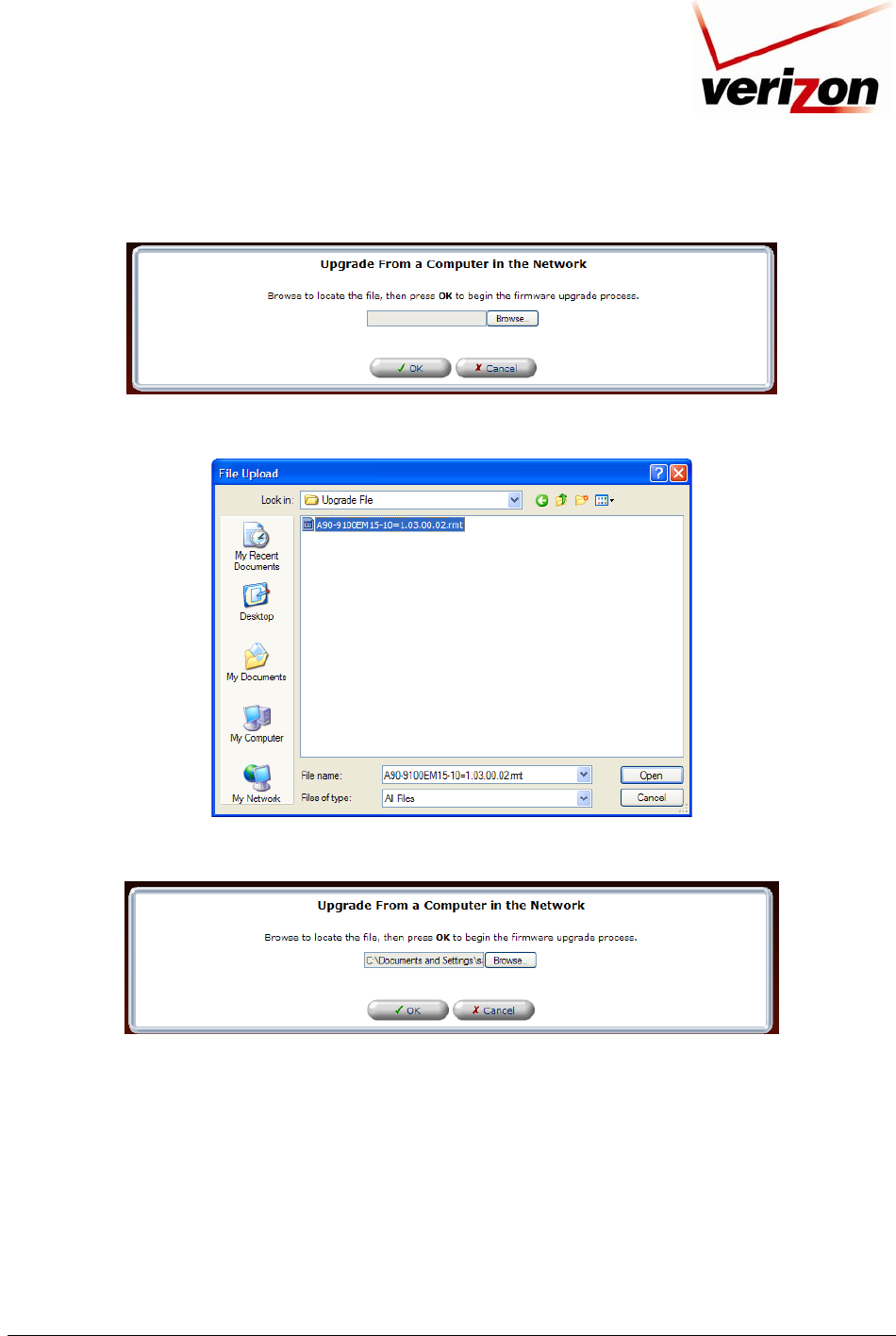
03/24/09 - DRAFT
030-300554 Rev. C 200 March 2009
Verizon FiOS Router
(
Model 9100EM
)
User Guide
Next, click the Browse button to navigate to the location of the upgrade file.
Once you have located the file, double-click the file to select it.
The pathname of the file will appear in the Browse field, as shown below. Click OK to continue.
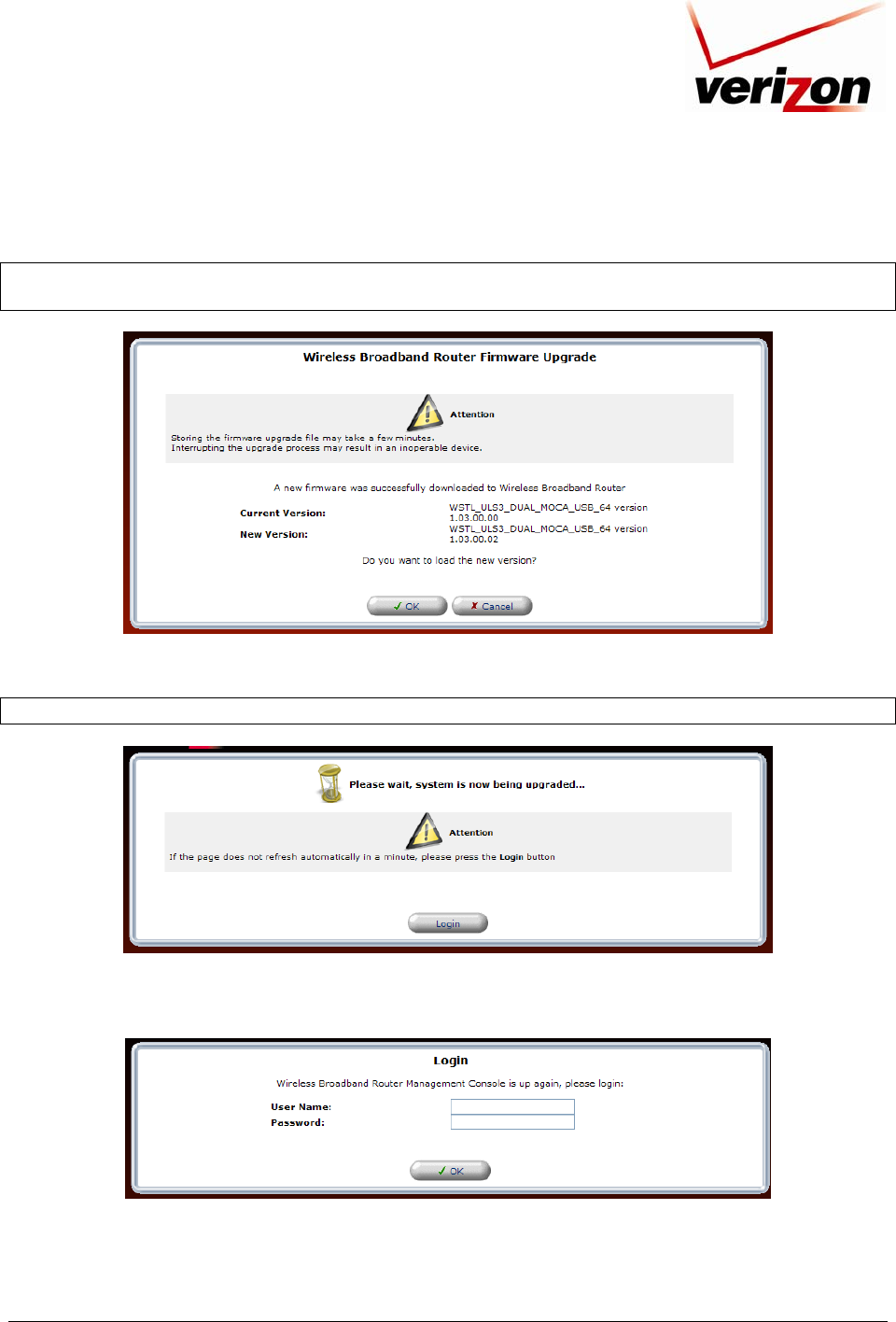
03/24/09 - DRAFT
030-300554 Rev. C 201 March 2009
Verizon FiOS Router
(
Model 9100EM
)
User Guide
Next, the Router will prompt you to confirm that you want to load the new version. Click OK to load the new
version.
IMPORTANT: Please do not attempt to use the Router during the upgrade process. Interrupting the upgrade
process may result in an inoperable device.
The Router will begin the upgrade process. Please wait a brief moment for the upgrade to complete.
NOTE: If the page does not refresh automatically in a minute, click the Login button.
After the upgrade has completed, the following screen will appear. Please type your user name and password to log
in to your Router.
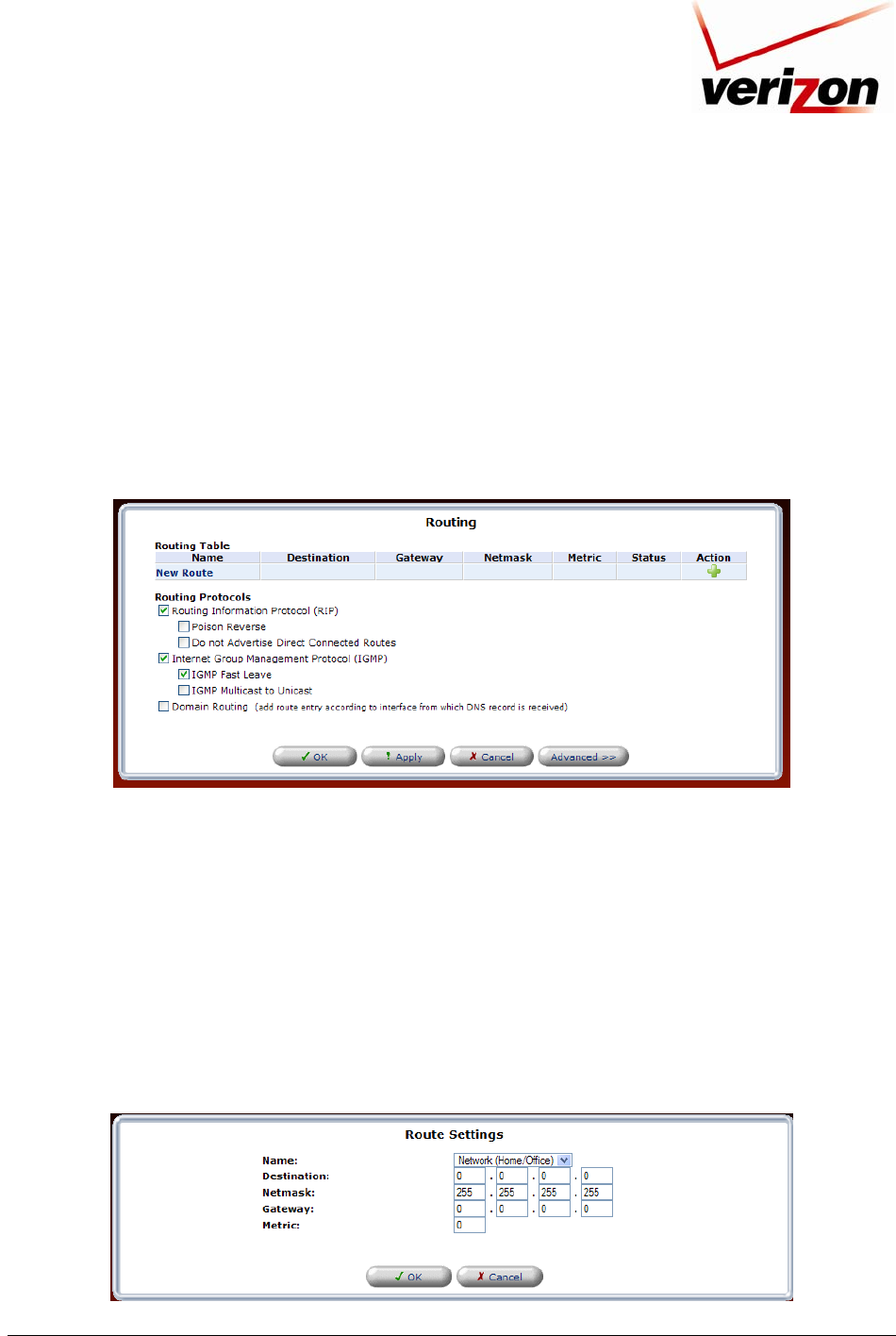
03/24/09 - DRAFT
030-300554 Rev. C 202 March 2009
Verizon FiOS Router
(
Model 9100EM
)
User Guide
15.23 Routing
If you click Advanced in the top navigation menu and then select the Routing link, the following screen appears.
You can choose to setup your Router to use static or dynamic routing. Dynamic routing automatically adjusts how
packets travel on the network, whereas static routing specifies a fixed routing path to neighboring destinations.
15.23.1 Basic Routing Settings
To create a new route, click the New Route link. If you change any settings in this screen, click Apply to save the
settings.
If you clicked New Route, the following screen appears. Configure the settings in this screen, and then click OK to
continue.
• Rule Name—Select the type of network from the drop-down list.
• Destination—Enter the destination is the destination host, subnet address, network address, or default route.
The destination for a default route is 0.0.0.0.
• Netmask—Enter the network mask is used in conjunction with the destination to determine when a route is
used.
• Gateway—Enter the Router’s IP address.
• Metric—Enter the desired measurement of the preference of a route. Typically, the lowest metric is the most
preferred route. If multiple routes exist to a given destination network, the route with the lowest metric is used.
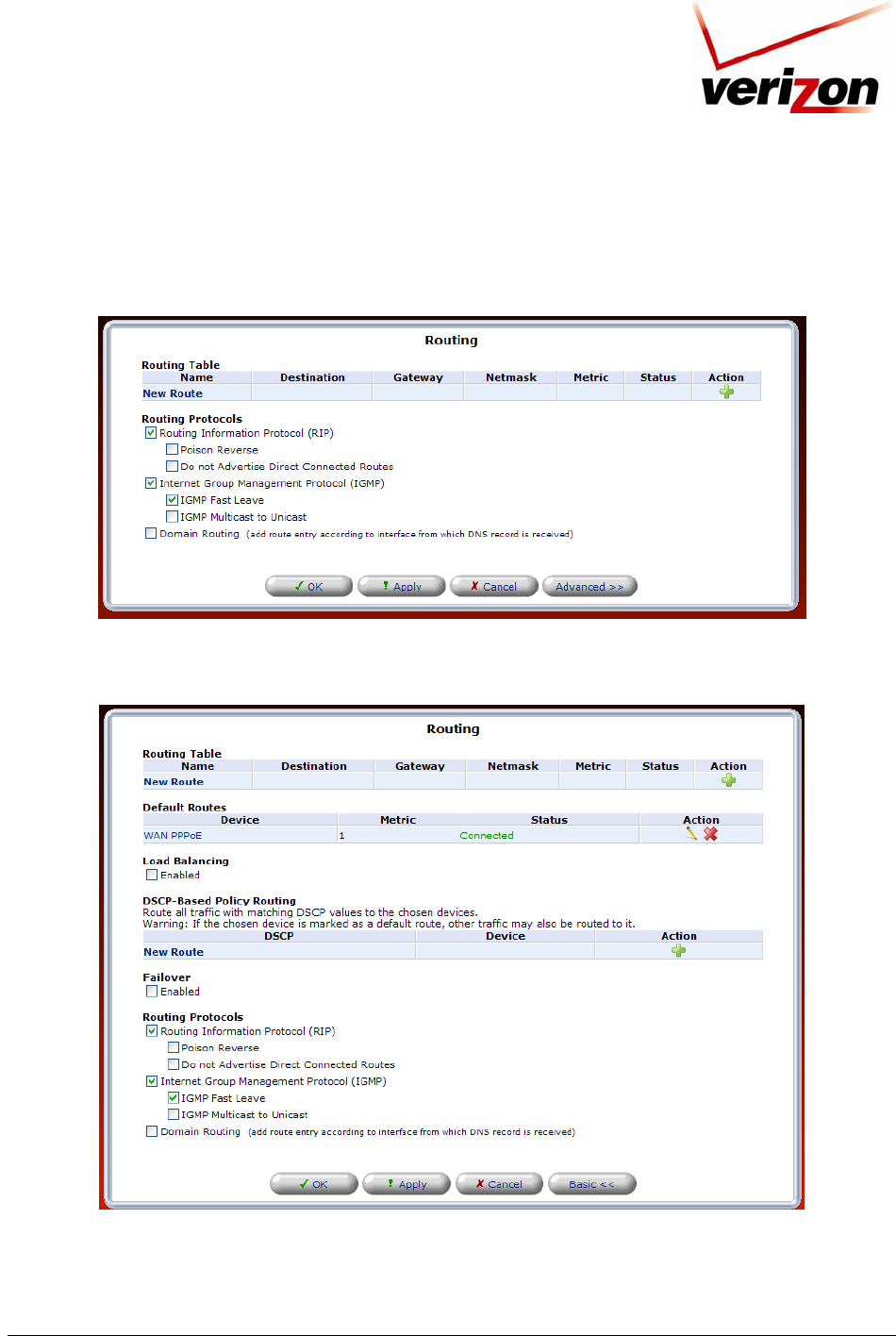
03/24/09 - DRAFT
030-300554 Rev. C 203 March 2009
Verizon FiOS Router
(
Model 9100EM
)
User Guide
15.23.2 Advanced Routing Settings
To configure advanced routing settings, click the Advanced button in the Routing screen.
If you clicked the Advanced button, the following screen appears. If you change any settings in this screen, click
Apply to save the settings.
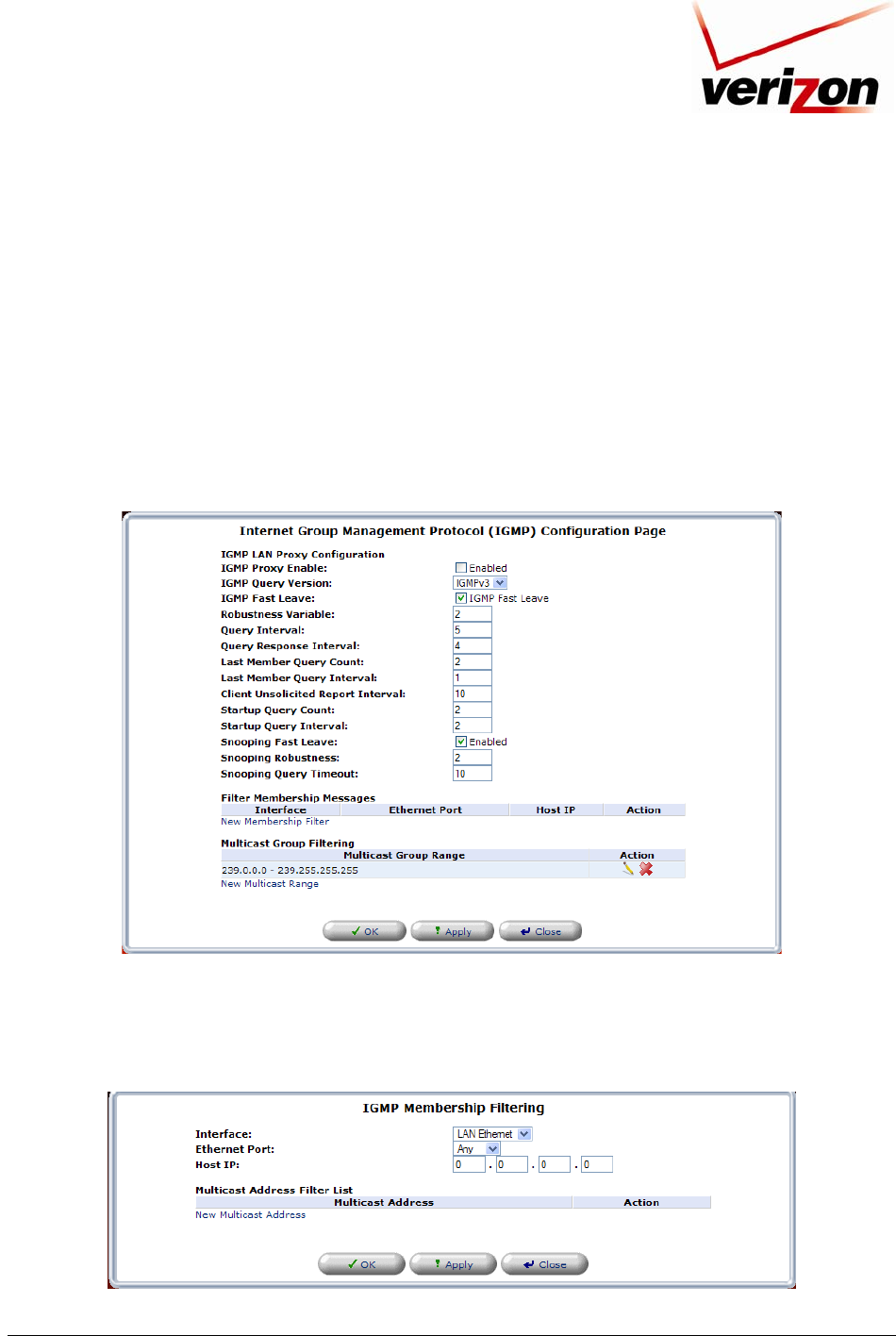
03/24/09 - DRAFT
030-300554 Rev. C 204 March 2009
Verizon FiOS Router
(
Model 9100EM
)
User Guide
15.24 IGMP Configuration
If you click Advanced in the top navigation menu and then select the IGMP Configuration link, the following
screen appears. This screen allows you to configure IGMP LAN Proxy configuration settings in your Router.
The Router supports IGMP multicasting, which allows hosts connected to a network to be updated whenever an
important change occurs in the network. A multicast is simply a message that is sent simultaneously to a predefined
group of recipients. Each member of the multicast group will receive all messages addressed to the group.
IGMP proxy enables multicast packets to be routed according to the IGMP requests of local network devices
requesting to join multicast groups. To enable IGMP Proxy, click the adjacent check box, a check mark will appear
in the box. Next, enter the appropriate values in the fields provided and click Apply to save the settings.
15.24.1 New Membership Filter
If you clicked the New Membership Filter link in the preceding screen, the following screen appears.

03/24/09 - DRAFT
030-300554 Rev. C 205 March 2009
Verizon FiOS Router
(
Model 9100EM
)
User Guide
Select the desired settings for the membership filter you want to create. Then click Apply to save the settings.
15.24.2 New Multicast Address
If you clicked the New Multicast Address link in the preceding screen, the following screen appears. Enter
multicast address and then click Apply. If desired, repeat this process to enter additional multicast addresses. After
you have finished entering addresses, click Close to return to the IGMP Membership Filtering screen.
The addresses will be displayed in the list of Multicast Addresses.
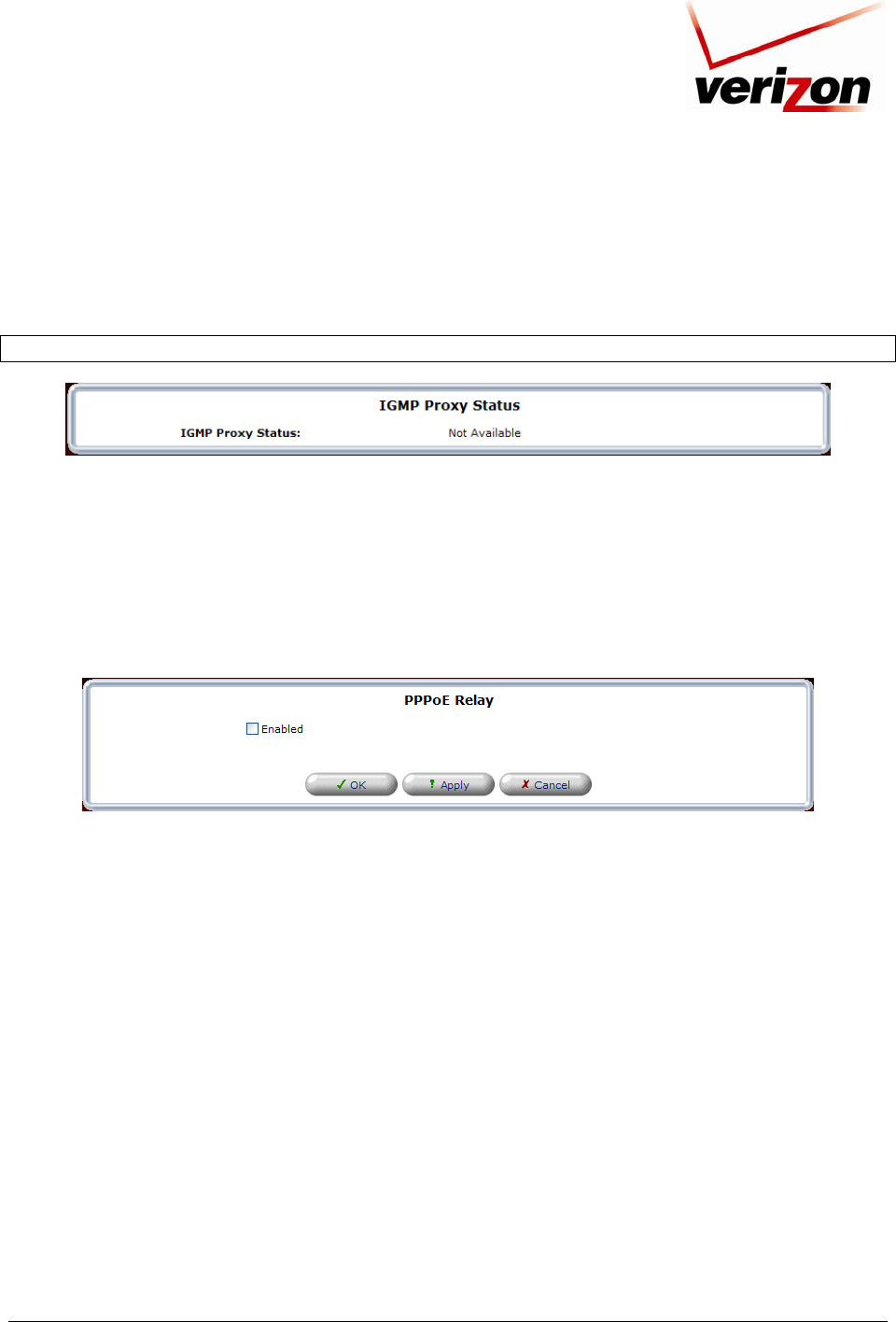
03/24/09 - DRAFT
030-300554 Rev. C 206 March 2009
Verizon FiOS Router
(
Model 9100EM
)
User Guide
15.25 IGMP Status
If you click Advanced in the top navigation menu and then select the IGMP Status link, the following screen
appears.
NOTE: If IGMP proxy is not enabled, the IGMP Proxy Status panel will be empty.
15.26 PPPoE Relay
If you click Advanced in the top navigation menu and then select the PPPoE Relay link, the following screen
appears. PPPoE Relay enables the Router to relay packets on PPPoE connections, while keeping its designated
functionality for any additional connections.
To activate PPPoE Relay, click the check box (check mark will appear in the box). Click Apply to save the settings.
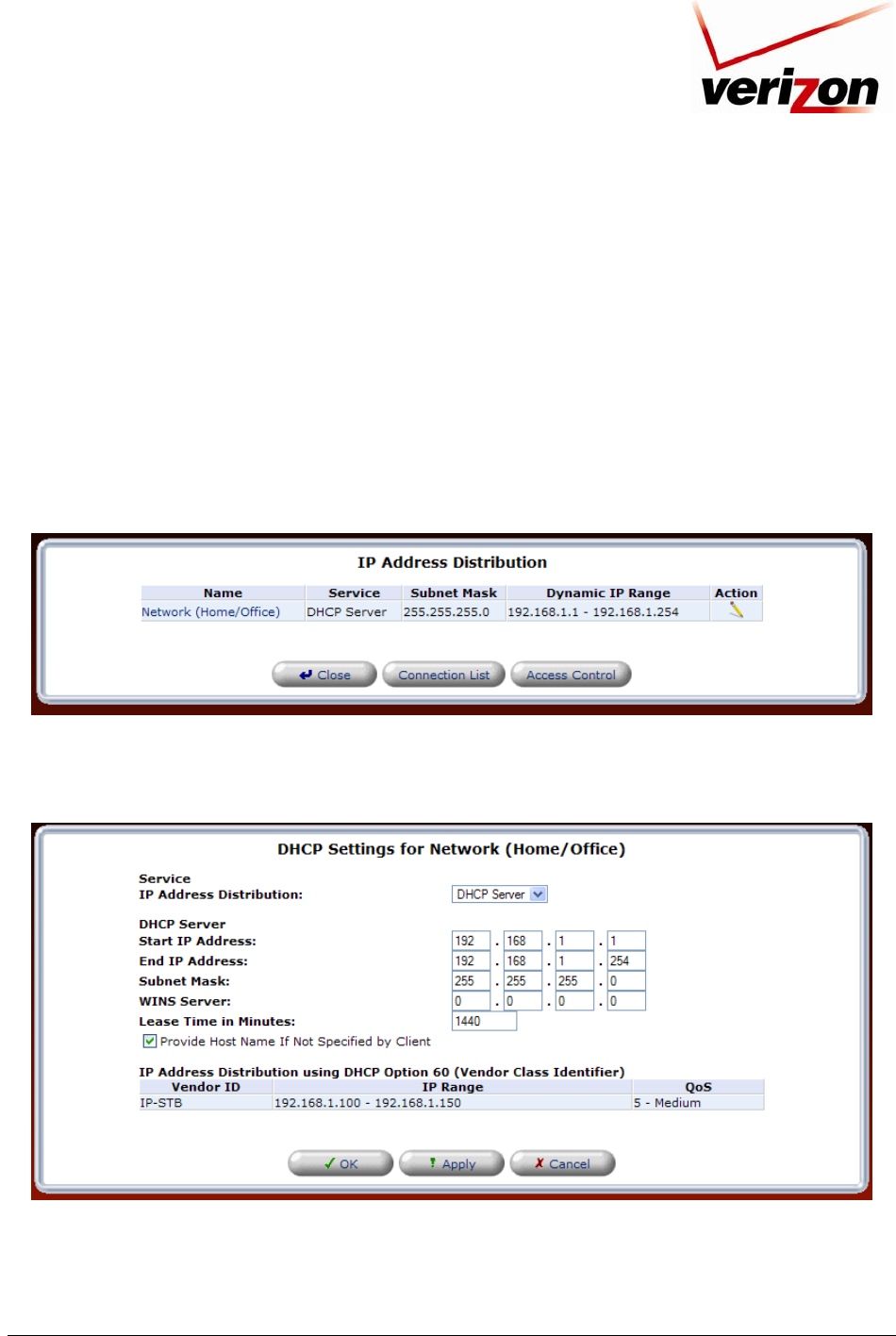
03/24/09 - DRAFT
030-300554 Rev. C 207 March 2009
Verizon FiOS Router
(
Model 9100EM
)
User Guide
15.27 IP Address Distribution
If you click Advanced in the top navigation menu and then select the IP Address Distribution link, the following
screen appears.
Your Router's Dynamic Host Configuration Protocol (DHCP) server makes it possible to easily add computers that
are configured as DHCP clients to the home network. It provides a mechanism for allocating IP addresses and
delivering network configuration parameters to such hosts. The Router’s default DHCP server is the LAN bridge.
A client (host) sends out a broadcast message on the LAN requesting an IP address for itself. The DHCP server then
checks its list of available addresses and leases a local IP address to the host for a specific period and simultaneously
designates this IP address as “taken.” At this point the host is configured with an IP address for the duration of the
lease.
To configure the DHCP Sever settings, click the Network (Home/Office) link, the following screen appears. Enter
the desired DHCP settings in the fields provided, and then click Apply to save the settings.
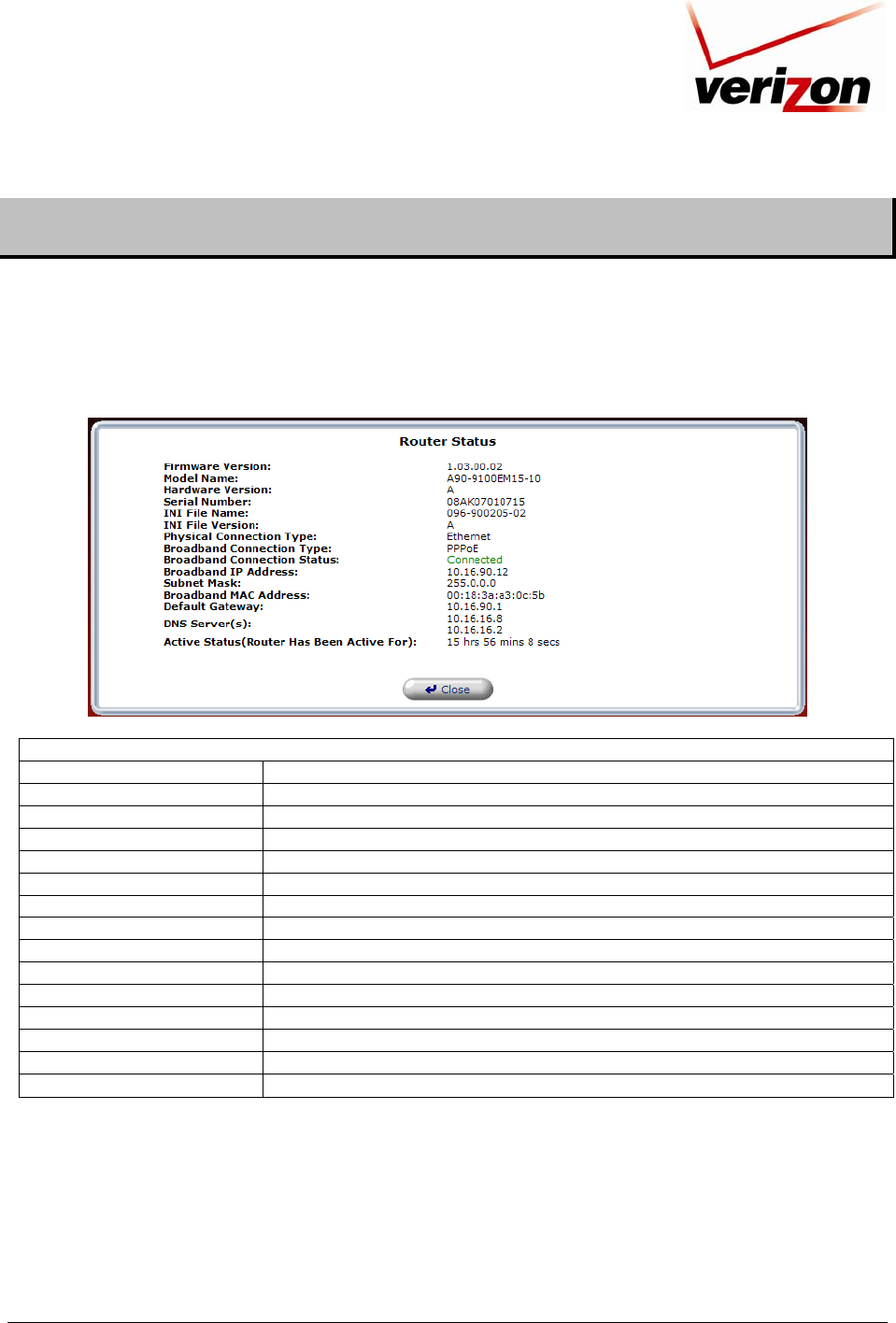
03/24/09 - DRAFT
030-300554 Rev. C 208 March 2009
Verizon FiOS Router
(
Model 9100EM
)
User Guide
16. SYSTEM MONITORING
16.1 Router Status
If you click System Monitoring in the top navigation menu, the following screen appears. After you have finished
viewing information about your Router, click Close.
Router Status
Firmware Version The Router’s software version.
Model Number The Router manufacturer’s model number.
Hardware Version The Router manufacturer’s hardware version.
Serial Number The Router’s serial number
INI File Name The Router’s INI file name.
INI File Version The Router’s INI file version.
Physical Connection Type The Interface used for the Router’s broadband connection.
Broadband Connection Type The Protocol used for the Router’s broadband connection
Broadband Connection Status The status (connected or disconnected) of the Router’s broadband connection.
Broadband IP Address The Router’s broadband (WAN) IP address.
Subnet Mask The Router’s subnet address.
Broadband MAC Address The Router’s media access controller address-hardware address of the Router.
Default Gateway The Router’s default gateway IP address.
DNS Server(s) The gateway’s DNS server(s) addresses.
Active Status The period that the Router has had an active broadband connection.
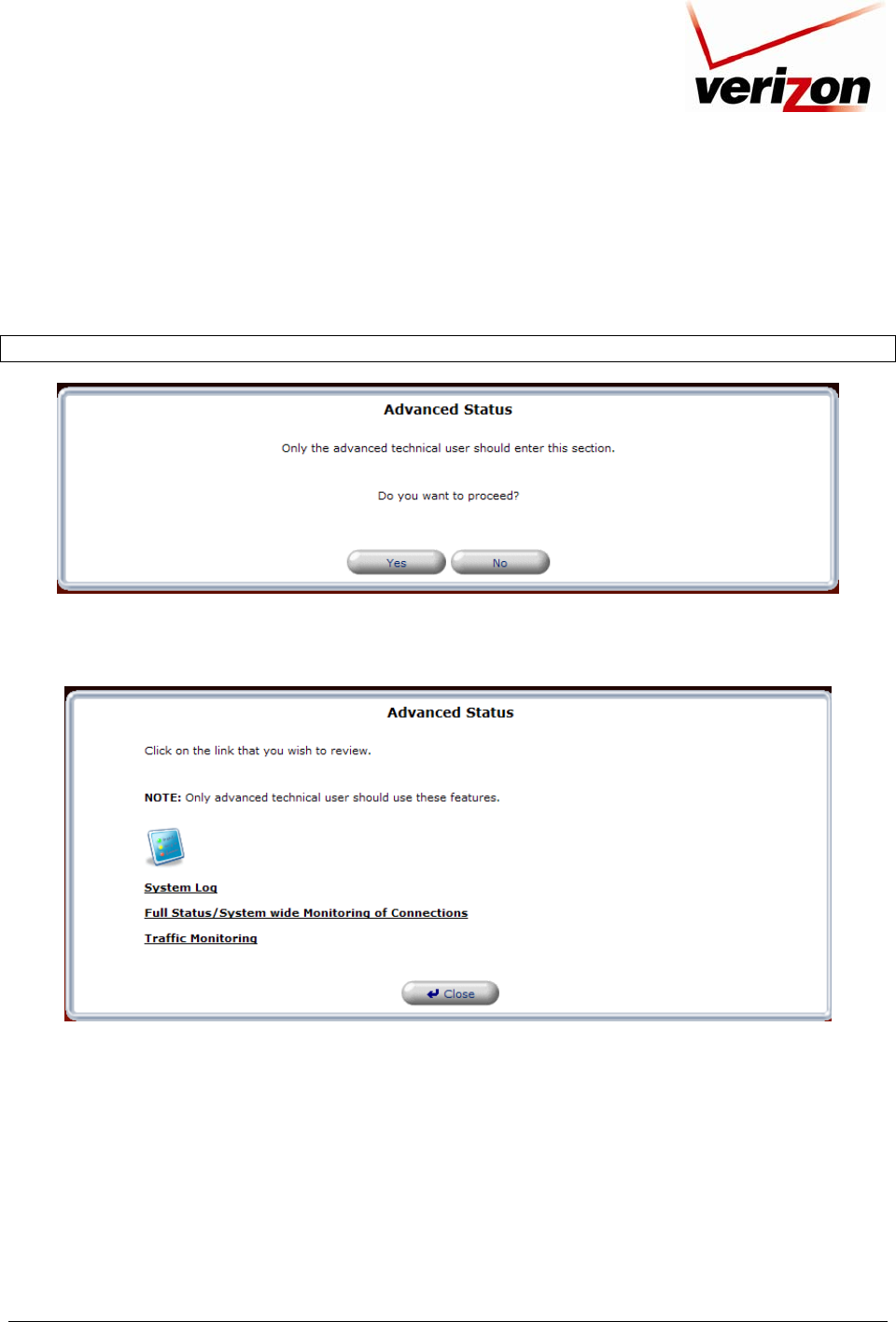
03/24/09 - DRAFT
030-300554 Rev. C 209 March 2009
Verizon FiOS Router
(
Model 9100EM
)
User Guide
16.2 Advanced Status
If you click System Monitoring in the top navigation menu, and then click Advanced Status in the left submenu,
the following screen appears. Click Yes to proceed.
NOTE: Only the advanced technical user should enter this section.
The following screen displays connection information for devices connected to your Router. Click the link that you
wish to review.
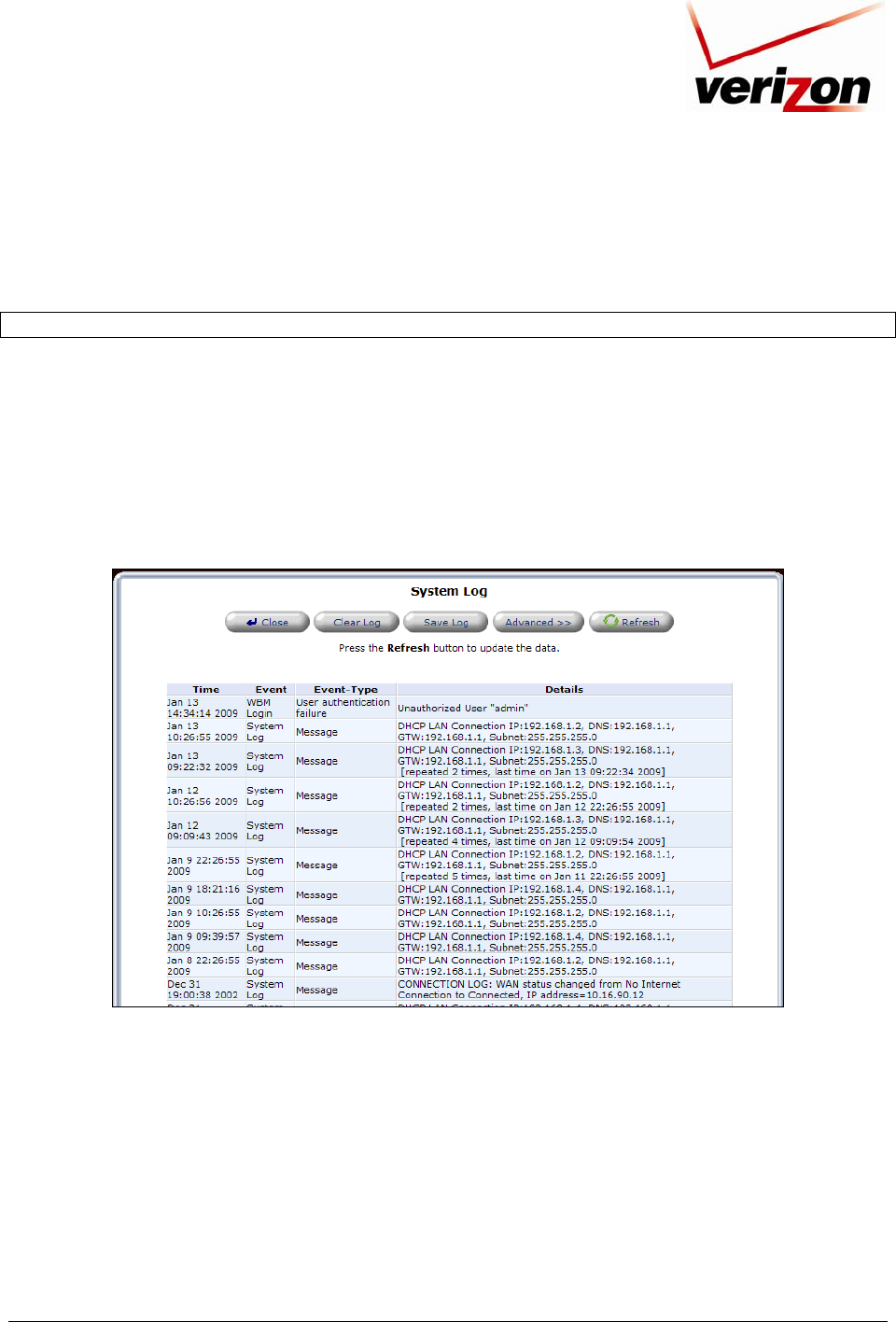
03/24/09 - DRAFT
030-300554 Rev. C 210 March 2009
Verizon FiOS Router
(
Model 9100EM
)
User Guide
16.2.1 System Log
If you click the System Log link, the following screen appears. This screen displays the details of your system’s
logged events.
NOTE: Only the advanced technical user should enter this section.
At this screen, you can do any of the following:
• Click the Refresh button to manually update this screen to display the most current details.
• Click Advanced to go to the advanced System Log screen.
• Click Save Log, and then follow the instructions to save the system log to the desired location.
• Click Clear Log to remove all logs from the list.
• Click Close to return to the Advanced Status screen.
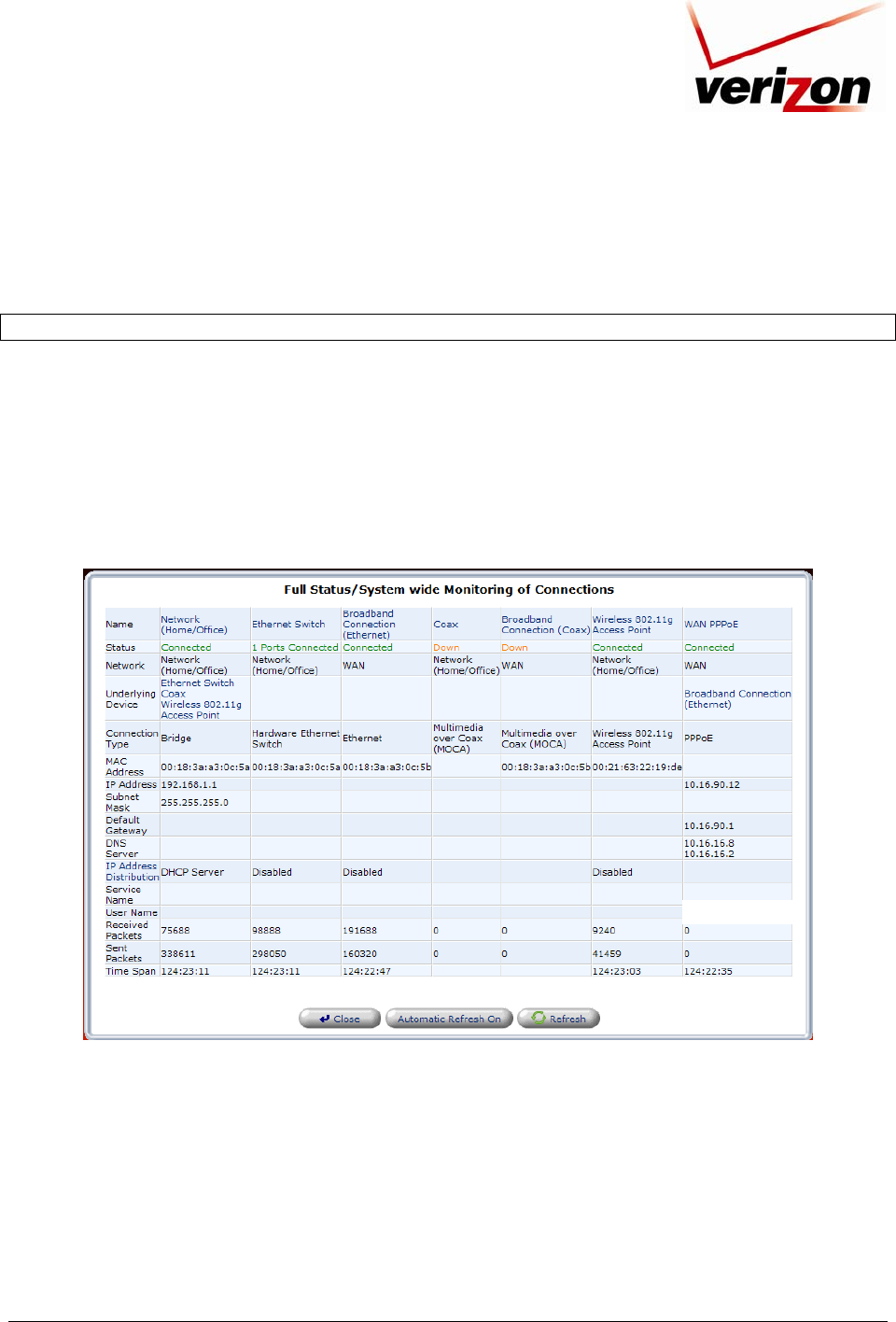
03/24/09 - DRAFT
030-300554 Rev. C 211 March 2009
Verizon FiOS Router
(
Model 9100EM
)
User Guide
16.2.2 Full Status/System Wide Monitoring of Connection
If you click the Full Status/System Wide Monitoring of Connections link, the following screen appears. This
screen displays the details of your system’s logged connections.
NOTE: Only the advanced technical user should enter this section.
At this screen, you can do any of the following:
• Click the Automatic Refresh On/Off button to turn on/off Automatic Refresh. When Automatic Refresh is
On, the screen will be updated automatically to display the most current statistics.
• Click Refresh to manually update this screen to display the most current details.
• Click the links in this screen to access the Router’s settings.
• Click Close to return to the Advanced Status screen.
verizonfios
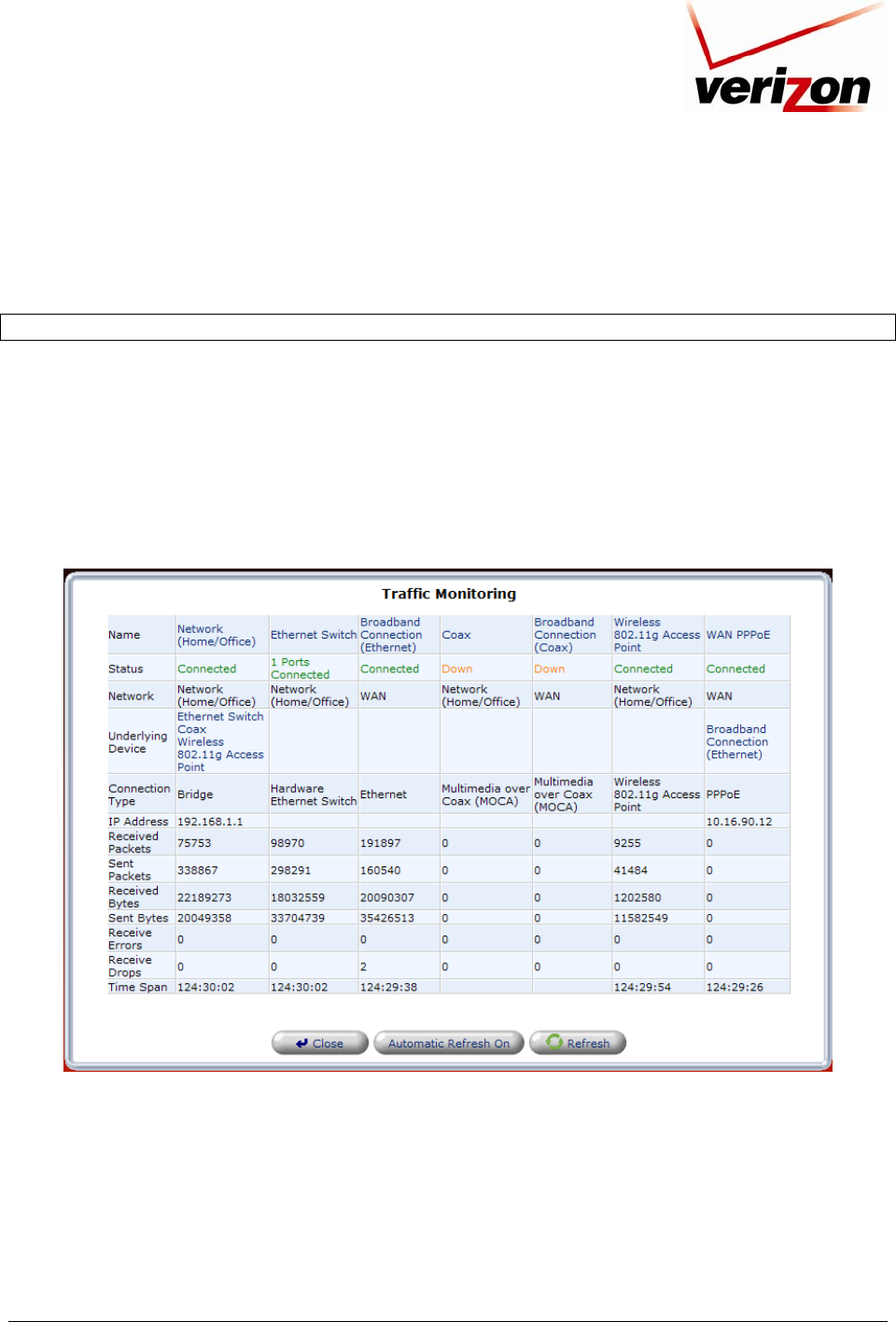
03/24/09 - DRAFT
030-300554 Rev. C 212 March 2009
Verizon FiOS Router
(
Model 9100EM
)
User Guide
16.2.3 Traffic Monitoring
If you click the Traffic Monitoring link, the following screen appears. This screen displays the details of your
system’s logged traffic.
NOTE: Only the advanced technical user should enter this section.
At this screen, you can do any of the following:
• Click the Automatic Refresh On/Off button to turn on/off Automatic Refresh. When Automatic Refresh is
On, the screen will be updated automatically to display the most current statistics.
• Click Refresh to manually update this screen to display the most current details.
• Click the links in this screen to access the Router’s settings.
• Click Close to return to the Advanced Status screen.

03/24/09 - DRAFT
030-300554 Rev. C 213 March 2009
Verizon FiOS Router
(
Model 9100EM
)
User Guide
17. TECHNICAL SUPPORT INFORMATION
Contact your Internet service provider for technical support.
18. PRODUCT SPECIFICATIONS
System Requirements for 10/100 Base-T/Ethernet
• Pentium® or equivalent class machines or
higher
• Microsoft Windows (Vista, XP, 2000, ME,
NT 4.0, 98 SE) Macintosh® OS X, or Linux
installed
• 64 MB RAM (128 MB recommended)
• 10 MB of free hard drive space
• 10/100 Base-T Network Interface Card
(NIC)
• Internet Explorer 5.5 or higher or Netscape
Navigator 7.x or higher
• Computer Operating System CD-ROM
System Requirements for Wireless
• Pentium® or equivalent class machines or
higher
• Microsoft Windows (Vista, XP, 2000,
ME, 98 SE) installed
• 64 MB RAM (128 MB recommended)
• 10 MB of free hard drive space
• Internet Explorer 5.5 or higher or
Netscape Navigator 7.x or higher
• Computer operating system CD-ROM
• IEEE 802.11b/g PC adapter
System Requirements for Coax
• Pentium® or equivalent class machines or
higher
• Microsoft Windows (Vista, XP, 2000,
ME, 98 SE) installed
• 64 MB RAM (128 MB recommended)
• 10 MB of free hard drive space
• Internet Explorer 5.5 or later or
• Netscape Navigator 7.x or higher or
• Firefox 1.0.7 or later
• Computer operating system CD-ROM
LEDs
• Power
• WAN Coax
• WAN Ethernet
• Internet
• Wi-Fi Protected Setup
• USB
• LAN Ethernet 1 through 4
• LAN Coax
• Wireless
Connectors
• COAX
• USB
• Ethernet: Four 8-pin RJ-45 modular jacks
• WAN: 8-pin RJ-45 modular jack
• Power: Barrel connector
Power
• Power Supply: 120 VAC to 12 VDC wall-
mount power supply
Dimensions
• Height: 1.7 in. (4.3 cm)
• Width: 9.0 in. (22.9 cm)
• Depth: 5.75 in. (14.6 cm)
Weight
• Approx. 1.25 lb (0.57 kg)
Environmental
• Relative Humidity: 5 to 95%, non-condensing
• Storage Temperature: -20 °C to 85 °C
(-4 °F to 185 °F)
• Ambient Temperature: 23 °C (73 °F)
EMC/Safety/Regulatory Certifications
• FCC Part 15, Class B
• FCC Part 68
• ANSI/UL Standard 60950-1
• CAN/CSA C22.2 No. 60950-1

03/24/09 - DRAFT
030-300554 Rev. C 214 March 2009
Verizon FiOS Router
(
Model 9100EM
)
User Guide
19. SOFTWARE LICENSE AGREEMENT
READ THE TERMS AND CONDITIONS OF THIS LICENSE AGREEMENT CAREFULLY. THIS
SOFTWARE IS COPYRIGHTED AND LICENSED (NOT SOLD). BY INSTALLING AND OPERATING
THIS PRODUCT, YOU ARE ACCEPTING AND AGREEING TO THE TERMS OF THIS LICENSE
AGREEMENT. IF YOU ARE NOT WILLING TO BE BOUND BY THE TERMS OF THIS LICENSE
AGREEMENT, YOU SHOULD PROMPTLY RETURN THE SOFTWARE AND HARDWARE TO
WESTELL TECHNOLOGIES, INC. THIS LICENSE AGREEMENT REPRESENTS THE ENTIRE
AGREEMENT CONCERNING THE SOFTWARE BETWEEN YOU AND WESTELL TECHNOLOGIES,
INC. (REFERRED TO AS "LICENSOR"), AND IT SUPERSEDES ANY PRIOR PROPOSAL,
REPRESENTATION, OR UNDERSTANDING BETWEEN THE PARTIES.
1. License Grant. Licensor hereby grants to you, and you accept, a nonexclusive license to use the Compact
Disk (CD) and the computer programs contained therein in machine-readable, object code form only
(collectively referred to as the "SOFTWARE"), and the accompanying User Documentation, only as
authorized in this License Agreement. The SOFTWARE may be used only in connection with the number of
systems for which you have paid license fees as dictated in your support agreement. You agree that you will
not assign, sublicense, transfer, pledge, lease, rent, or share your rights under this License Agreement. You
agree that you may not nor allow others to reverse assemble, reverse compile, or otherwise translate the
SOFTWARE.
You may retain the SOFTWARE CD for backup purposes only. In addition, you may make one copy of the
SOFTWARE in any storage medium for backup purposes only. You may make one copy of the User's
Manual for backup purposes only. Any such copies of the SOFTWARE or the User's Manual shall include
Licensor's copyright and other proprietary notices. Except as authorized under this paragraph, no copies of
the SOFTWARE or any portions thereof may be made by you or any person under your authority or control.
2. Licensor's Rights. You acknowledge and agree that the SOFTWARE and the User's Manual are
proprietary products of Licensor protected under U.S. copyright law. You further acknowledge and agree
that all right, title, and interest in and to the SOFTWARE, including associated intellectual property rights,
are and shall remain with Licensor. This License Agreement does not convey to you an interest in or to the
SOFTWARE, but only a limited right of use revocable in accordance with the terms of this License
Agreement.
3. License Fees. The fees paid by you under the support agreement are paid in consideration of the licenses
granted under this License Agreement.
4. Term. This License Agreement is effective upon your opening of this package and shall continue until
terminated. You may terminate this License Agreement at any time by returning the SOFTWARE and all
copies thereof and extracts there from to Licensor. Licensor may terminate this License Agreement upon the
breach by you of any term hereof. Upon such termination by Licensor, you agree to return to Licensor the
SOFTWARE and all copies and portions thereof.
5. Limitation of Liability. Licensor's cumulative liability to you or any other party for any loss or damages
resulting from any claims, demands, or actions arising out of or relating to this Agreement shall not exceed
the license fee paid to Licensor for the use of the SOFTWARE. In no event shall Licensor be liable for any
indirect, incidental, consequential, special, or exemplary damages or lost profits, even if Licensor has been
advised of the possibility of such damages. SOME STATES DO NOT ALLOW THE LIMITATION OR
EXCLUSION OF LIABILITY FOR INCIDENTAL OR CONSEQUENTIAL DAMAGES, SO THE ABOVE
LIMITATION OR EXCLUSION MAY NOT APPLY TO YOU.

03/24/09 - DRAFT
030-300554 Rev. C 215 March 2009
Verizon FiOS Router
(
Model 9100EM
)
User Guide
6. Governing Law. This License Agreement shall be construed and governed in accordance with the laws of
the State of Illinois. You submit to the jurisdiction of the state and federal courts of the state of Illinois and
agree that venue is proper in those courts with regard to any litigation arising under this Agreement.
7. Costs of Litigation. If any action is brought by either party to this License Agreement against the other
party regarding the subject matter hereof, the prevailing party shall be entitled to recover, in addition to any
other relief granted, reasonable attorney fees and expenses of litigation.
8. Severability. Should any term of this License Agreement be declared void or unenforceable by any court of
competent jurisdiction, such declaration shall have no effect on the remaining terms hereof.
9. No Waiver. The failure of either party to enforce any rights granted hereunder or to take action against
the other party in the event of any breach hereunder shall not be deemed a waiver by that party as to
subsequent enforcement of rights or subsequent actions in the event of future breaches.

03/24/09 - DRAFT
030-300554 Rev. C 216 March 2009
Verizon FiOS Router
(
Model 9100EM
)
User Guide
20. PUBLICATION INFORMATION
Verizon FiOS Router Model 9100EM
Document Part Number 030-300554 Rev. C
© 2009 Verizon.
All rights reserved.
ENERGY STAR is a registered mark owned by the U.S. government.
All other trademarks and registered trademarks are the property of their respective owners.